This is a long thread in 9 parts exploring the question: What if our ideas about marketing are all wrong?
You can jump to each part in the thread here:
Phase 2 - The search for ROGIPhase 3 - Notes on Boston Boxes
Phase 4 - More Boston Boxes
Phase 5 - On creating new markets
Phase 6 - The Eye of the Storm
The Bonus Track and Footnotes
Phase 7 - The New Marketing Dashboard (Late 2023)
Phase 8 - Fulcrum Marketing (Late 2023)
Phase 9 - The 5 P's of Changing Phases (Early 2024)
It began as a single post...
What if the 4 P's, the product adoption cycle, the S Curve and the 60:40 Marketing Mix are fundamentally flawed ways of thinking about how it all works?
Imagine...
and yes, it's very hard to do...
If the 4p's...
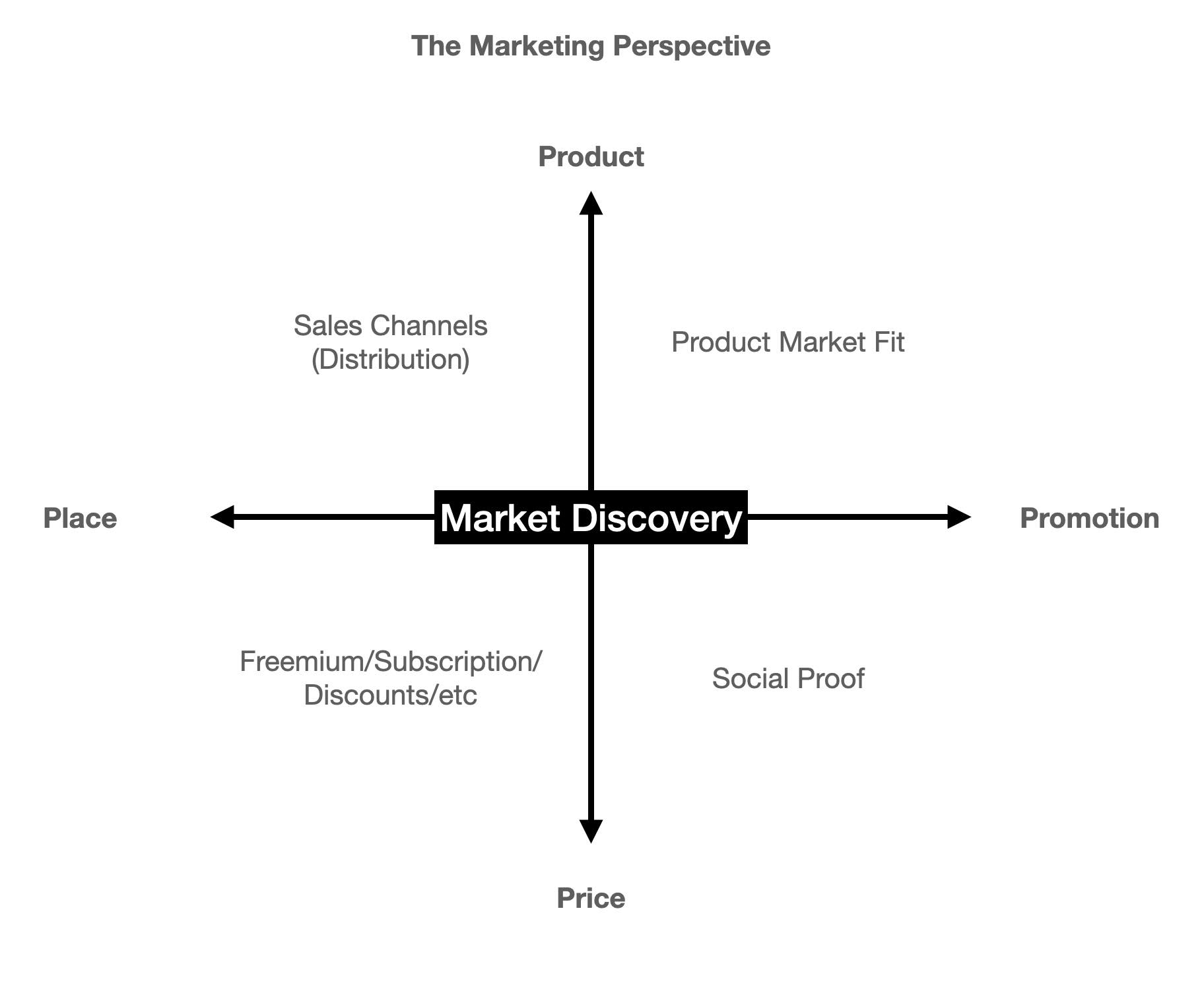
...looked more like the 2IC's
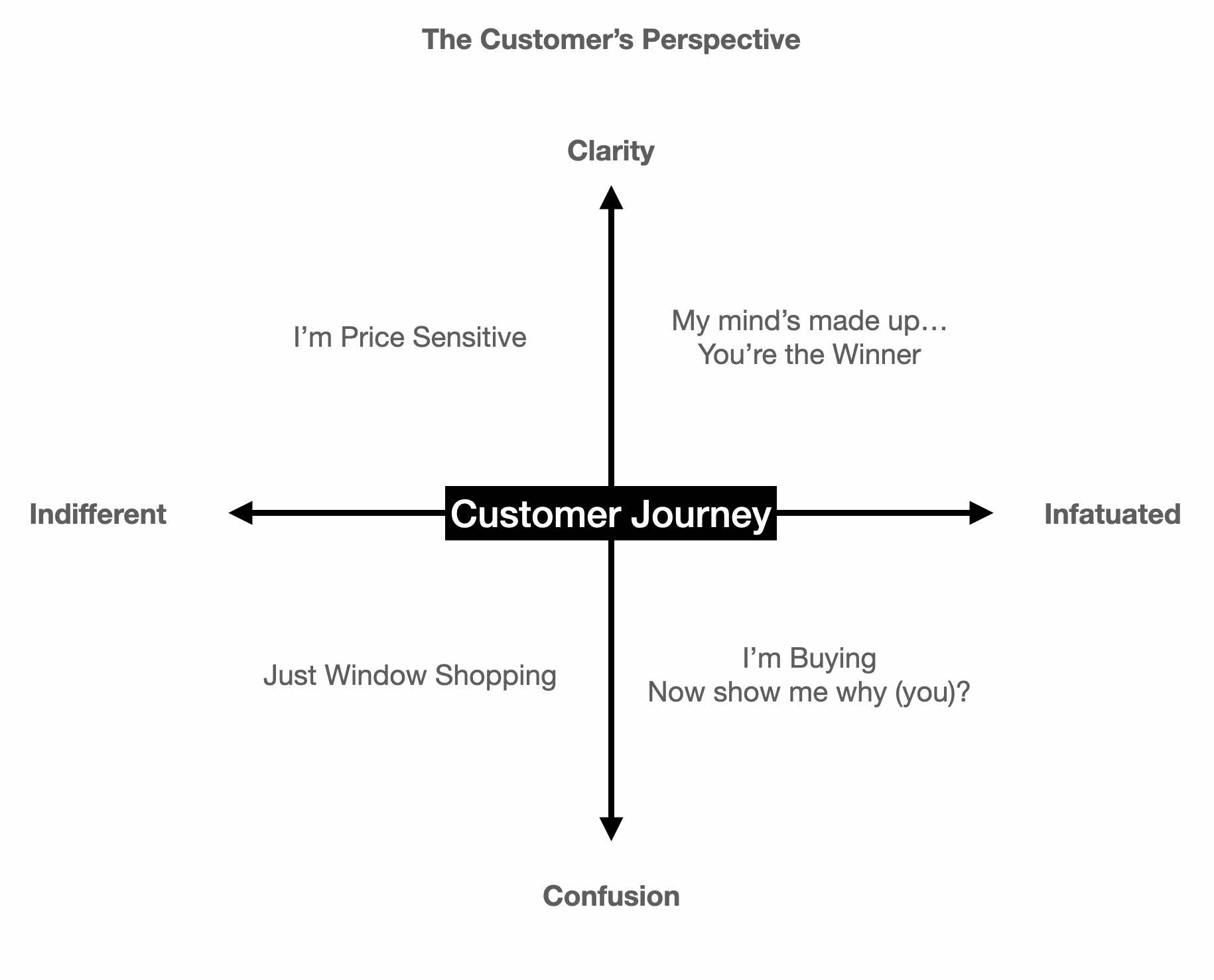
.and how would that fundamentally change the way we measure success in the world of marketing?
So let's embark on a quick of thought experiment
We'll begin with an idea called Phase Changers
So what is a phase change? and, why is it important?
In the world of Physics when water shifts from Ice/Soild to Water/Liquid To Steam/Gas it undertakes a what is described as a phase change
Either side of those phase changes is a steady state
It is either Ice/Solid, Water/Liquid or Steam/Gas
But the key observation here is it takes a change in energy to ignite this change in state
Now what if the same principle applies to marketing?
After all it takes investment. It takes effort. It takes creativity. To initiate a change in state to shift the market along the 'S Curve'
This is because the function of Marketing - or, more accurately, changing the customer's mind - is better understood as addressing the challenge of reducing friction in the market place
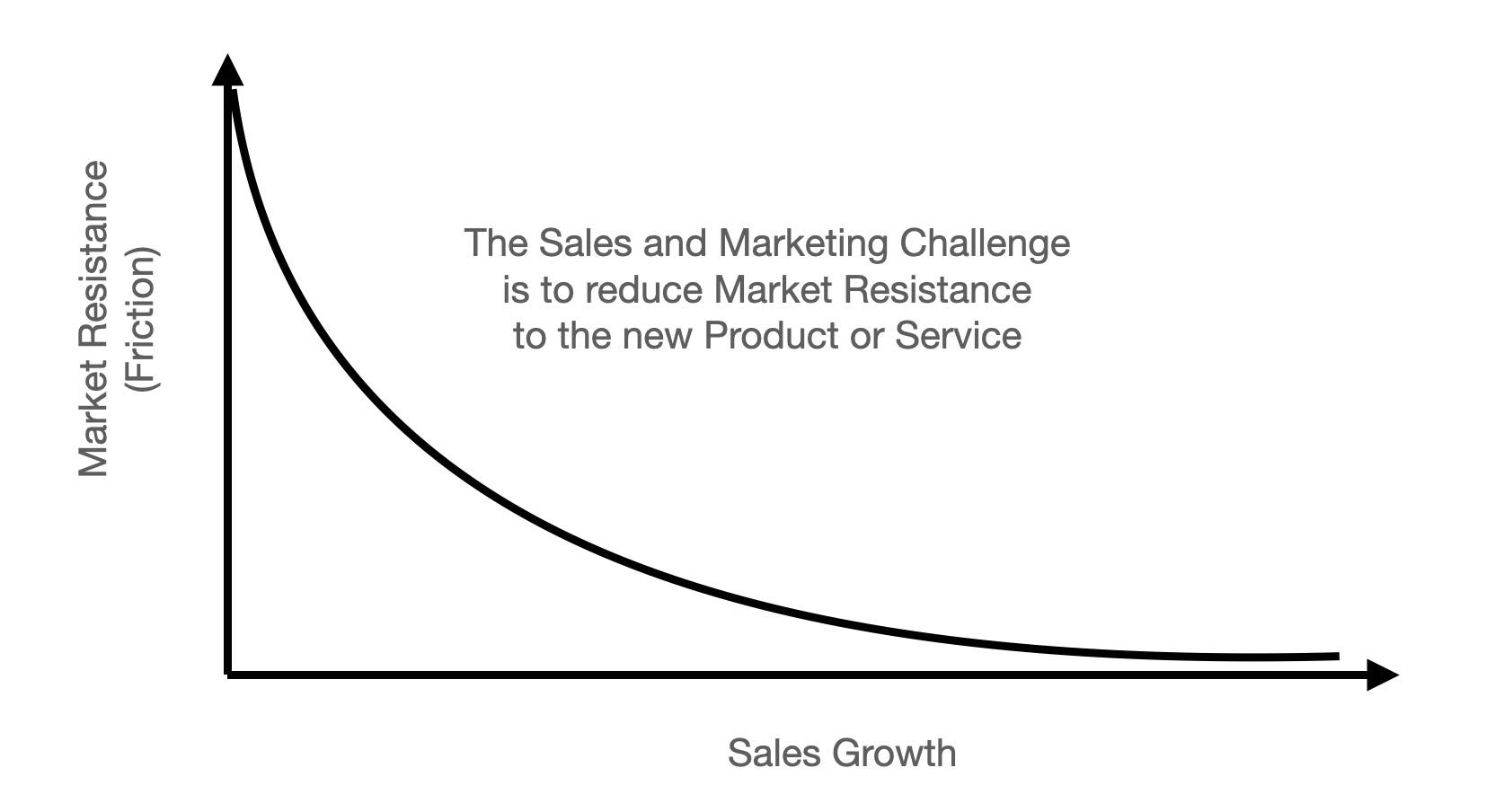
So the 'S Curve', rather than looking like this...
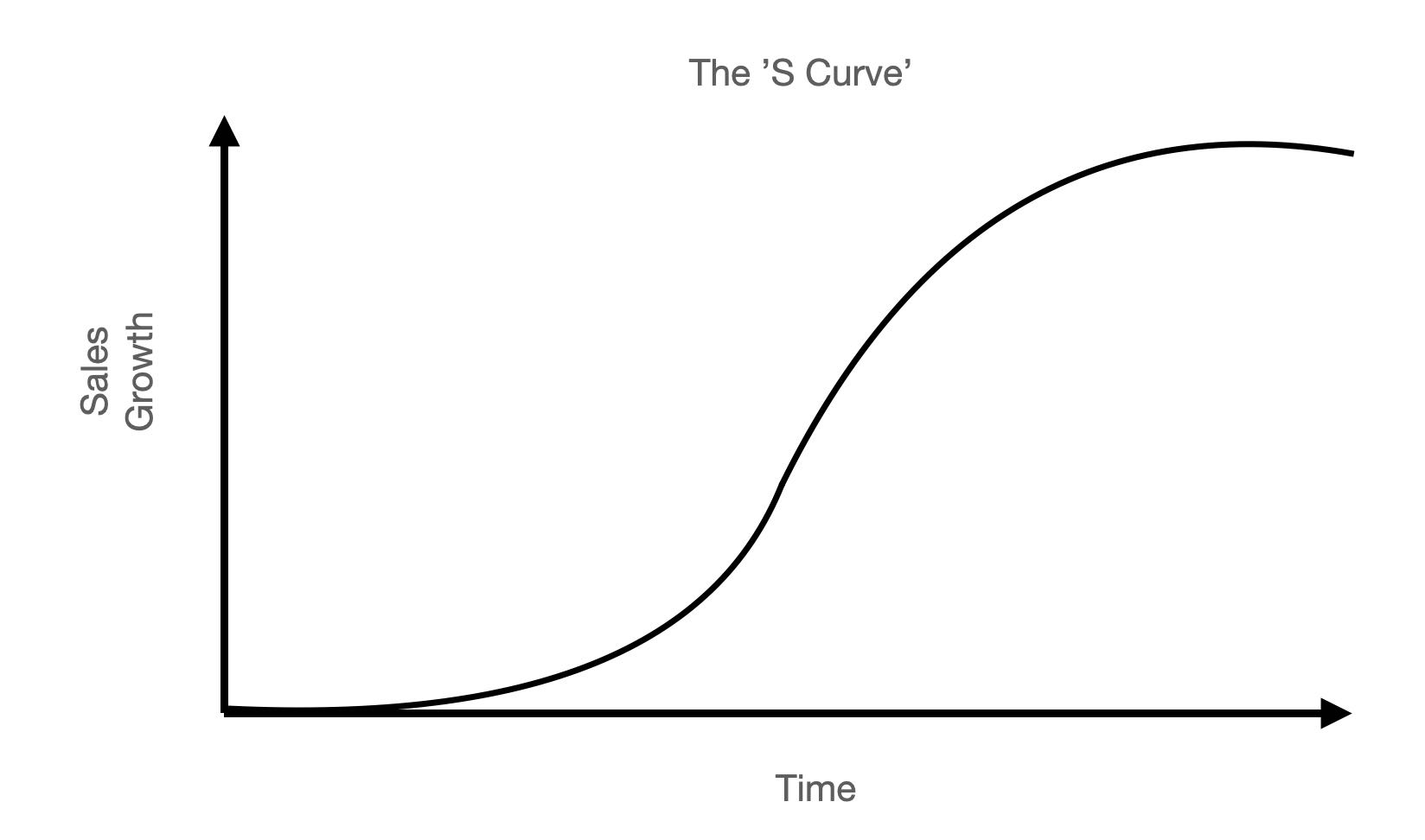
Is better undertsood as looking something more like this
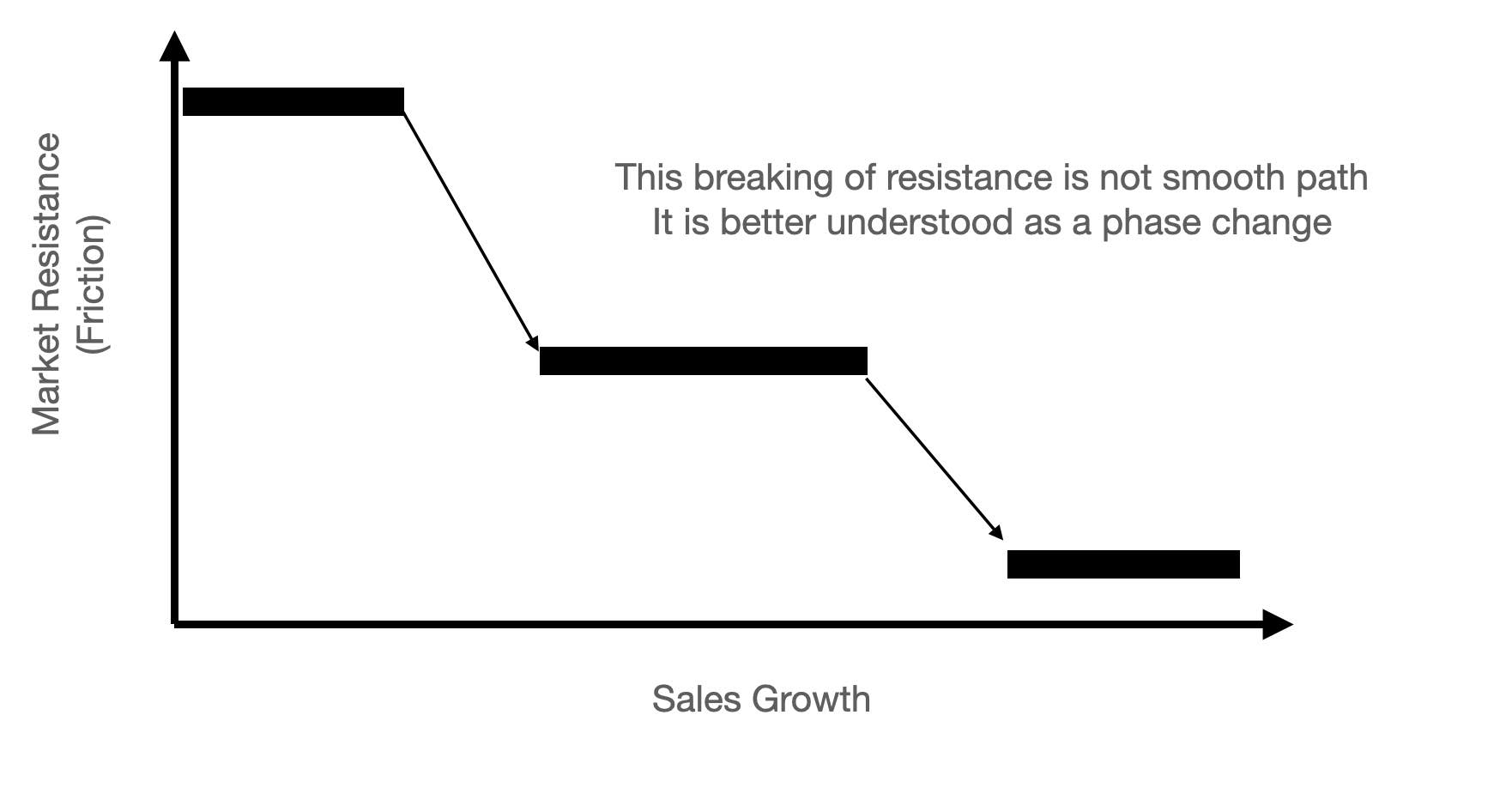
You might describe marketing's objective as decending the staircase of friction to achieve market pentration
Now this idea explains - or at the very least accomodates - what Geoffrey Moore described as 'Crossing the Chasm'
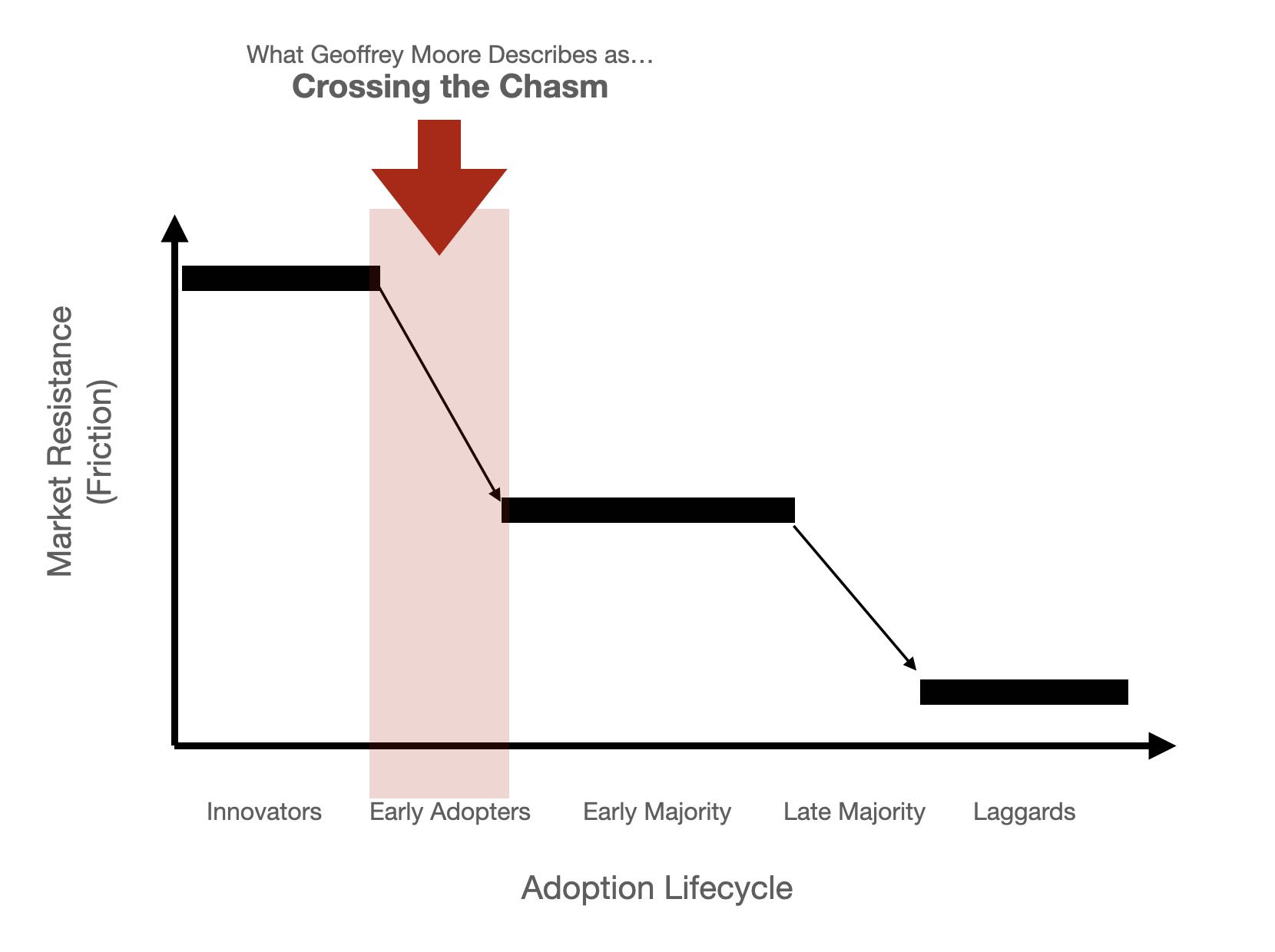
and suggests there are two overiding market strategies to deal with the challenge of market friction
Basically you are either in the business of removing friction (Distrupting the incumbents) or adding friction (Building a branded moat)
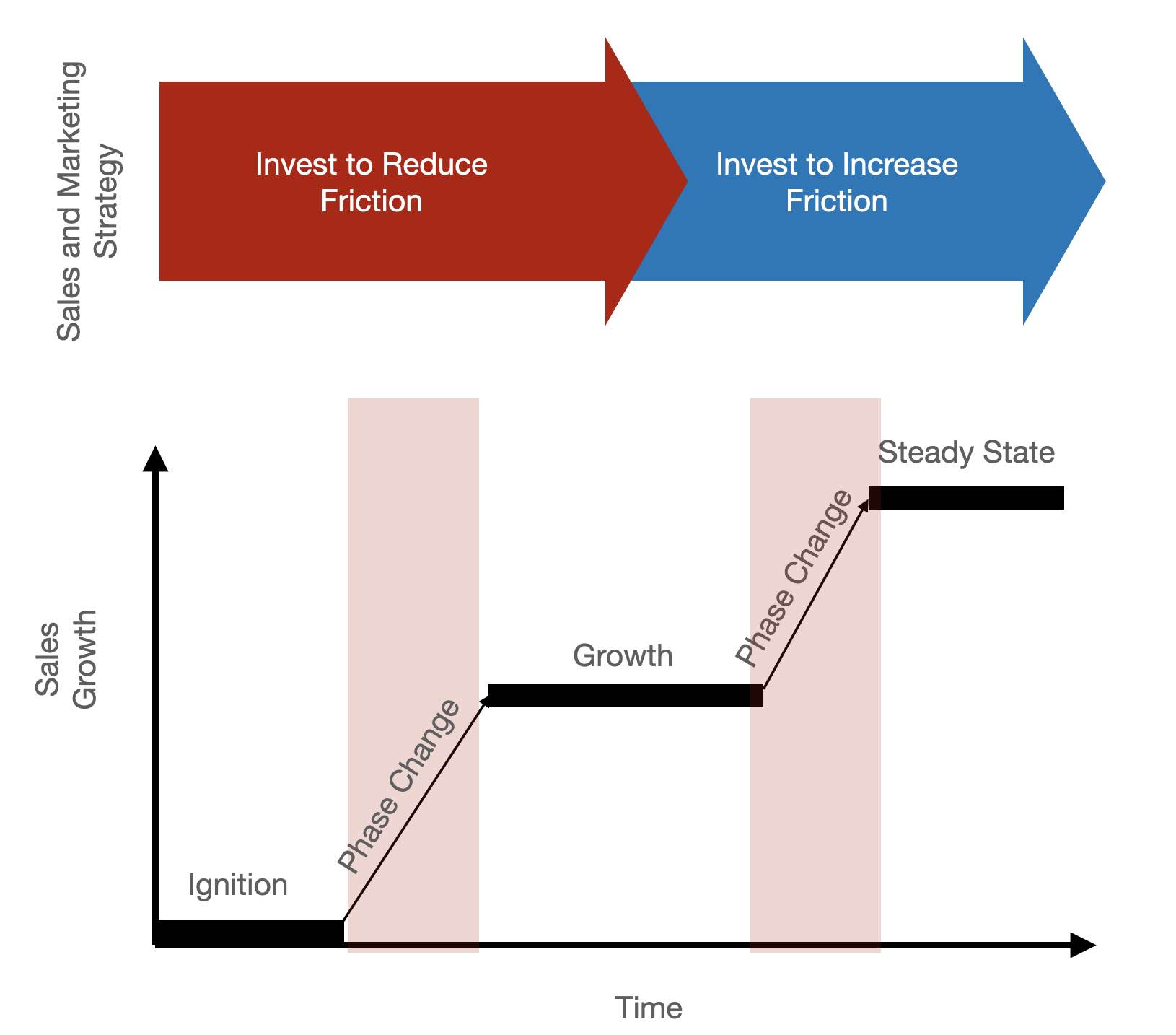
Which of course takes us back to the 'S Curve'
The key observation here being there are 3 steady state phases in the business of marketing
Each with its own unique challenges and opportunties
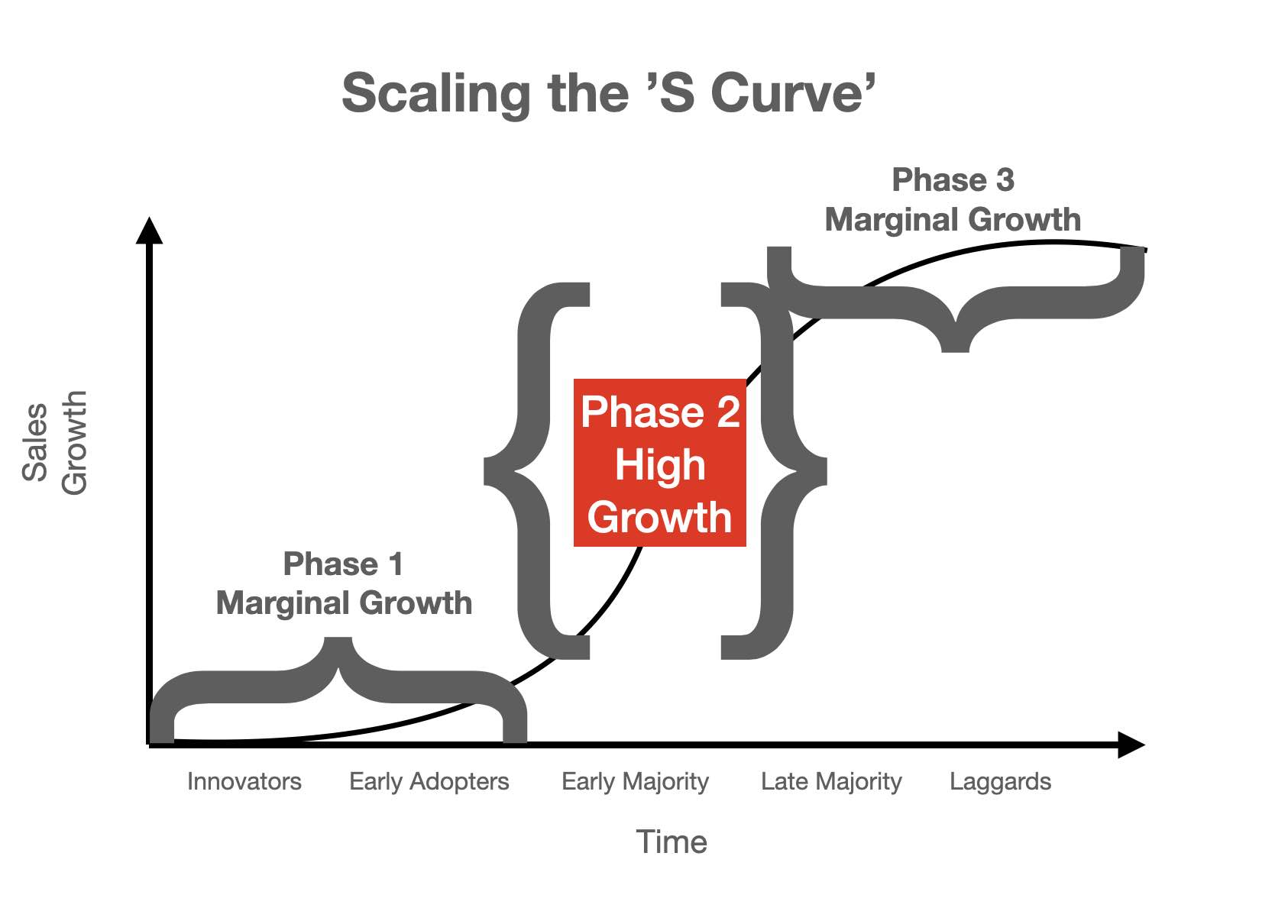
Each with its own career risk and rewards for the professional tasked with the challenge
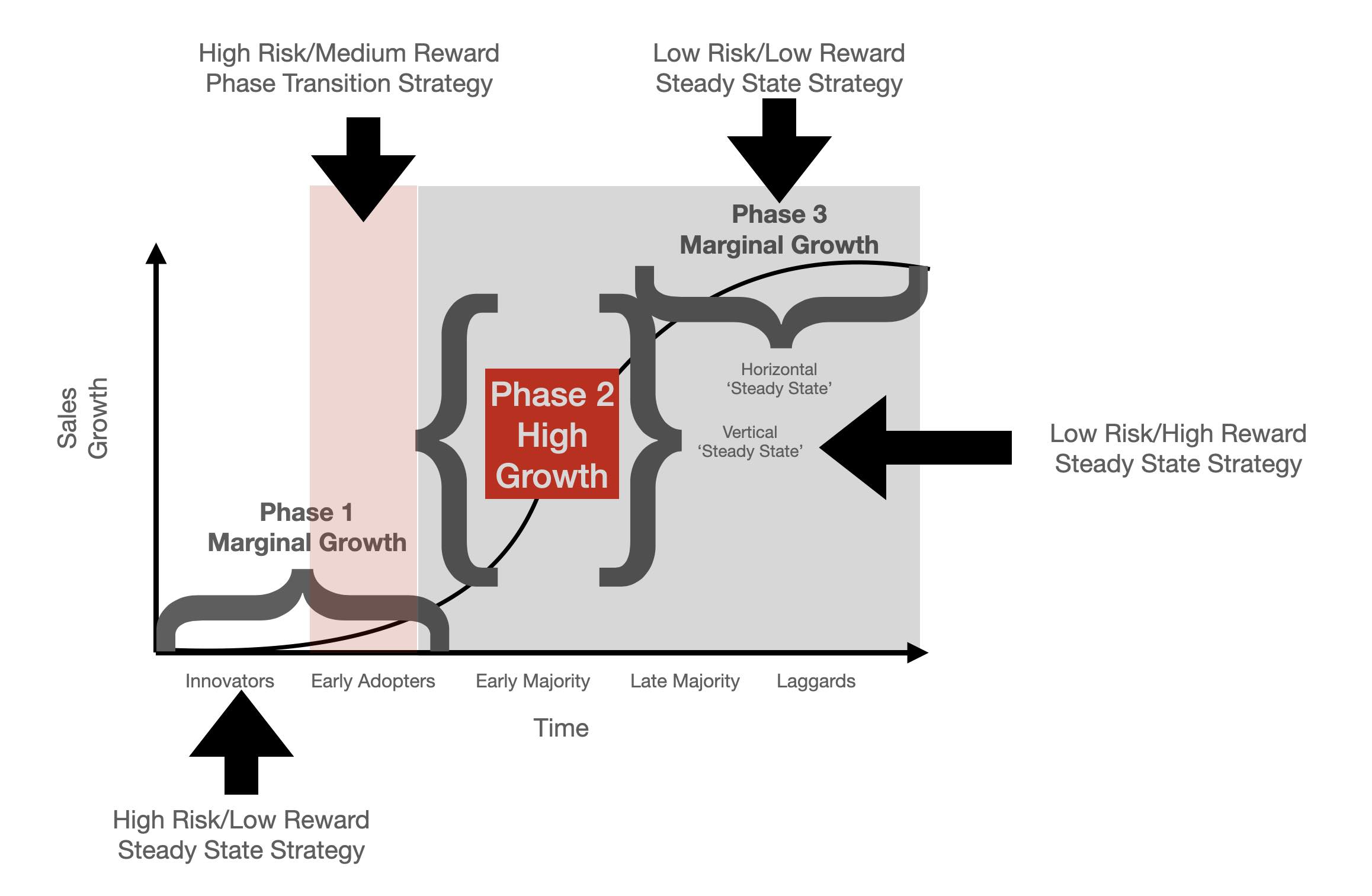
Because each phase requires a different skill set and dare I say a different kind of professional?
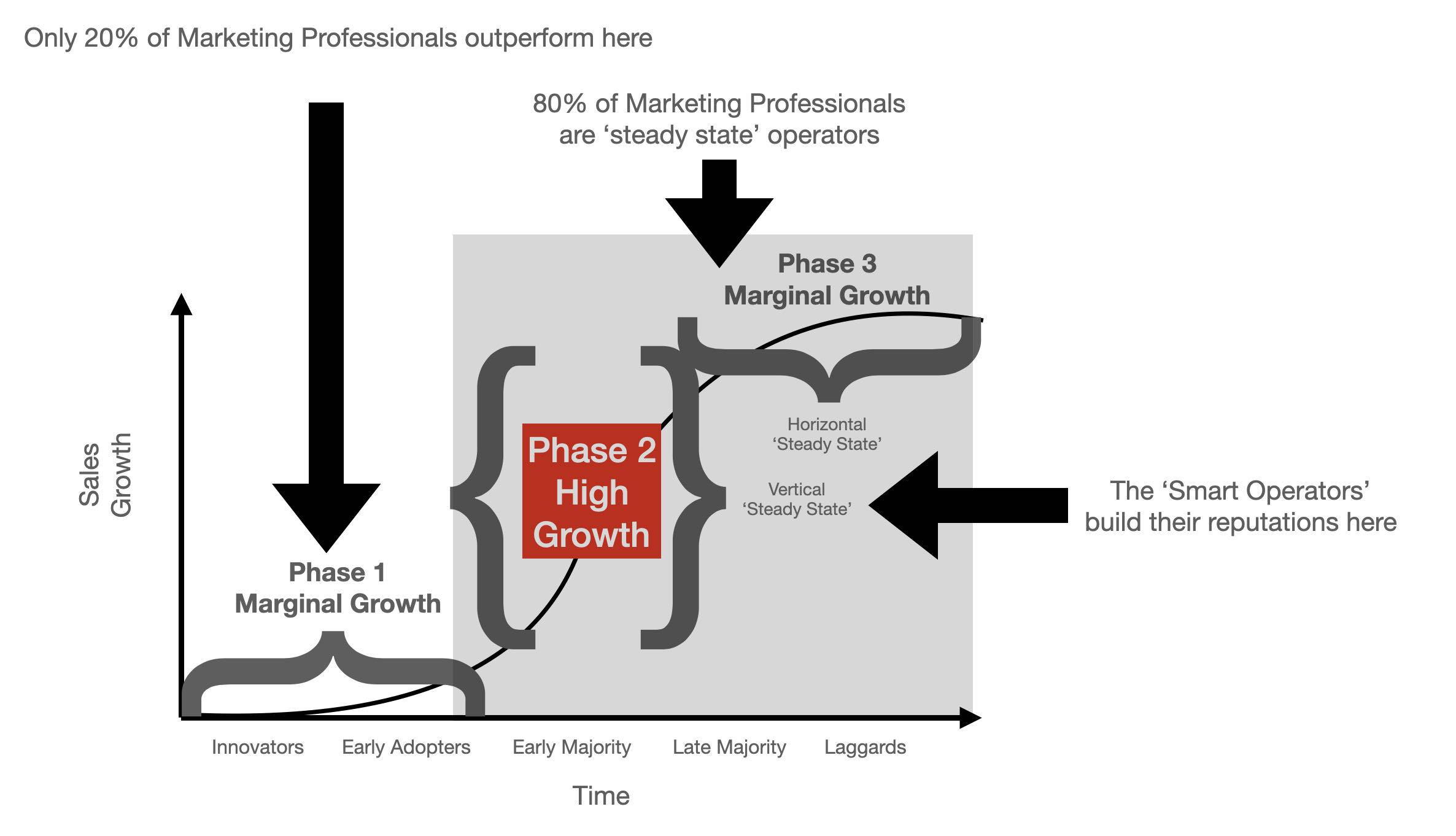
and this is why the 'Chasm Jumpers' are so rare
There is easier money and career gains to be made in managing steady state growth than experimenting with the catalysts the ignite the phase change
Those that do it are hooked on the thrill of ignition - of burning down the house - rather than the day to day challenge of maintaining the status quo
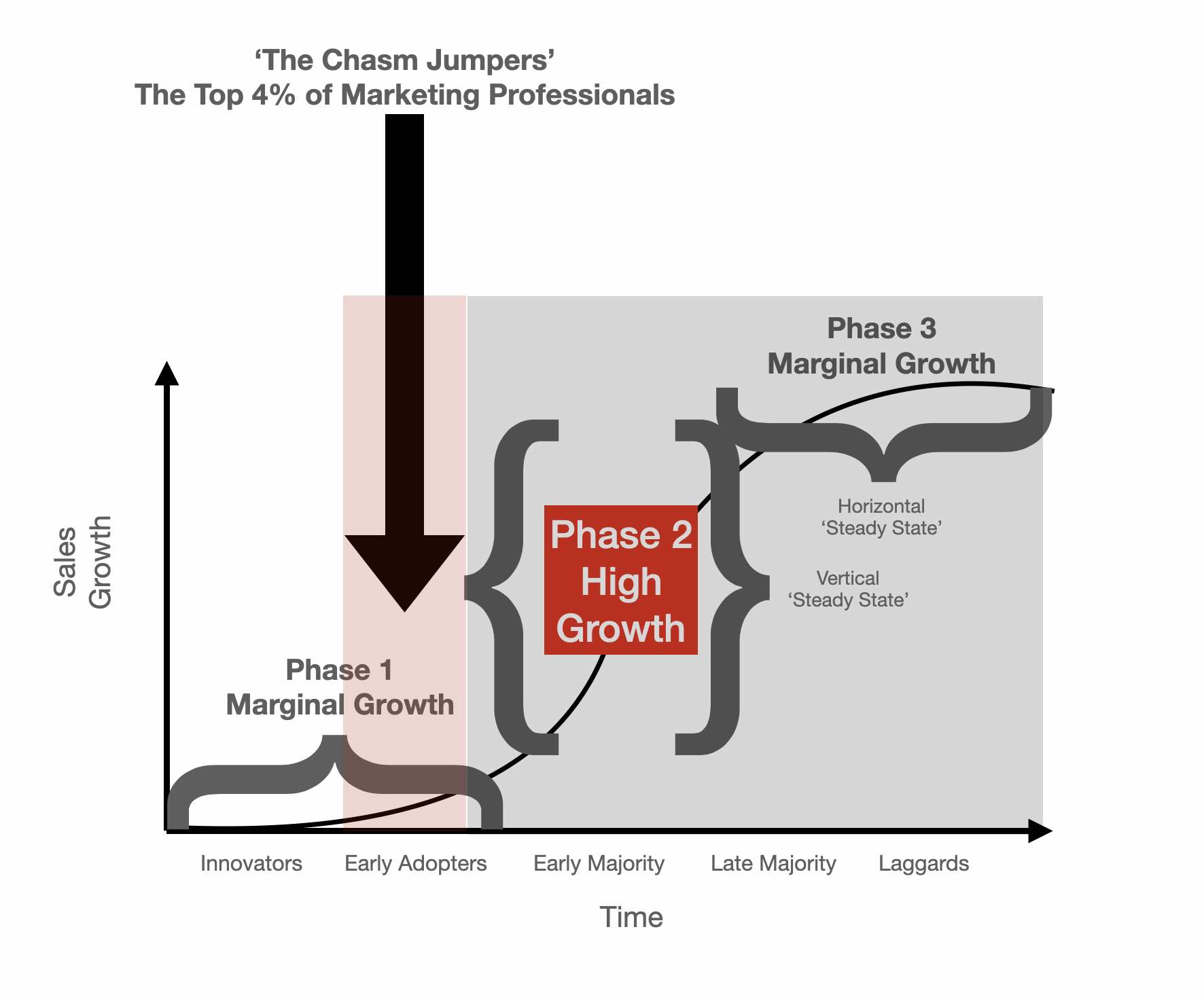
and perhaps this is why the average tenure of the CMO in an organisation undertaking the transformative challenge is - more often than not - so short
and so onto the big question... can we turn this insight into a formula that allows us to change the way we think about how we invest in marketing?
Good question
So let's take a stab at the answer
This is what I think the model looks like
As you can see the basic premise is the markeing mix evolves as you move through the changes of state
The key though is this idea that to initiate a phase change you need to invest in removing friction if you are to move beyond the steady state baseline
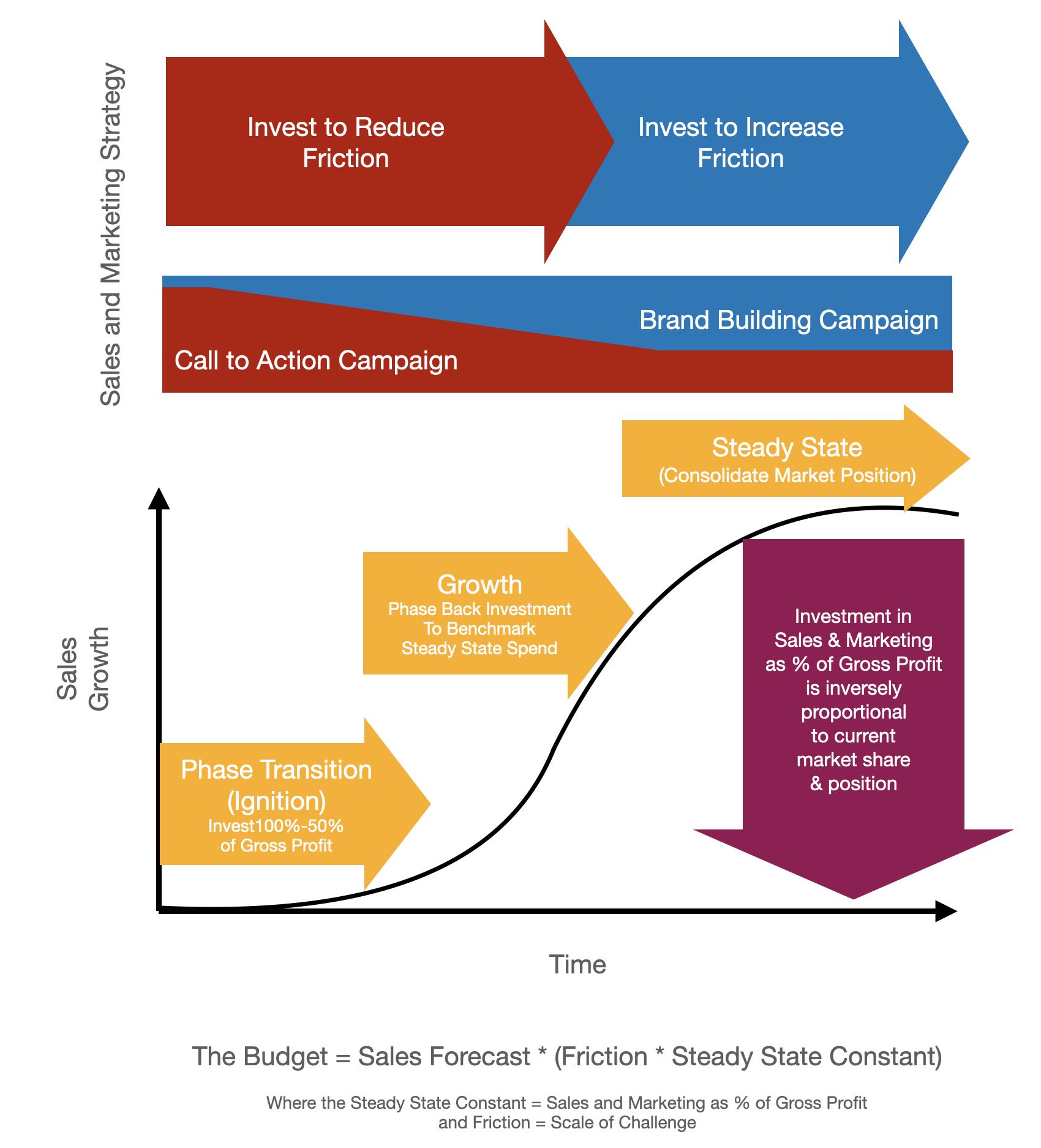
Now let's map out the challenge using 2 axis - Change vs Steady State and B2B vs DTC
The assumption being that any marketing challenge sits somewhere in that 2x2 matrix
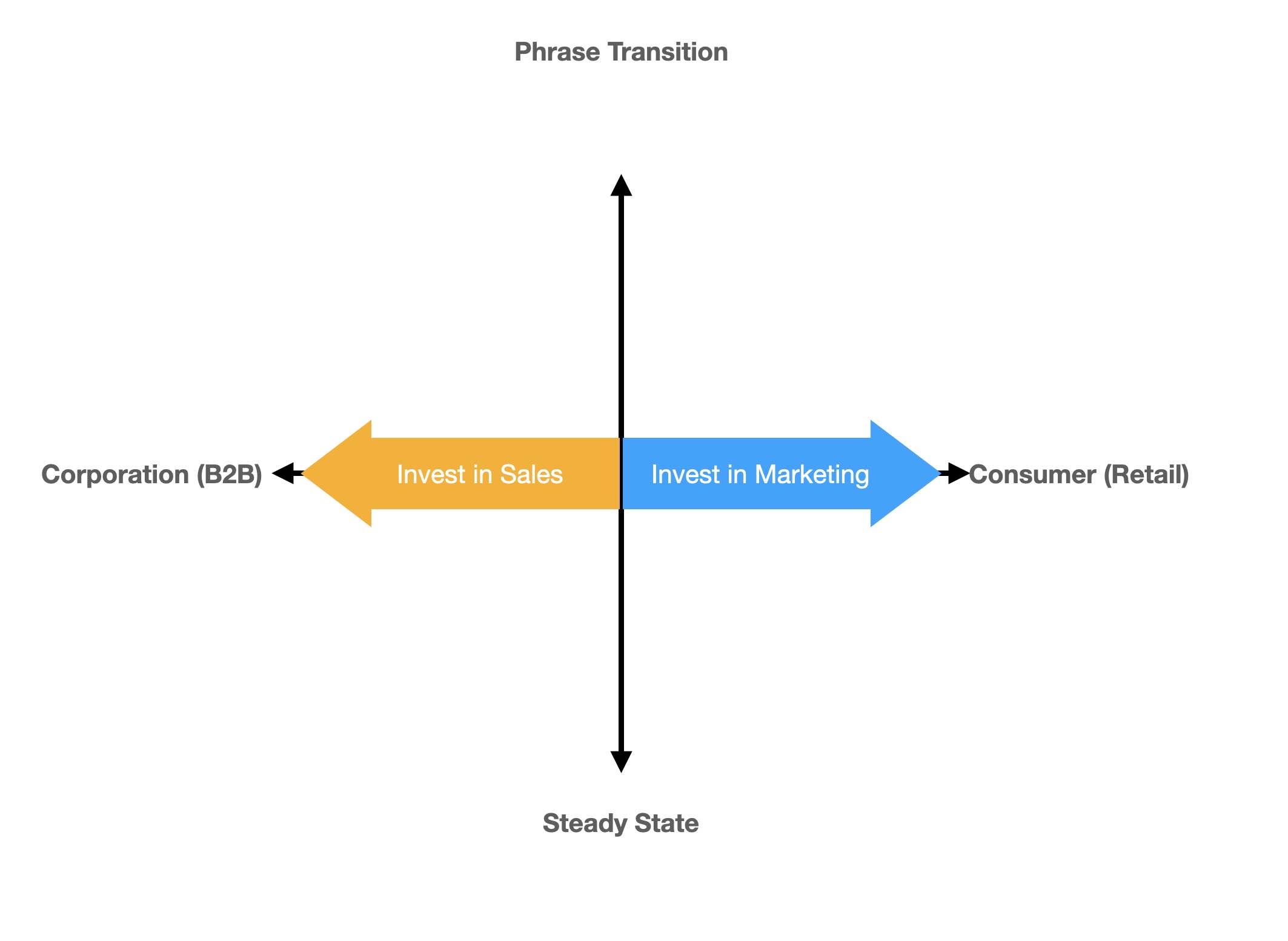
The key observation being large corporate accounts are better served by rainmakers than marketing campaigns
While retail is best served by mass media and target marketing
SME are to be found somewhere inbetween
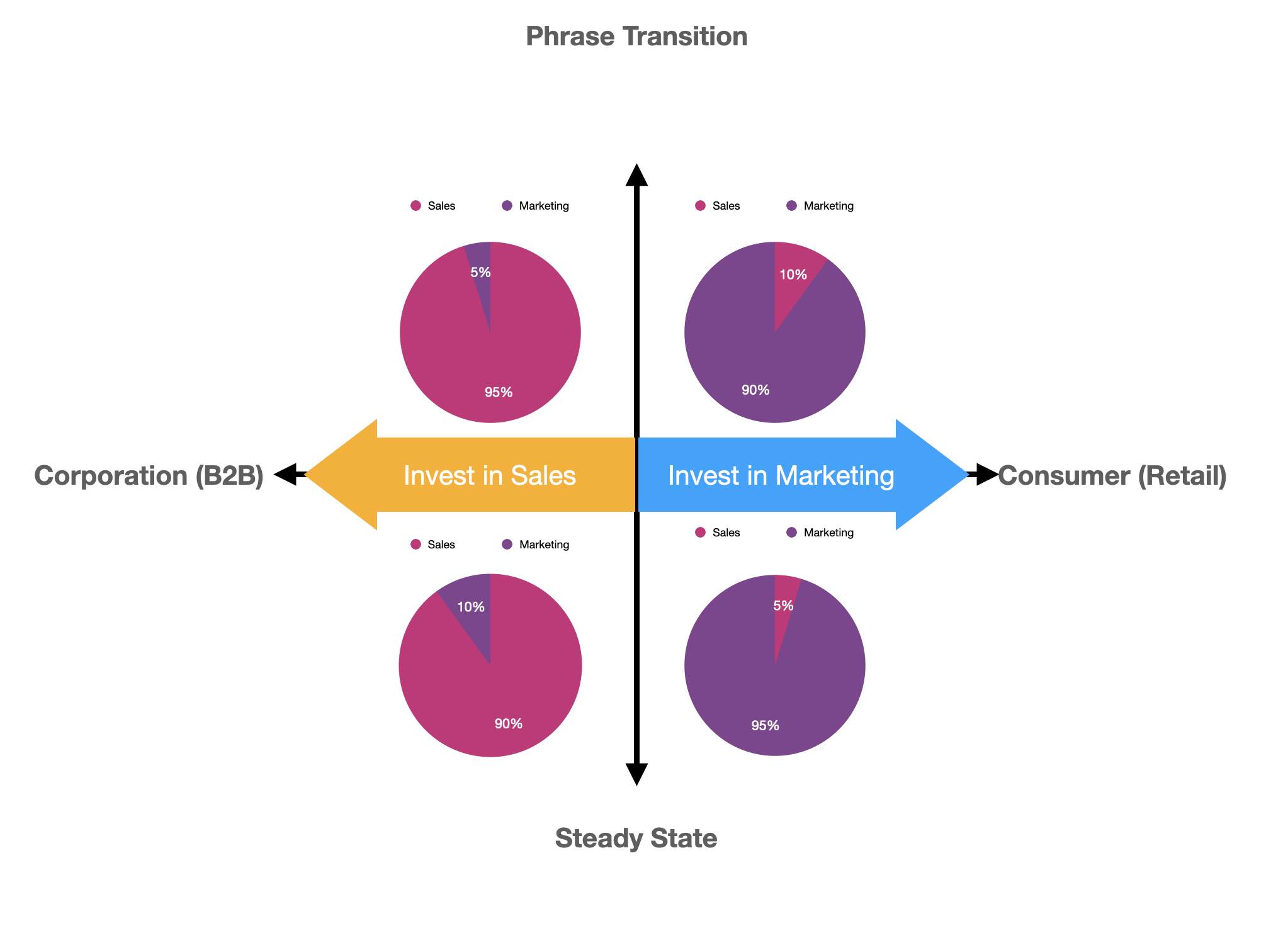
The task is threefold.
Firstly: Identify where you sit on the horizonal axis
Second: Identify your steady state benchmark spend on the vertical axis
Three: Calculate what is required to ignite a phase change in customer/market behaviour
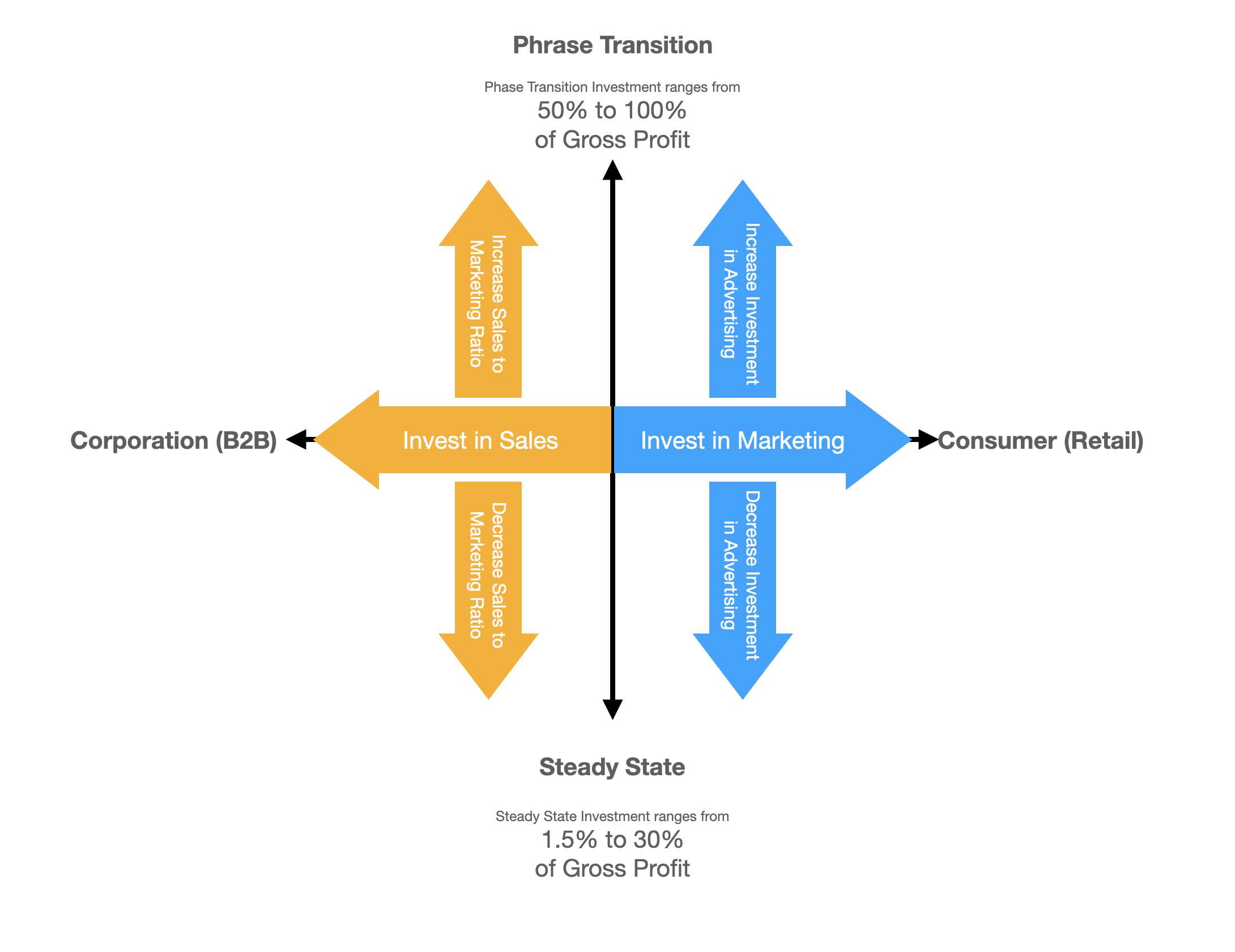
So the composite model looks something like this
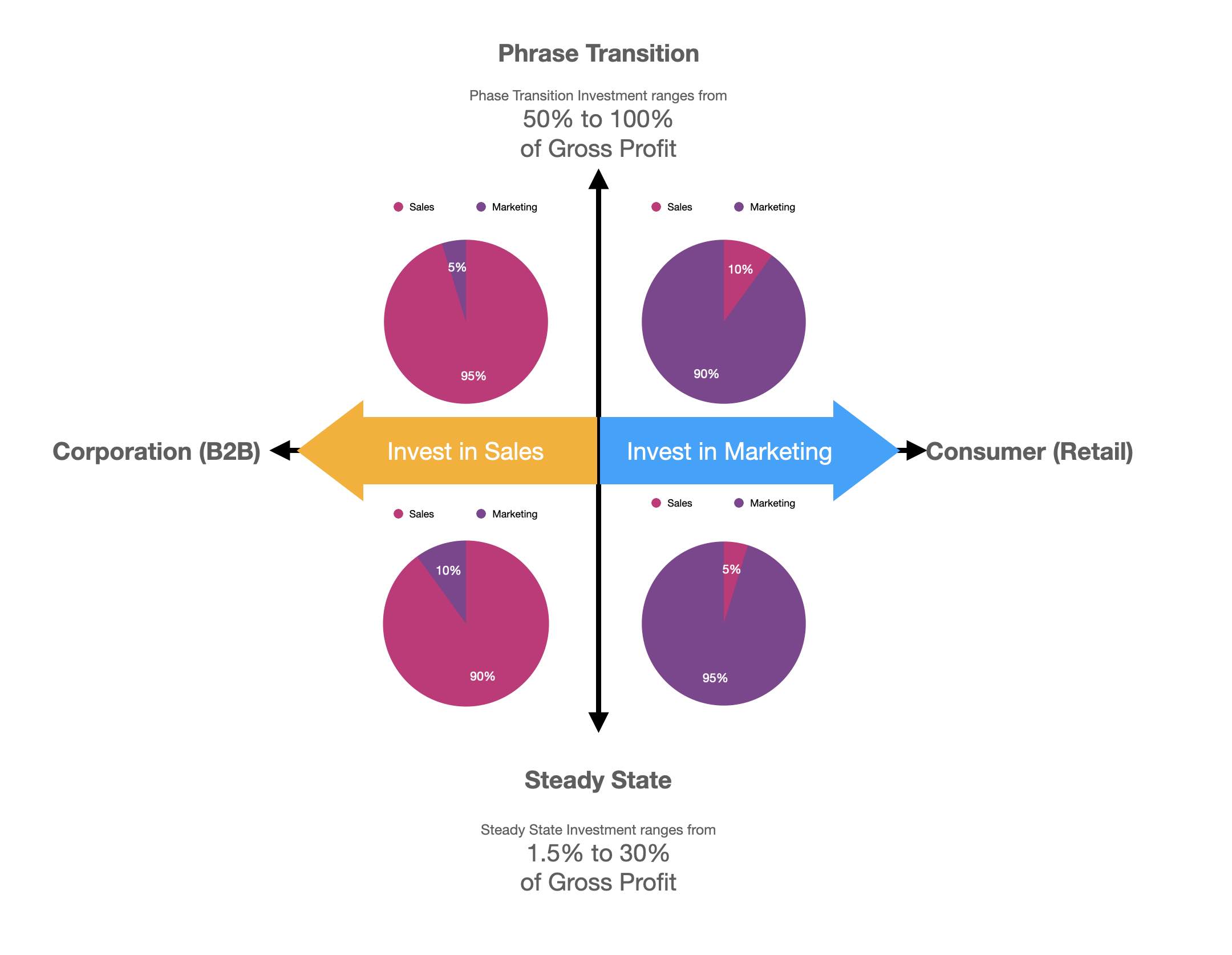
and if we begin to populate the landscape we can get some idea of the steady state benchmarks for the incumbent market leaders and the variable cost associated with funding the phase change for the disrupters
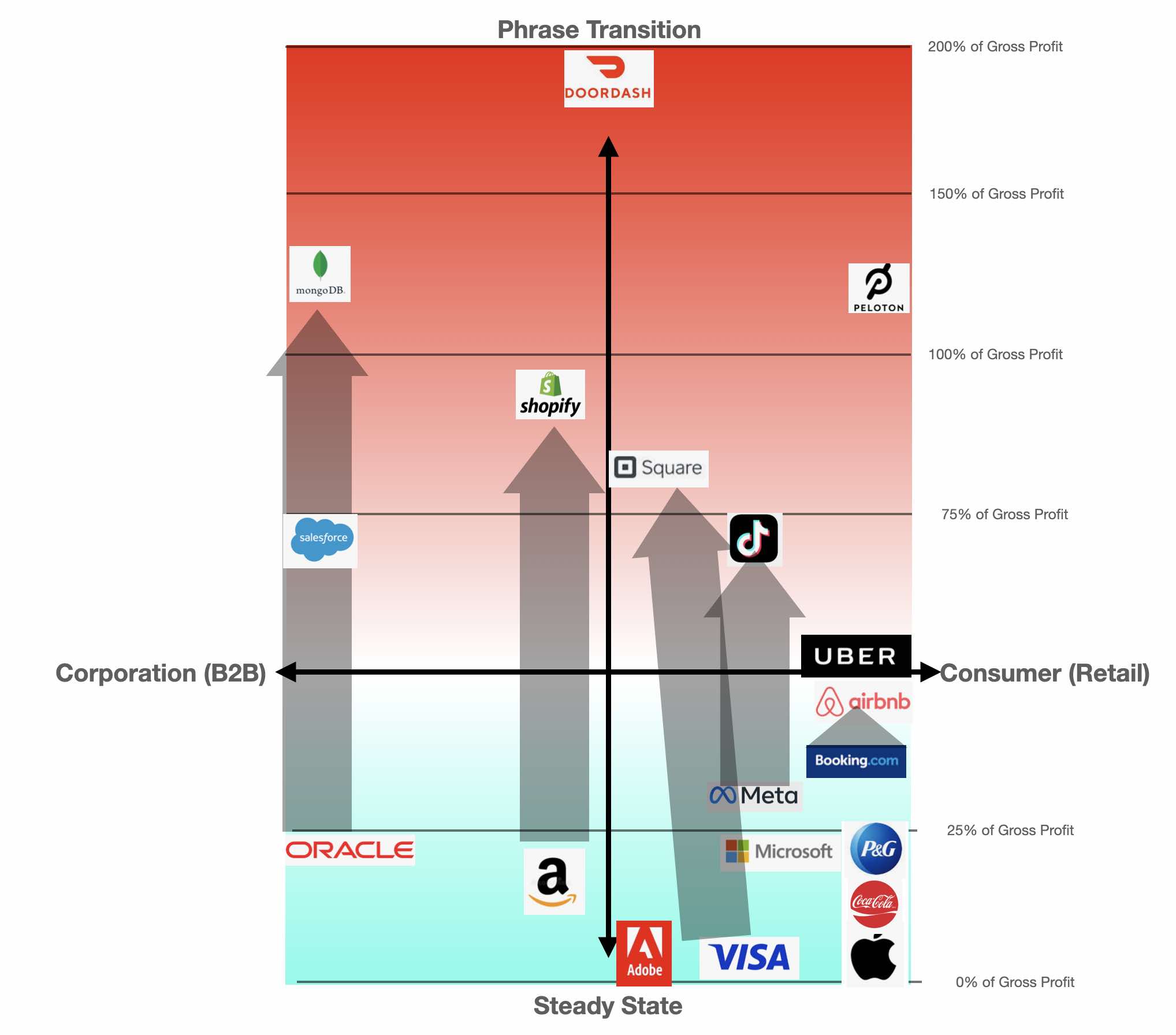
At a more granular level we can note that the iPod phase change increased Apple's marketing investment by a factor of 2x circa 2001
Closing thoughts?
Look we have only just scratched the surface here... but it's enough to spark a discussion about the realities of estimating the marketing mix for both incumbents and disruptors
It also provides a 'rule of thummb' for investors seeking to identify which Unicorns will be unable to feed themselves once they have IPO'd
I suspect the steady state constant is a product/function of brand equity
Meanwhile the friction variable is basically a measure of the energy required to move to a new phase... but this in turn is linked to how distant the new market is from the brand's current position
This brings up questions of brand elasticity and the value of investing in expanding a brand's elasticity
e.g. How valuable is Google's brand in markets like confectionary, beverages or farm machinary compared to smart wearables, data analytics and CRM
The other observation I want to make is - assuming the equation is valid - does it work on a granular level, beyond the bundling of products and services under an annual marketing budget, into the realm of campaign planning?
I supect the answer lays in rethinking the 2IC matrix as a fitness landscape populated by point attractors that induce movement and/or bring the customer to rest

But more on that idea another day...
Part 2
In the first post we explored the idea of marketing being about removing or increasing friction

Now I want to explore an observation:
In my experience any idiot can count the beans but it takes real genius to build a brand... So why do so many marketing managers waste their days counting beans?
All the indicators are marketing today is fundamentally about portfolio management
You could say it's about managing a portfolio of volatile growth experiments
The good news is the world of investment banking, hedge funds, private equity and venture capital shows us there are a myriad of ways to manage a portfolio to obtain alpha returns
There is everything from the buy and hold strategies of the value investor through to the frenetic algorithmic trading of the day trader
With the 60/40 branding vs performance model of the marketing mix being the equivilent of the mainsteam equities vs bonds 'passive' benchmark
It's just a question of deciding what style suits your investment thesis, doing the research and executing on the model
But more on that idea another day...
The core metric driving marketing spend today is ROI - Return on Investment
and it comes in many forms e.g. ROAS - Return on Advertising Spend being the nano version of this metric promoted by MarTEch vendors, RMI - Return on Marketing Investment
Championed by the managment consulting profession it is a metric imposed by the office of the CFO on the world of marketing
In truth it is an metric Investment Portfolio Managers employ to describe their performance - and again it comes in many forms e.g. MOIC (Multiple on Invested Capital)
Essentially it is the metric for measuring the cash on cash return on the money you invest
The golden rule for maximising your ROI is buy low sell high
But the problem with ROI in the context of Sales and Marketing is simply this
When you buy an ad or pay a salesperson to manage the account you don't actually buy it to sell it to the 'greater fool' sometime in the future
So it is fundamentally the wrong way of thinking about why you have bought the ad in the first place
It also introduces unnecessary volatility into the growth model (but more on that later)
Employing ROI as a KPI totally bypasses the most obvious question: Does spending more on sales and marketing = more growth? (and Vice Versa)
As you can see in the charts below the answer is generally yes
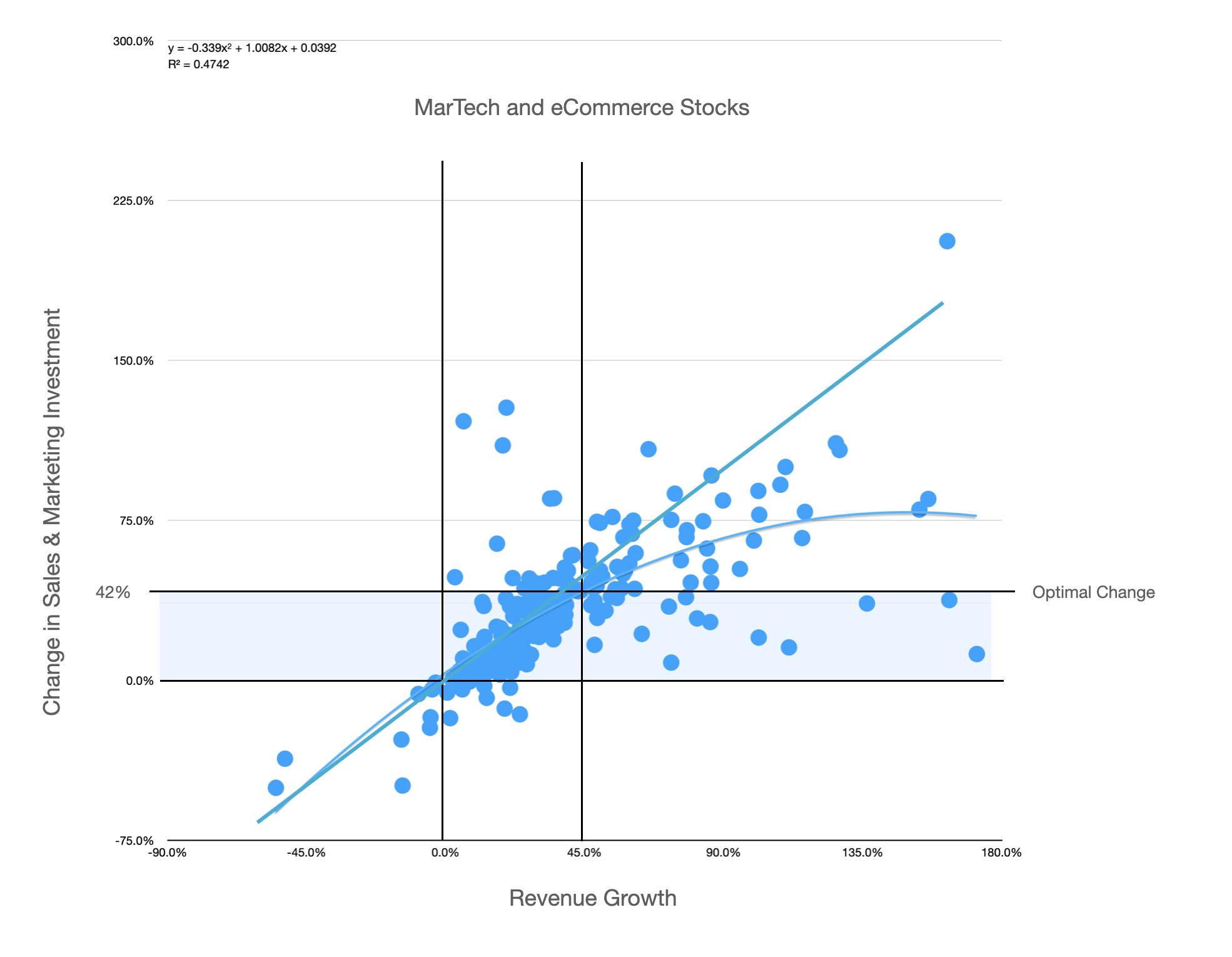
and the same applies to established consumer brands
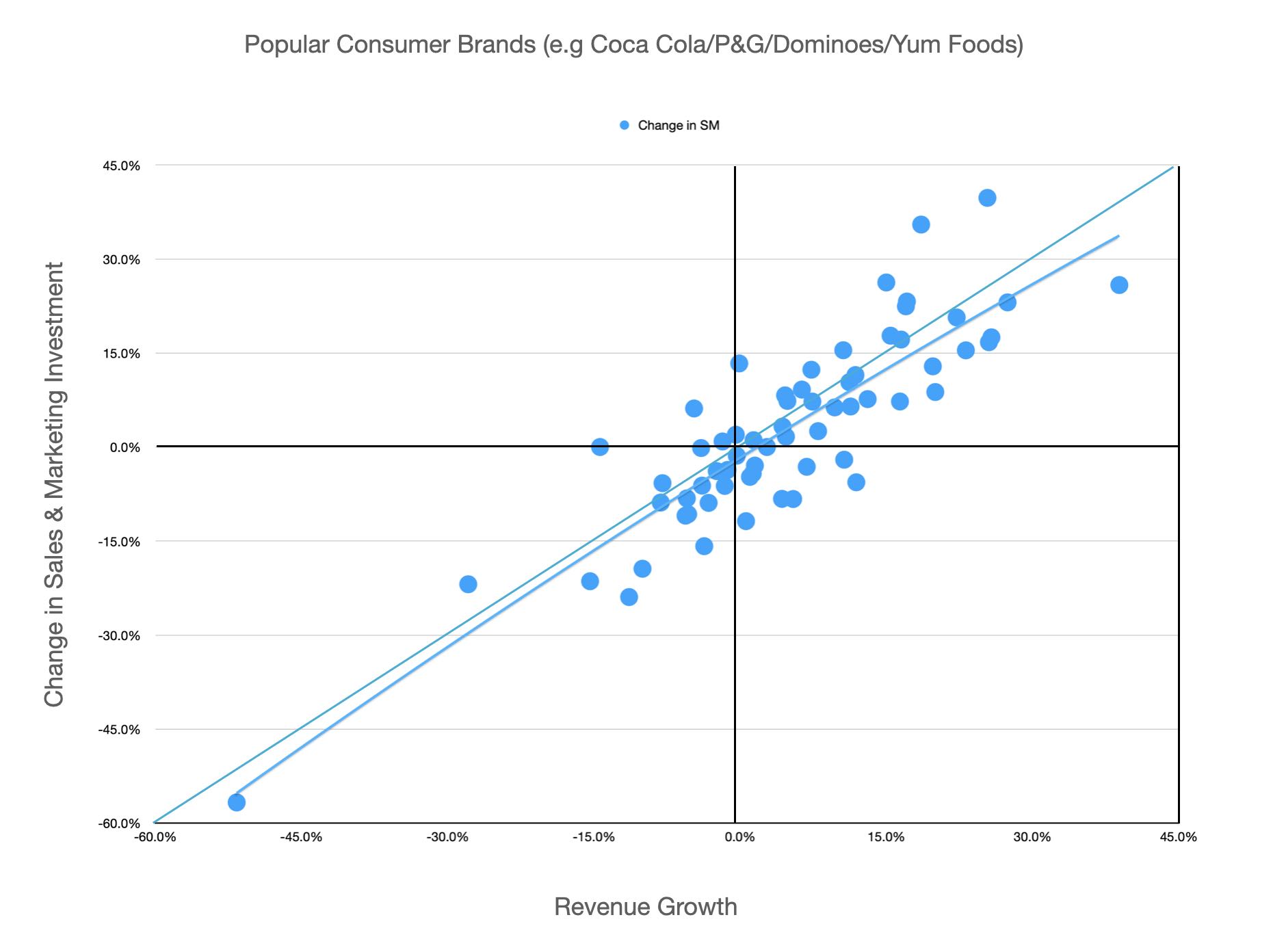
Spend more = grow more... Spend less = grow less
Now let's take a look at the ROI spread on this dataset
These 3 charts dissect the spread into 3 distinct layers of ROI based on the change in Sales and Marketing Investment (Year on Year)
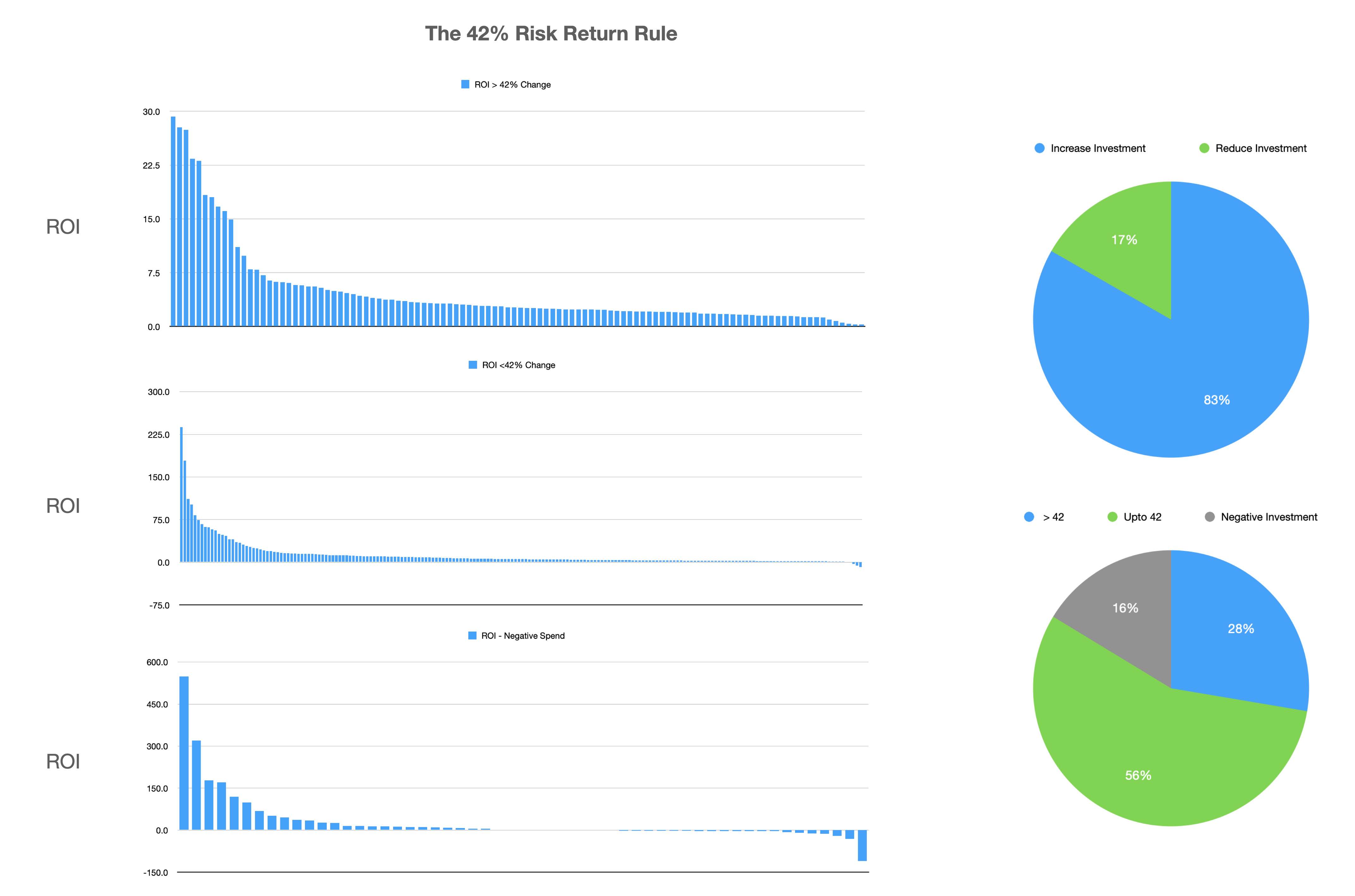
As you can see. As the spend decreases and trends towards negative the ROI becomes more volatile
The ROI numbers become increasing elastic - delivering bigger gains and bigger losses
Breakdown the sample further and you'll discover the sweet spot in the equation appears to be a 15%-30% increase in Sales and Marketing
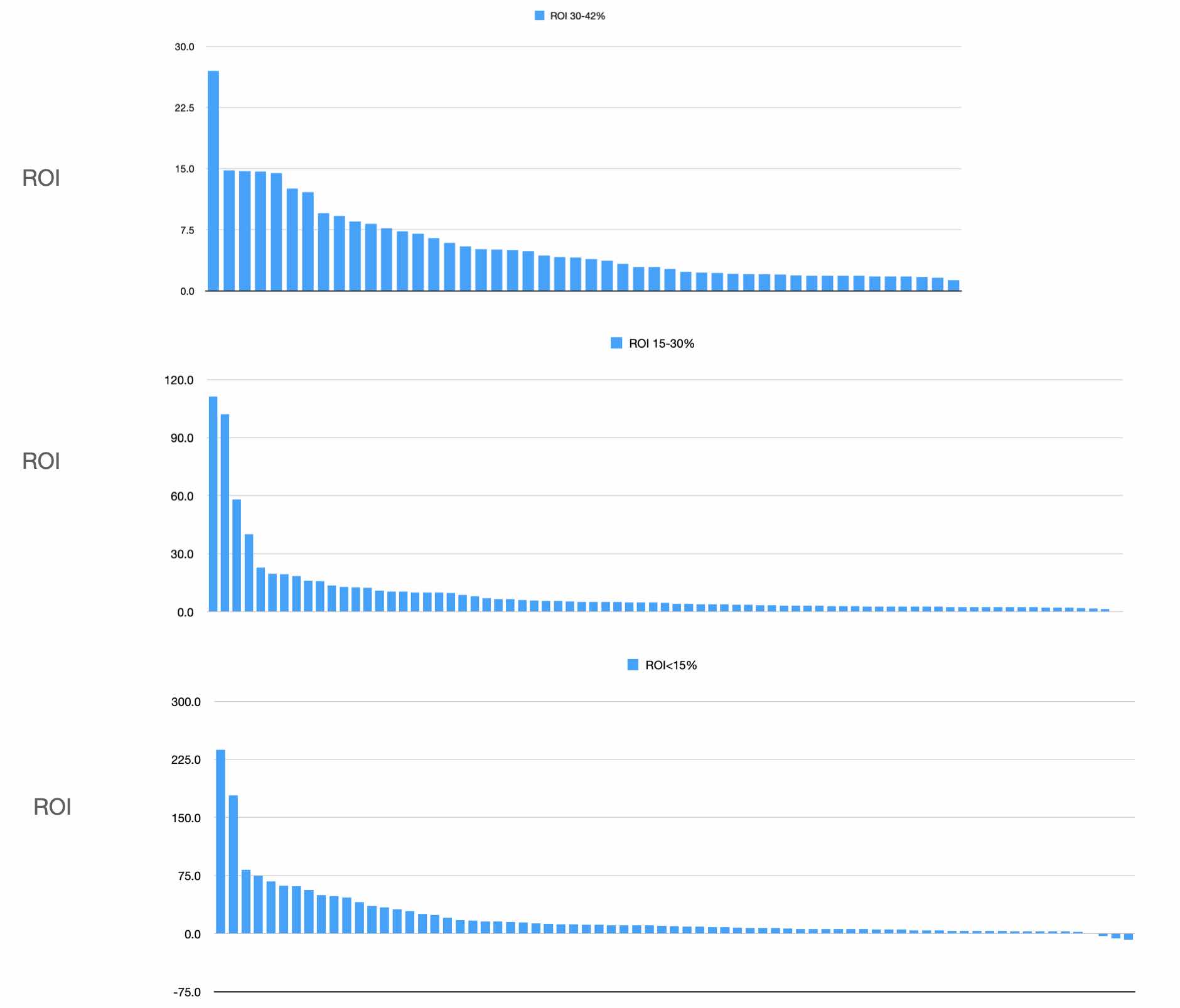
Understand this and you are now aware of the limitations of ROI as a target metric for forecasting revenue growth
Any discussion about ROI should be framed within the context of implied volatility of adopting the target based on the change in Sales and Market investment
and this raises the question: Is there a better target management metric than ROI?
Well let's try this idea...
What happens when we revalue the ROI target to accomodate the primary function of the investment (in sales & marketing) ie. growth
The new formula being ROGI(x)=ROI(x)*Revenue Growth(%)
Well we discover this...
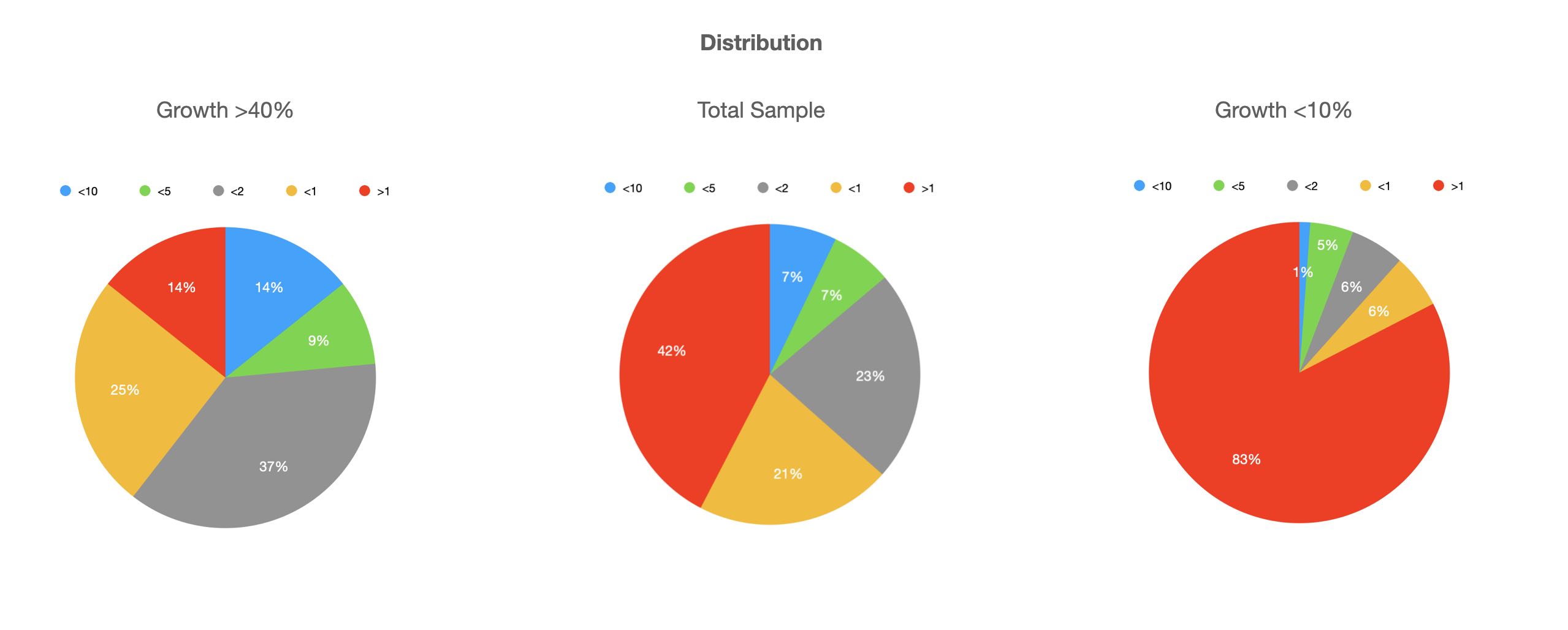
and, assuming our benchmark target to be 1x, we discover that an investment in Growth outperforms the average on an adjusted basis
and this in turn suggests the ROGI benchmark should reflect the relative position of the business or product within the business or product lifecycle
Which in turn provides us with some viibility of the investment required to overcome market friction/inertia
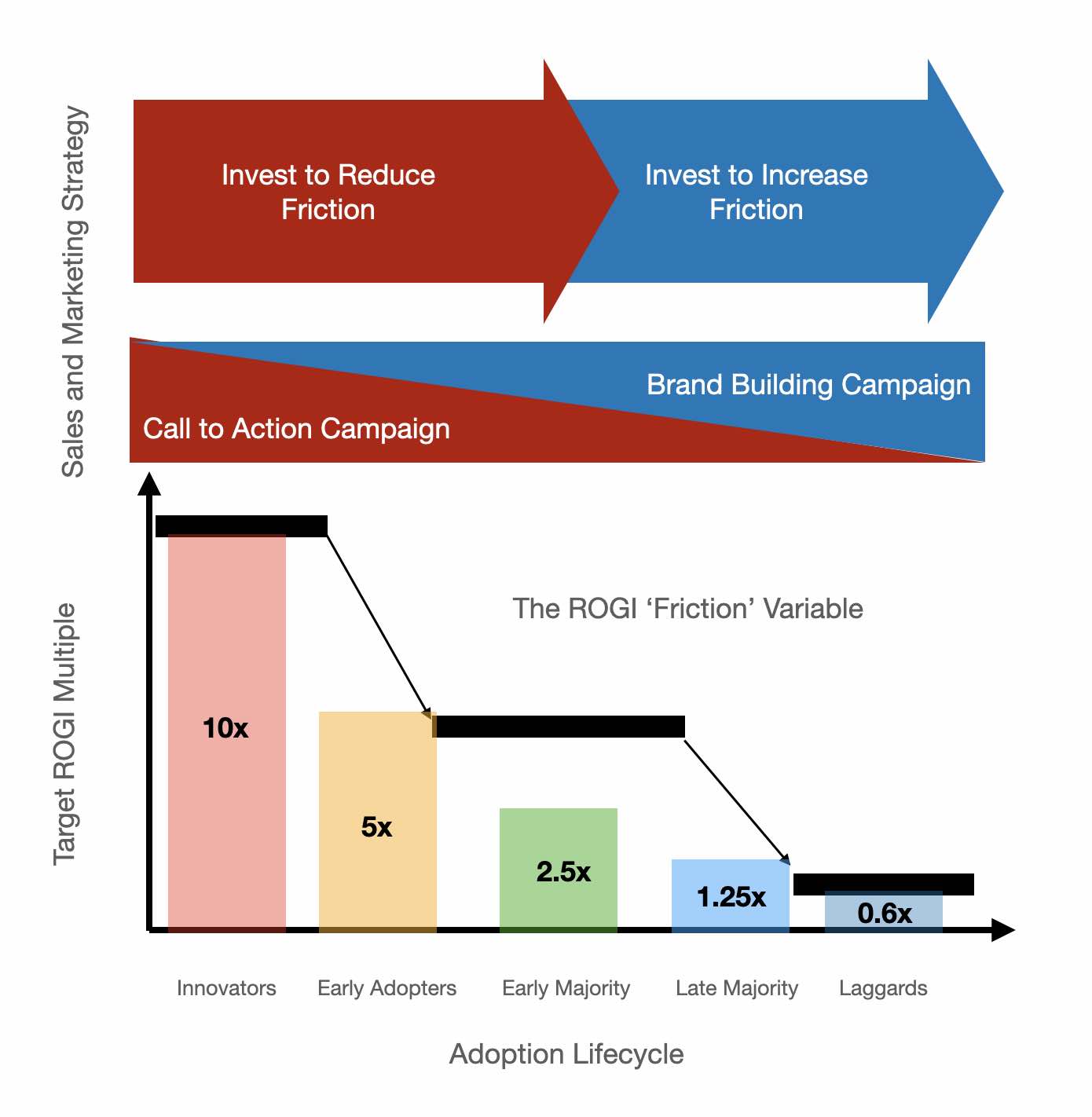
Can we validate this idea?
Well let's see what happens when we map four of the Dot Com winners against the model
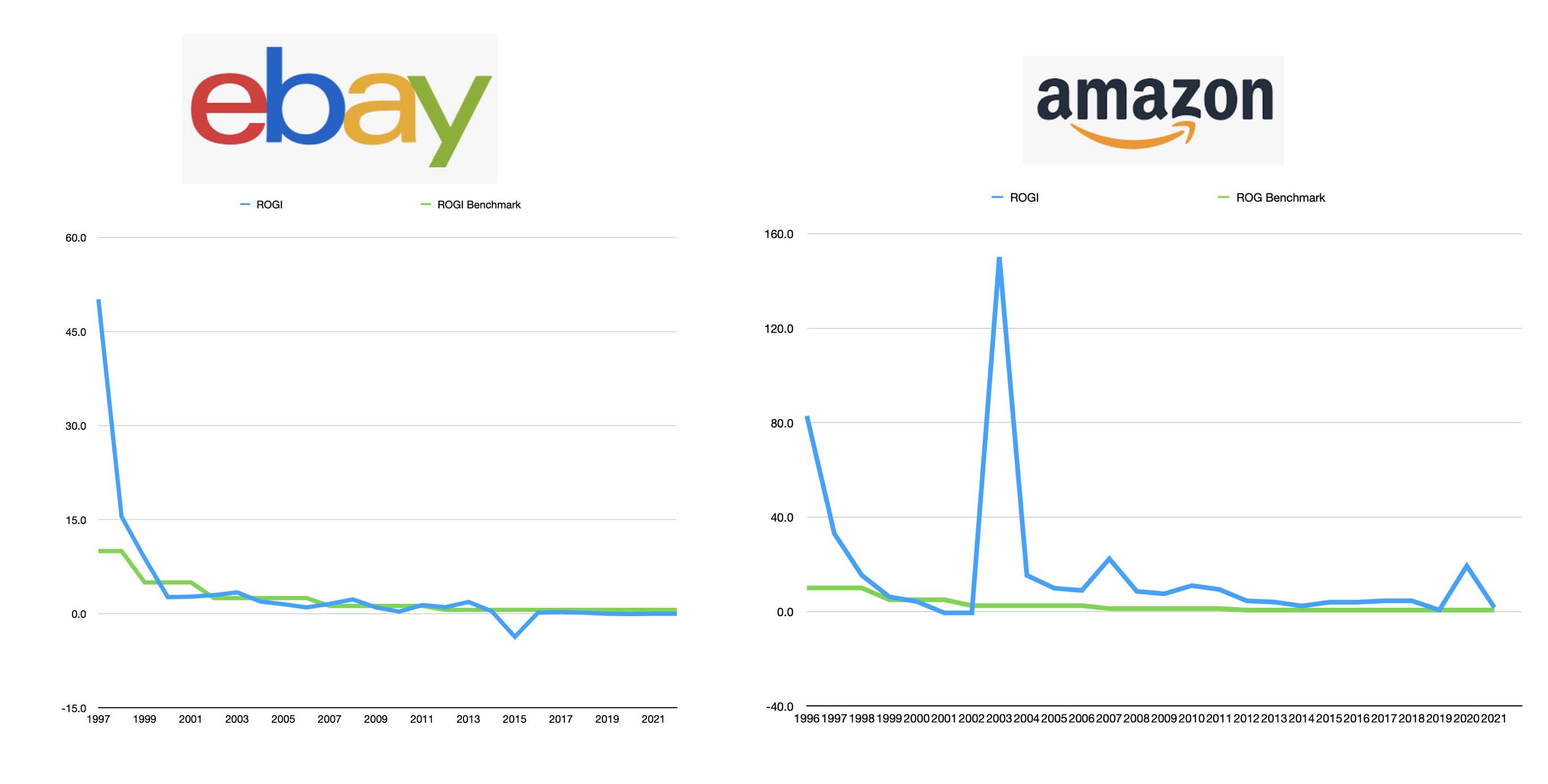
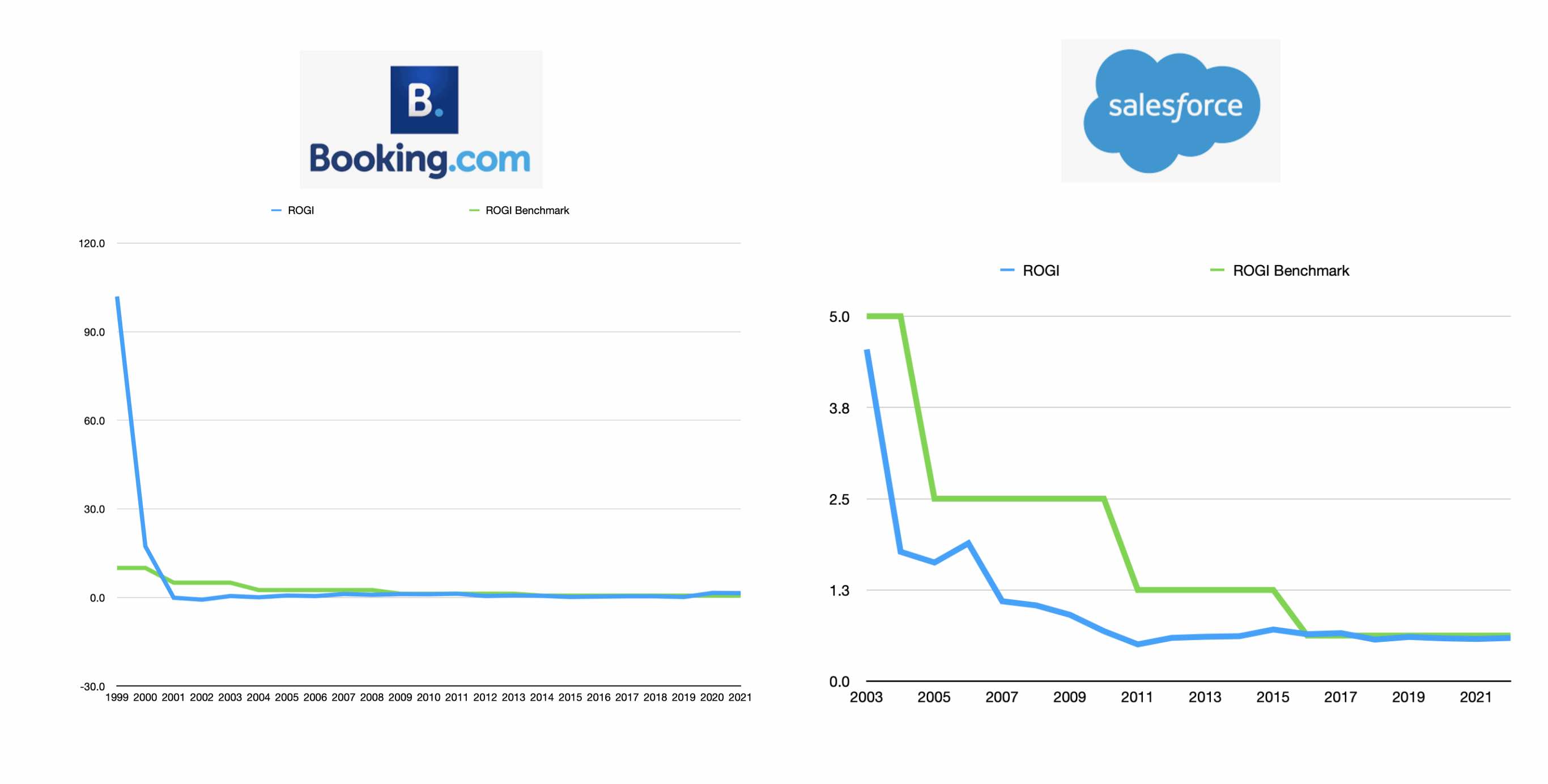
We discover - bar the seismic shifts created by the DotCom Crash, the GFC and now the Everything Bubble - the model holds up pretty well
We also see pretty quickly how much more efficient Amazon has been over the years compared to eBay, Booking.com and Salesforce
Moving on we can also see how the model stands up by comparing the relative performance of this current generation of SaaS players


...some of the eCommerce plays

and finally a sample of 'late stage' consumer brands

Is it useful? I'll leave that up to you to decide
But at the very least it points us towards what the 'steady state constant' may well be in the Phase Changers equation

The ROGI Model
Originally Published Spring 2022
This is the first draft of the ROGI Model
It is basically a tool for exploring the pro's and con's of the ROI and ROGI metrics as a measure for identifying the strategic fit of a sales and marketing plan
Product Cycle
Target Market
Performance
Campaign Objectives
Current Year
Revenue
$
Sales and Market Costs
$
Next Year
Growth Forecast
%
Budget Forecast
Revenue Forecast
$
Revenue Increase
$
Sales and Marketing Budget
$
Sales Budget
$
Marketing Budget
$
Performance Marketing Budget
$
Brand Building Budget
$
KPIs Forecast
ROI (x)
ROGI (x)
Disclaimer
The use of these calculators, charts, visualisations, data or any information shall be at the user’s sole risk. Such use shall constitute a release and agreement to hold harmless, defend and indemnify Digital Partners from and against any liability (including but not limited to liability for special, indirect or consequential damages) in connection with such use. Such release from and indemnification against liability shall apply in contract, tort (including negligence of such party, whether active, passive, joint or concurrent), strict liability, or other theory of legal liability; provided, however, such release, limitation and indemnity provisions shall be effective to, and only to, the maximum extent, scope or amount allowable by law.
Questions of accuracy
Tymbals is an experiment in machine learning and statistical modelling of small data pools. Tymbals is still under development. It is still learning. Tymbals is Beta - i.e. Pre-release.
The probabilities and outputs (e.g. calculators, charts, visualisations) will evolve and change as the system ingests more data.
Tymbals is a probability model. The results generated by Tymbals are market estimates based on the cummulative value of the data within the distributed data pools.
Privacy
All data inputs are automatically added to the learning pool from which Tymbals models are generated.
If you do not want your data added the data pool do not use Tymbals
Phase 3
Should we be surprised to discover the Phase Changes correlates with the old 'Boston Box' (Growth Share Matrix) classification model?
Not really

But the insight that it brings is the 'Boston Box' is better understood as a clock than a classification system
and we can express this idea by mapping the timeline of the YoY change in iPhone unit sales as a series of phase changes through the Boston Box
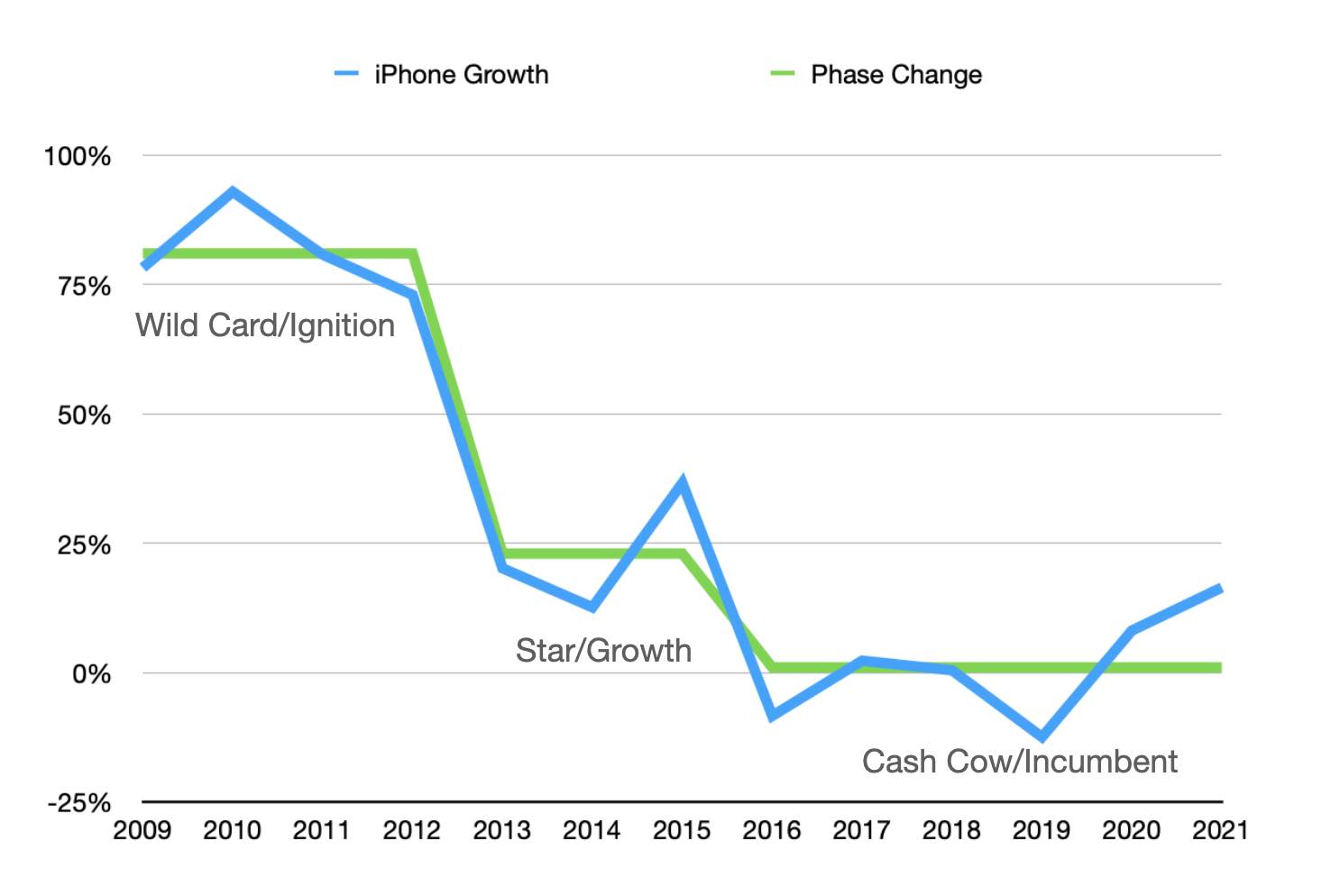
Understand this and you can see the 'Boston Box' is better understood as portfolio management tool for managing the product lifecycle through the phase changes from Wild card > Star > Cash Cow > Dog (Decline)
What is interesting is when you expand on this idea to map Apple's portfolio of wearable technologies
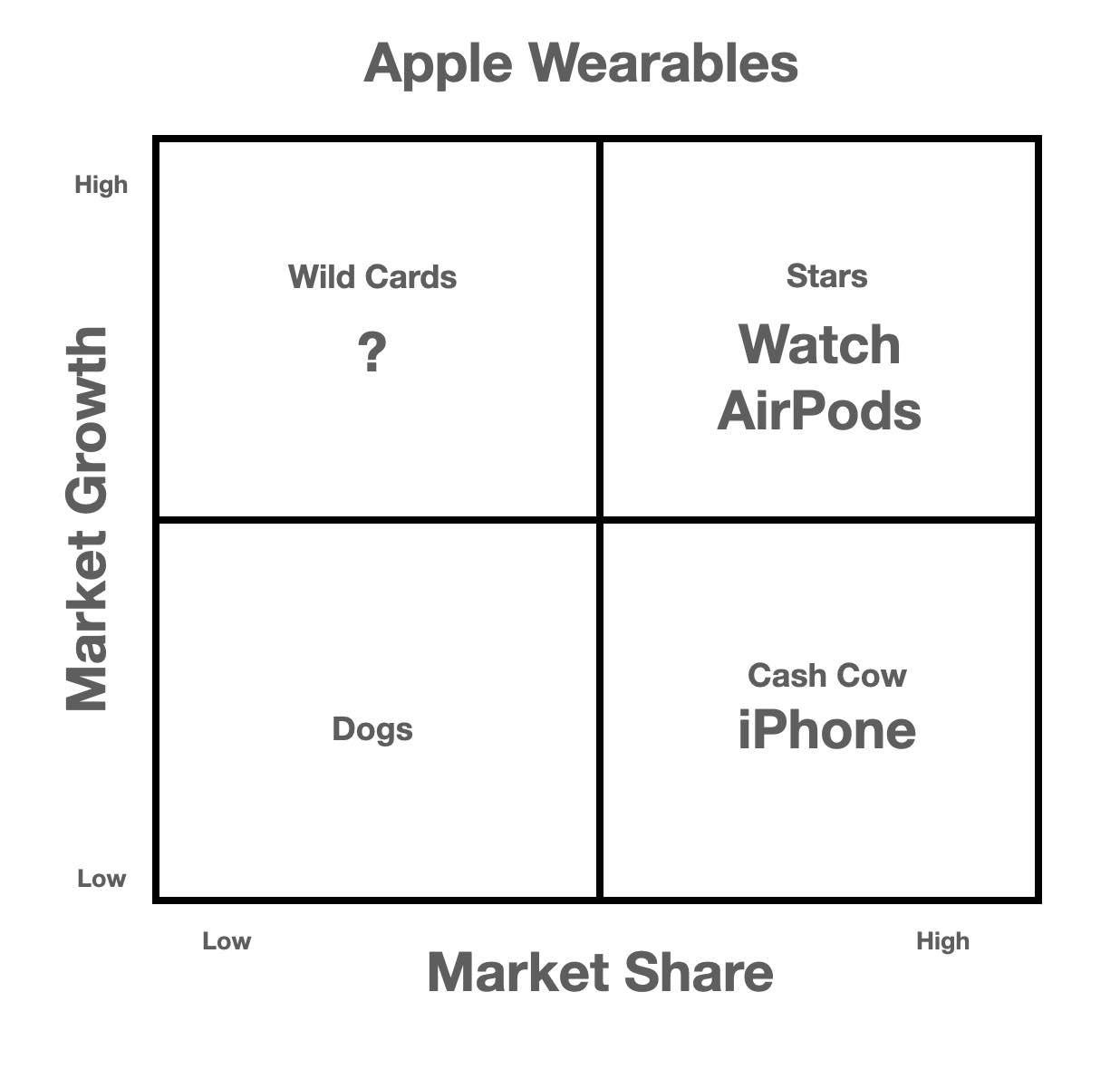
and then map the portfolio across the decades
We discover that the iPhone was part of a continuum of a portfolio winding through the phase changes from Wild Card to Star to Cash Cow
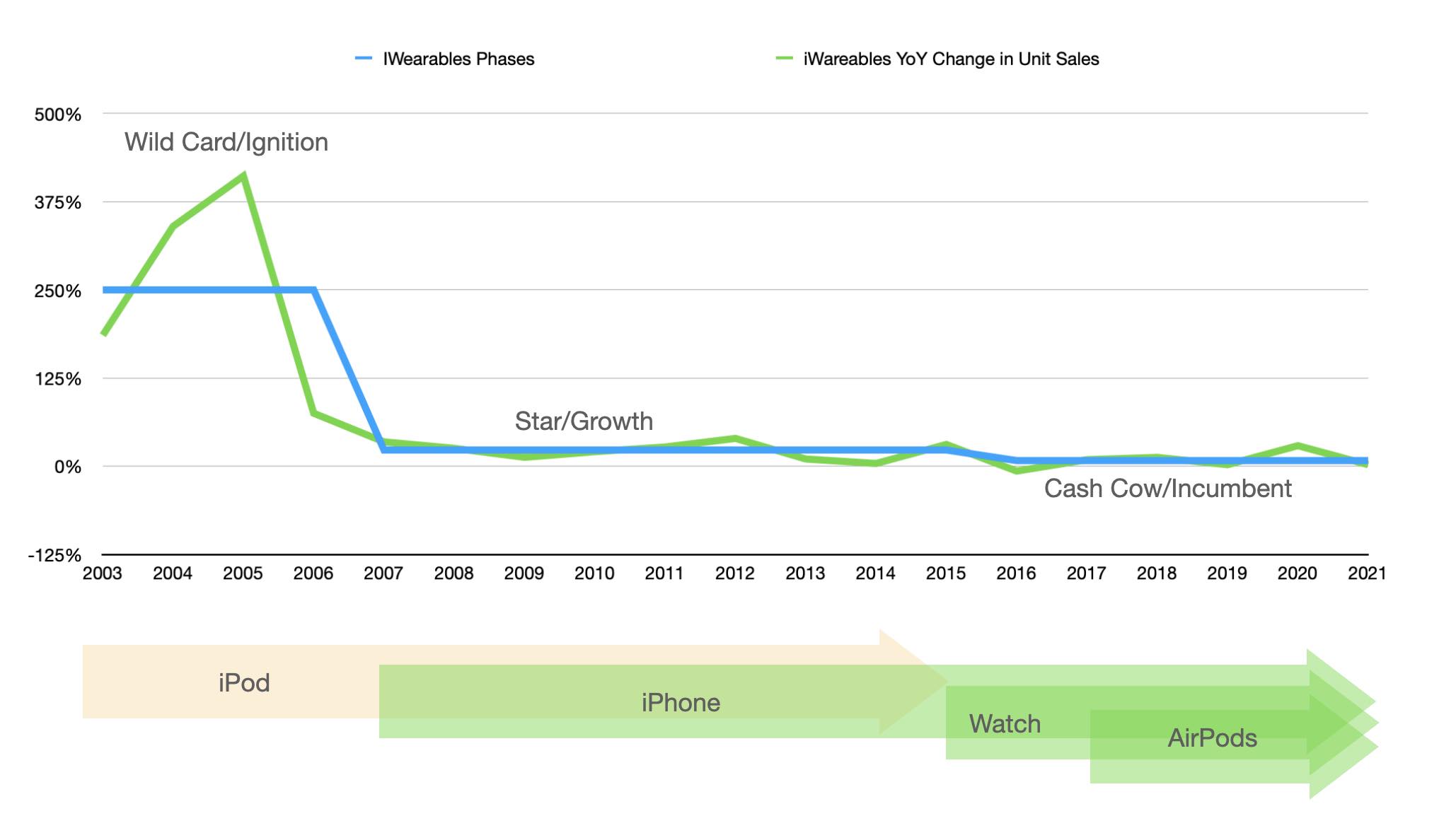
We discover that Apple is in the business of building sub-categories within the wearable digital tech category it launched when it disrupted the Sony Walkman with the iPod
Moreover the introduction of these new products has not changed the overall trajectory of the portfolio - but they have reinforced the relative position of the Apple brand in the market category as it moved from Wild Card/Disruptor to Cash Cow/Incumbent
We can see how each new product entry built on the user base of the existing technology and how - with the exception of the watch (a line extension too far for wearable media delivery?) this accelerated adoption of the next wave of wearable technology
Note: The iPod sold roughly as many units as the Walkman during its lifespan however the adoption rate was 2x faster (iPhone 4x faster) than the Walkman launched in 1979
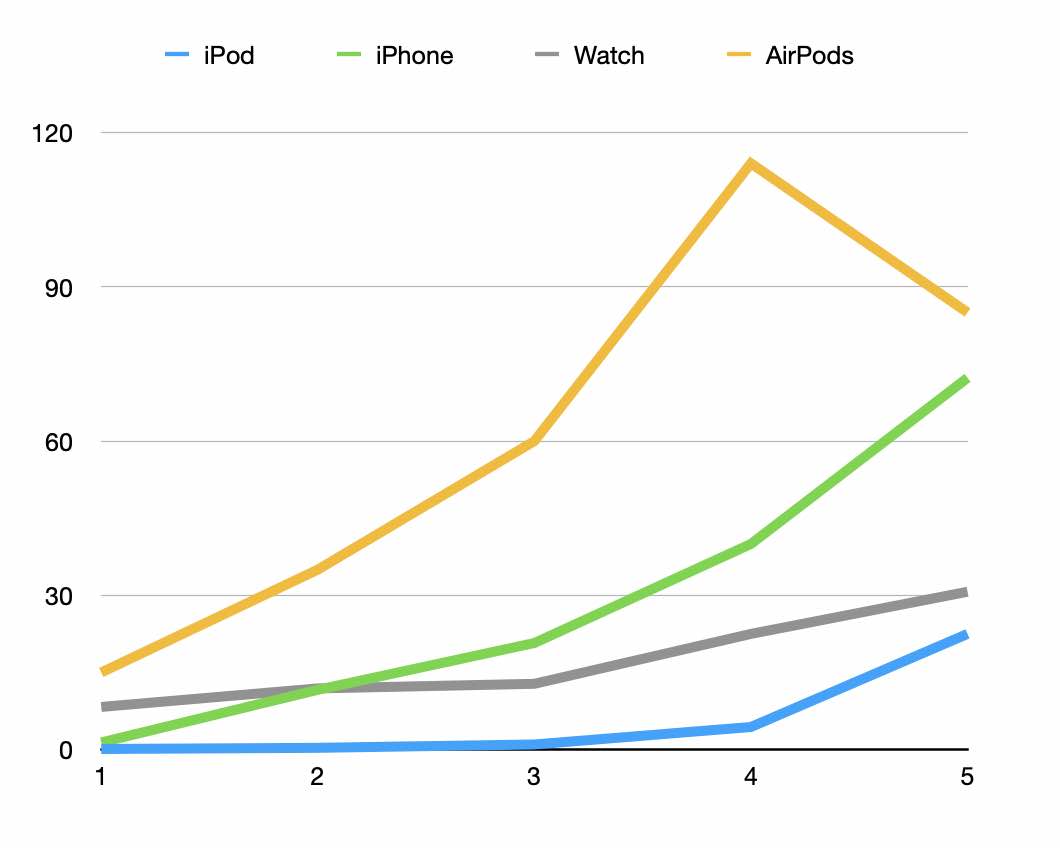
But more on that idea another day...
The key observation that needs to be made is the core of the model... and arguably the core of the marketing profession... resides in the evaluation of the 'Wild Card' quadrant
i.e. Evaluating the odds and knowing where to place the bets
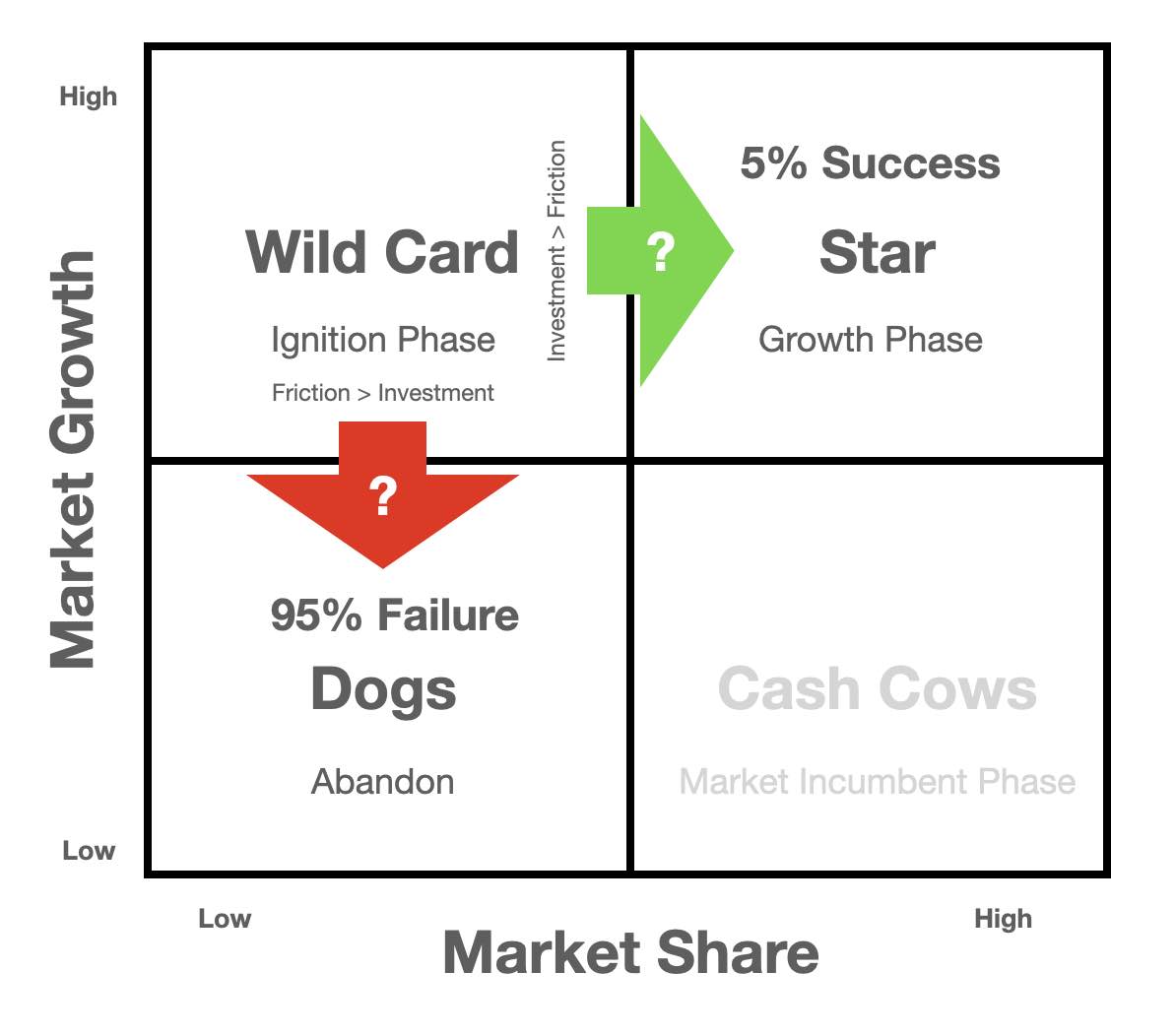
Because, if we map the probability of success into this model, based on Venture Capital ROI in early stage startups, we discover 95% of those investments in the 'Wild Cards' fail to grow fast enough to become 'Stars'
The rest just slip away into oblivion
So how do you forecast success?
Good question!
A better question is how do we improve our chances of success?
and the answer to that is you begin by asking better questions
and then testing the answers to discover if they are indeed the right questions
Let's begin with a simple one: What game are you in? Volume or Margin or Both?
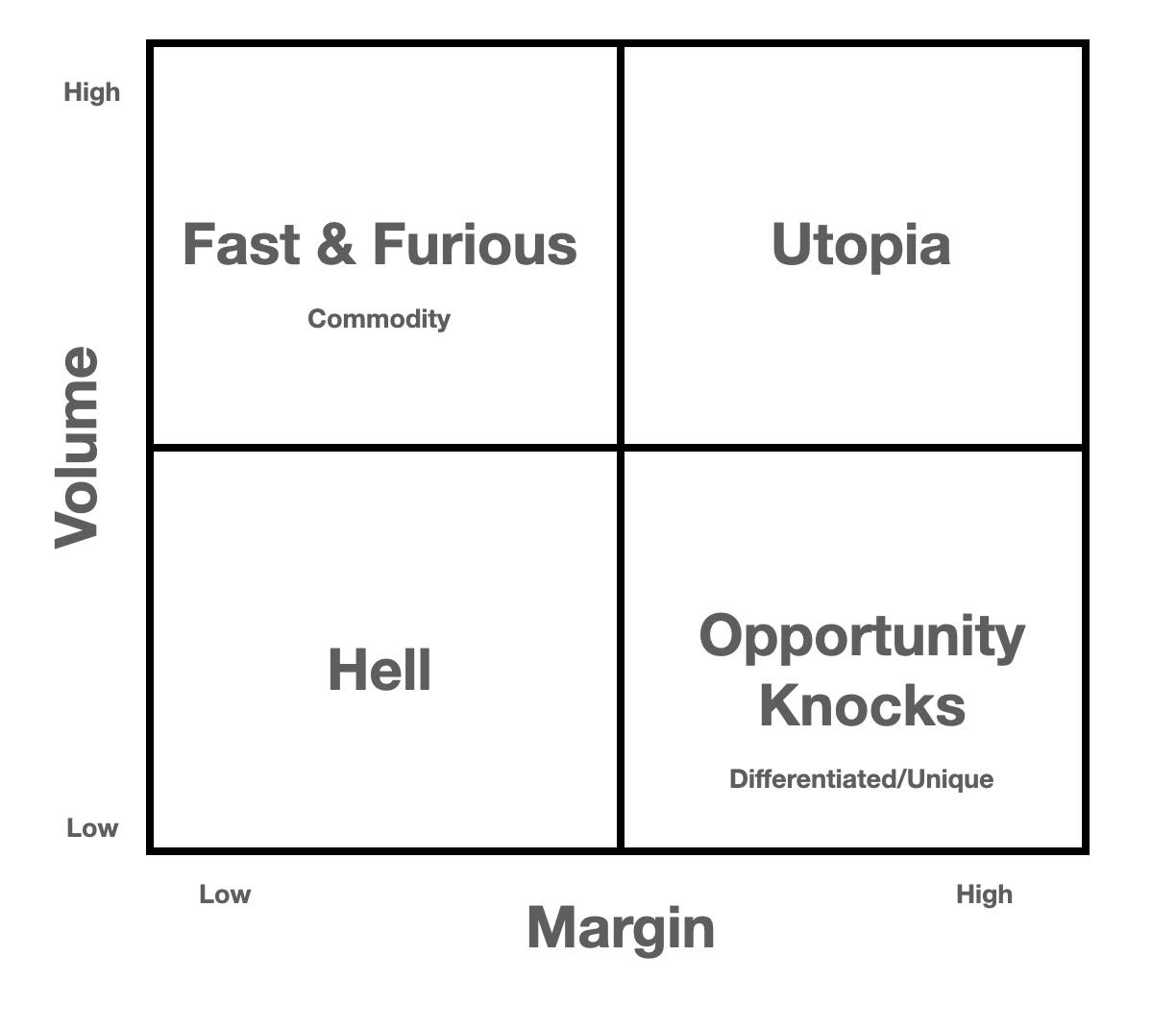
Define this and you'll quickly identify who the competition is...
Better still you can translate Volume into Logic (Price) and Margin into Emotion (Sins of the heart) and from there you profile your ideal buyer (Target Market)
and once you have an ideal buyer you can begin the task of weaving a social proof (Narrative) from their collective aspirations and dreams
The objective being to pivot the 'Principle of Least Interest' (ie ‘The idea in sociology that the person or group that has the least amount of interest in continuing a relationship has the most power over it’) in your favour
The reason being the 'Principle of Least Interest' is at the heart of the Friction - this market resistance - you are attempting to remove from the growth equation
and you do this by ultumately changing the question inside the buyer's head from 'Why should I buy?' to 'Why shouldn't I be buying?'

and now I'm going to finish this brief post off with a quantum leap
Google search and digital in general are about outsourced memory
This is the key difference between Ads of the MadMen era and the digital era
In the earlier era branding was owning a space in people’s heads (Ries/Trout)
They called this 'Positioning'
Today it’s about leasing space in their virtual memory
These are very different challenges with very different rewards on your investment
More so given the challenge can be easily gamified by bad actors active across key pinch points in the value chain
This idea of outsourced virtual memory is also the key driver I suspect behind Zuckerberg’s vision for the metaverse
In this context it is a logical extension of the world Meta and Google already operate in
Meta is chasing the the next generation hardware/vOS platform to disrupt the Google/Apple smart device duopoly
Google is revisiting it’s formative years by scraping the web to feed and train its ground breaking AI
Apple is… ? Advertising is…?
The key observation I want to make is this
If the key to the golden era of mass media was creating unique positions (ie categories) inside the buyer's head
Then the key to unlocking the digital era is creating unique questions inside the buyer's head
Why? Because in a world of infinite virtual memory positioning is just noise
It is the question that becomes the signal
Why? because it renders 99.99999% of the space occupied in the virtual memory redundant
The question is the signal in all the noise
Phase 4
We have explored the idea of mapping the phase changes to the Boston Box
Now let's take this idea a step further to discover what it reveals about managing a product or startup through the 3 phase changes

At the beginning of this journey we discovered that each of the phase changes required a different kind of professional or at least mindset/skillset
The rationale being each phase required a different type of expertise and arguably a different way of mapping, measuring, monitoring and managing progress

The 80:20 Rule suggests the overwhelming majority of products and services in the market todays are Dogs
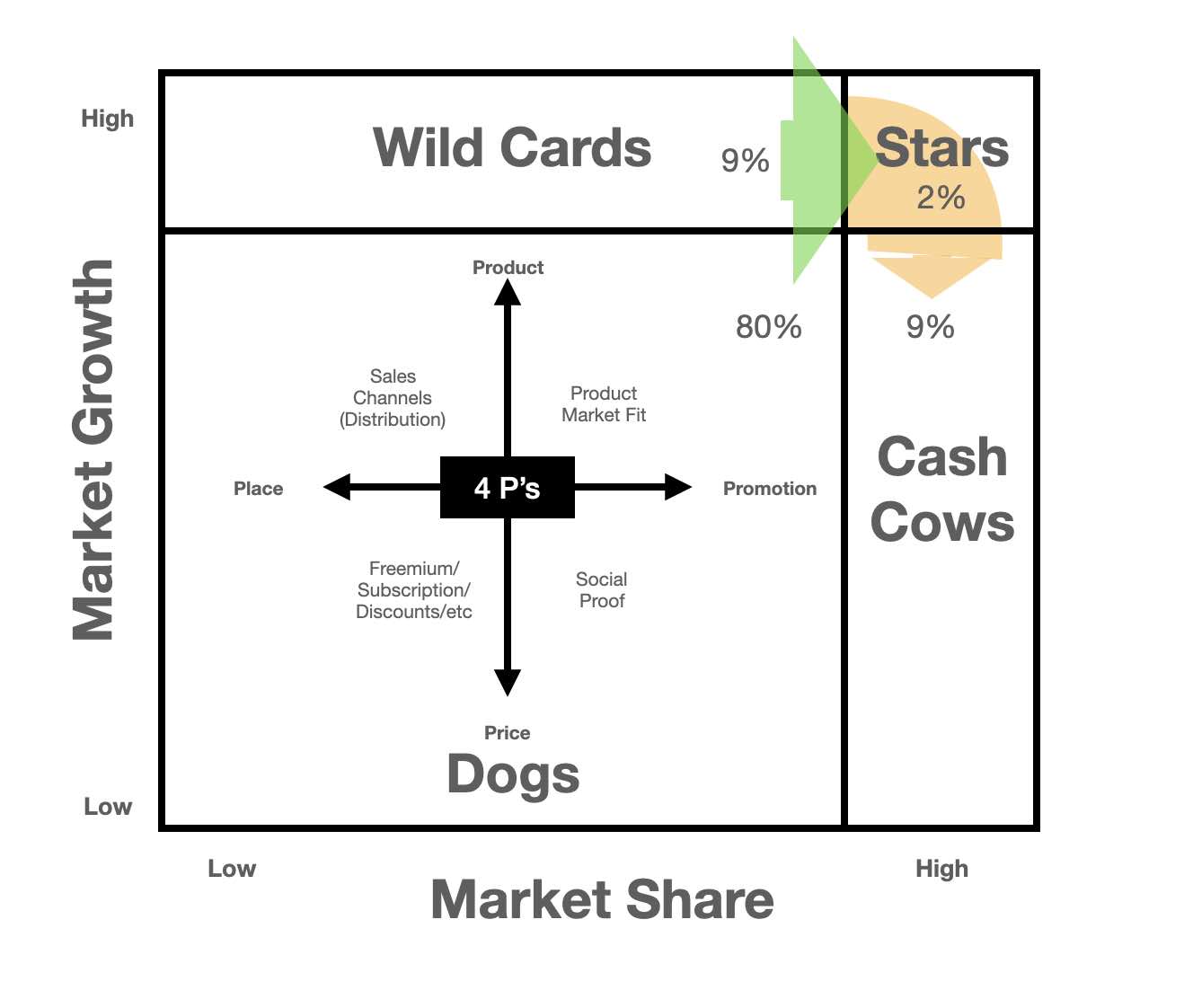
This means the overwhelming majority of marketing professionals today are employed to monitor, measure and manage the performance of Dogs
You could describe them as Dog Trainers
They coach brands to perform the 4 P's of marketing with great precision
Nothing wrong with that
But what I'm interested is the 20% who make a difference
The 20% who know intuitively that 'Great Marketing sells a transformation, not a product or service' (Kudos Samantha Leal)
The 20% who realise Marketing and Sales are actually the same game: One conducted Face to face. The other remotely.
The 20% who realise Marketing is less about the 4 P's and more about listening and leveraging consumer psychology to understand the needs, struggles, beliefs, objections, biases, aspirations, triggers, emotions and desires of the sales prospect and then packaging up a response to meet that challenge (Again Kudos Samantha Leal)
The 20% who know great marketing is about category creation. Not just competing with the rabid pack of hounds on Price, Features, Performance, Traffic, Clicks and Conversions
So - getting back to the original question that triggered this extended thread of posts - if great marketing isn't about the 4 P's (Price, Promotion, Product, Placement) what is it about?
The answer - of course - is creating new markets
That's why it's called marketing and not pricing or producting or promoting or placing or 4 P'ing
Your objective is to create new markets for your products... not waste money competing with everybody else, and certainly not the market leders, in their own markets
So how do you do that?
Well let's see what merging the Boston Box with some old ideas about social contagion, emergence, convergence and divergence reveals about what's different within each phase of the market transformation cycle
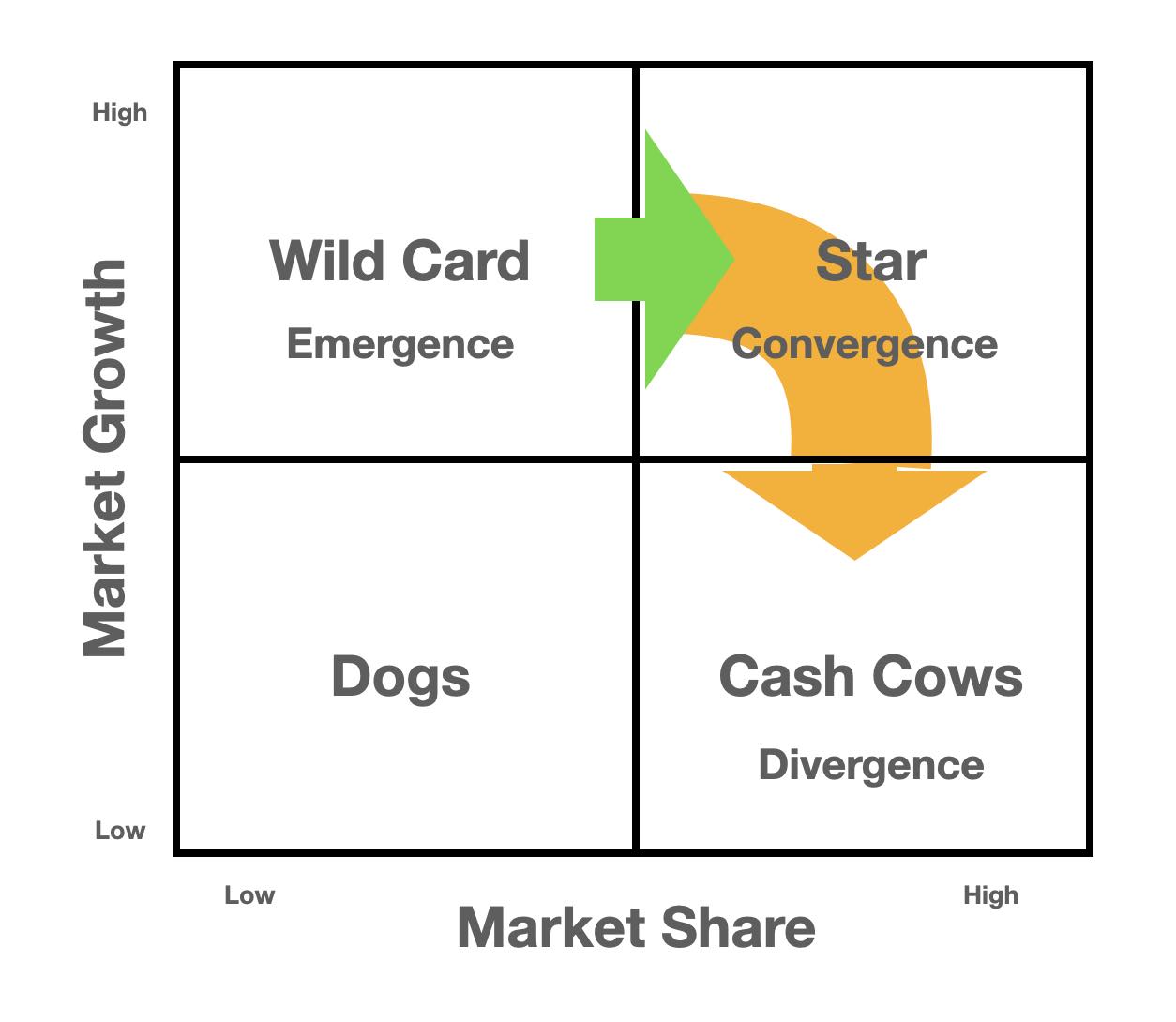
I would argue today the overriding metric that governs our ideas about how marketing works are based on the idea of contagion
Be it word of mouth through to brand awareness, brand recall and share of mind
all of these metrics are based on the idea of spreading the contagion
What the mapping of the phase changes reveals is these ideas may be - if not wrong - at least fundamentally flawed - if only because these contagion metrics are better understood as lag rather than lead indicators of success
So let's put these contagion metrics aside and begin with the proposition: Marketing is the business of manufacturing Emergence, Divergence & Convergence... on demand
Emergence
Managing a Wild Card is all about planning for emergence
Markets evolve
They are constantly in flux
Change is the one true constant
The key to success here is identifying emerging trends and leveraging them to your advantage
The challenge is identifying what to inject into the market to trigger changes in behaviour
The key to success is pinpointing the social triggers that motivate the market to (re)act
The objective here is to remove friction from the marketplace
Convergence
Managing the growth phase is all about creating the conditions for convergence
Convergence is about gaming market behaviour
Igniting the customer's curiosity
Enticing them to act on impulse
The challenge is creating the hook
A point attractor
That attracts a crowd
and brings them to rest
We call this the Brand
The paradox here is for your market share to grow you need to bring the market to rest (ie introduce friction)
Hint: Click/touch on one of the dots and we'll show you how easy it is
Divergence
In the world of marketing we call this the brand or line extension
The idea that new products and services can become extensions of the Cash Cow
It's all about leveraging the Brand Equity that has been created by the cash cow to enter into new market categories
Arguably the emphasis here is on portfolio management
Hint: Draw on the canvas to watch divergence at play
Contagion
Market contagion is how we measure the relative success of these collective efforts
Today the world of advertising and marketing is awash with specialists in the mapping, monitoring, measuring, manipulating and managing social/market contagion
i.e. Dog Trainers
However the winners have evolved to become niche players in the specialisations of Emergence, Convergence and Diffusion
I just suspect they don't know it yet... simply because nobody has put a label on it before now
In that last post I closed with the observation: If the key to the golden era of mass media was creating unique positions (ie categories) inside the buyer's head
Then the key to unlocking the digital era is creating unique questions inside the buyer's head
I'll close this one with the observation the role of the marketeer within each one of the 3 quadrants is ultimately what you do with the question
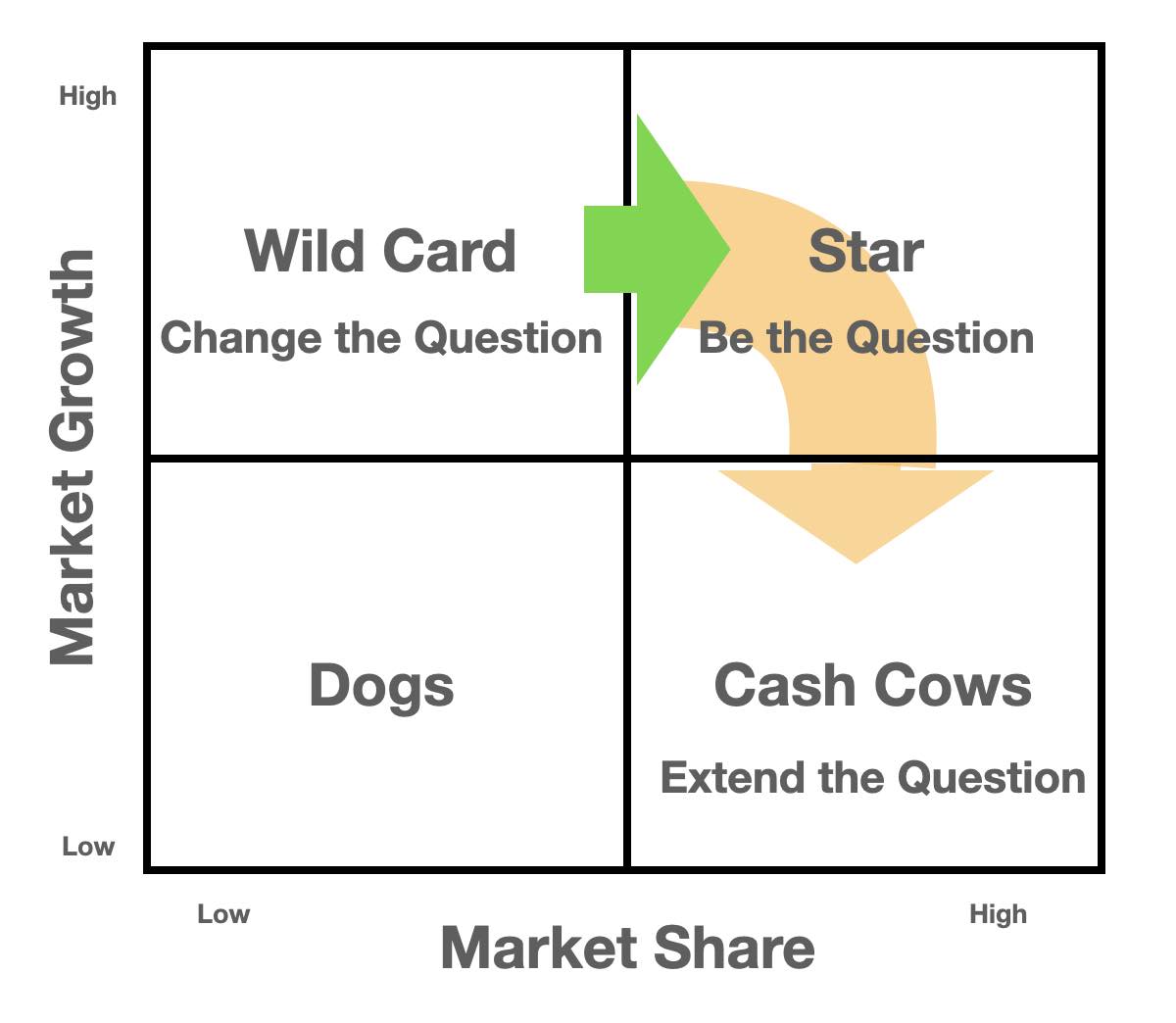
The objective is to change the question on everybody's lips
e.g Have you heard?, Have you seen?, Did you know?
Then become the question on everybody's lips
E.g. How's it working out for you?
... and then expand the questions on everybody's lips to keep new players from entering into the market
More importantly you need to be the question in everybody's head... Am I that type of Man, Women, Girl or Boy?
Am I Coke or Pepsi?
Am I Energy Drink or Cola?
Am I...?
Am I a performance marketeer addicted to MarTech and Data Analytics or am I a Brand Manager addicted to Share of Mind and Brand Recall?
That ultimately is the root of the marketing challenge
Manufacturing new markets... new identities... new questions about our beliefs and aspirations... and then filling the emotional void we have created
It really is that simple
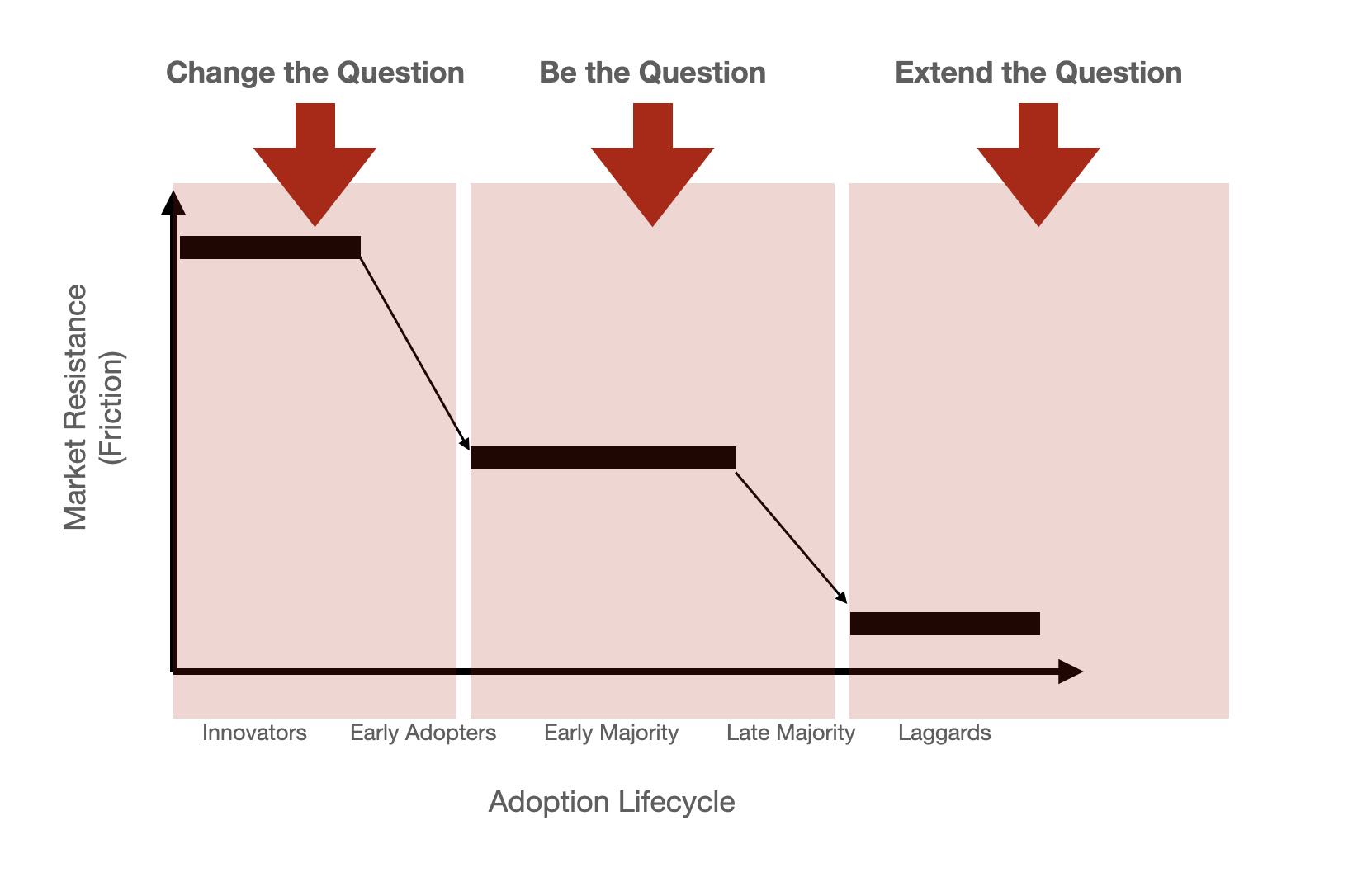
and ultimately this idea: Change the Question. Change the Phase
It harks backs to the origins of the original ExCapite Blog
and the role of new marketeer being the puzzlemiester as auteur
...and we are left once again to reflect on James Burke's opening remarks in the documentary series 'The Day the Universe Changed'...
"Your world is a reflection of what you know today. Changed the way you think, by introducing new ideas, and you will change your world".
...and ultimately my opening observations from over a dozen years ago...
Today we live in a world where we can navigate our way through unimaginable treasuries of online knowledge and change the way we think by simply clicking on yet another hyperlink.
Today your Universe can change in the time it takes to load a new web page or receive an SMS on your phone.
We are no longer thinking in terms of the The Day the Universe Changed. Our world view is in flux. If we are not already, then we soon will be awash with “Moments When Our Universe Changed”.
This I think is both the wonder and the challenge of our age
Phase 5
Those of you who are familiar with these threads will know they are basically exercises in taking an idea and stretching it just to see what happens
Some fly off into the future. Others simply float nowhere.
This thread is one of those that measures how much we have forgotten rather than shedding light on the future
Marketing is about creating new markets
There is little to no friction in a new market
First come first serve
It's all about speed and agility. Gobbling up as much new territory as you can and quickly as you can
Once you have occupied the new territory you get busy building the moat and the ramparts to defend it
You introduce friction into the equation
All this means marketing is a simple game
Because the opportunity to create new markets is endless
It just takes imagination and investment
But you look at the world of marketing today and you discover it is complex
Today every company is a media company. Every company is a big data company. Every company is a tech company.
and you only have to look at the consistency in the quality of Microsoft's software, Google's search results and Disney's movies to know each of these objectives is crazy
If the market leaders struggle to consistently deliver on this promise what chance do you?
In truth every company is just fumbling around chasing the next trend
Following rather than leading
... and this is because the metrics of success, just like the sands, shift with each new wave of MarTech
At the beginning of this thread I suggested there is truth in the old adage you can only manage what you can measure but ultimately you become what you choose to measure
Today the world of marketing is awash with metrics
Some self imposed. The majority from external stakeholders.
I would argue to change the game you need to introduce new metrics
New ways of measuring success in the world of marketing
and I think these new metrics should focus on the challenge at hand
How do you measure your ability to create new markets?
How do you measure your ability to defend these new markets?
These are the questions worth exploring
and I think it comes down to the obvious questions
Firstly: What market offers the greatest expansion opportunity coupled with the least amount of friction?
Secondly: If we can secure this market what will it take to defend our position?
These are the strategic questions
They are questions of territory
and they point to the Art of Marketing being more akin to the Art of War than the Science of the Tea Leaves (Statistics and Big Data)
Where success comes down to your ability to read the landscape and how you deploy your assets
So if we begin to map the territory what does this map look like?
I suspect something like this
We scan the horizon to measure the variance between where we are today and the where we could be heading (ie How near or far away are we talking? & What is the level of friction we will encounter between here and there)
Then we cross reference that with the vibrancy of the landscape (ie How what's the growth potential of those opportunities?)
and then, on top of that 2x2 matrix we estimate the size of those new markets
So in one cube we have mapped the landscape of opportunity and the relative difficulty of capturing and servicing those opportunities
Entering a nearby rapidly growing market with a large Total Addressable Market (TAM) is optimal
Investing in a distant market that is already deaccelerating with a small TAM is sub-optimal
So the Territory Equation = TAM x Growth / Distance (from the brand)
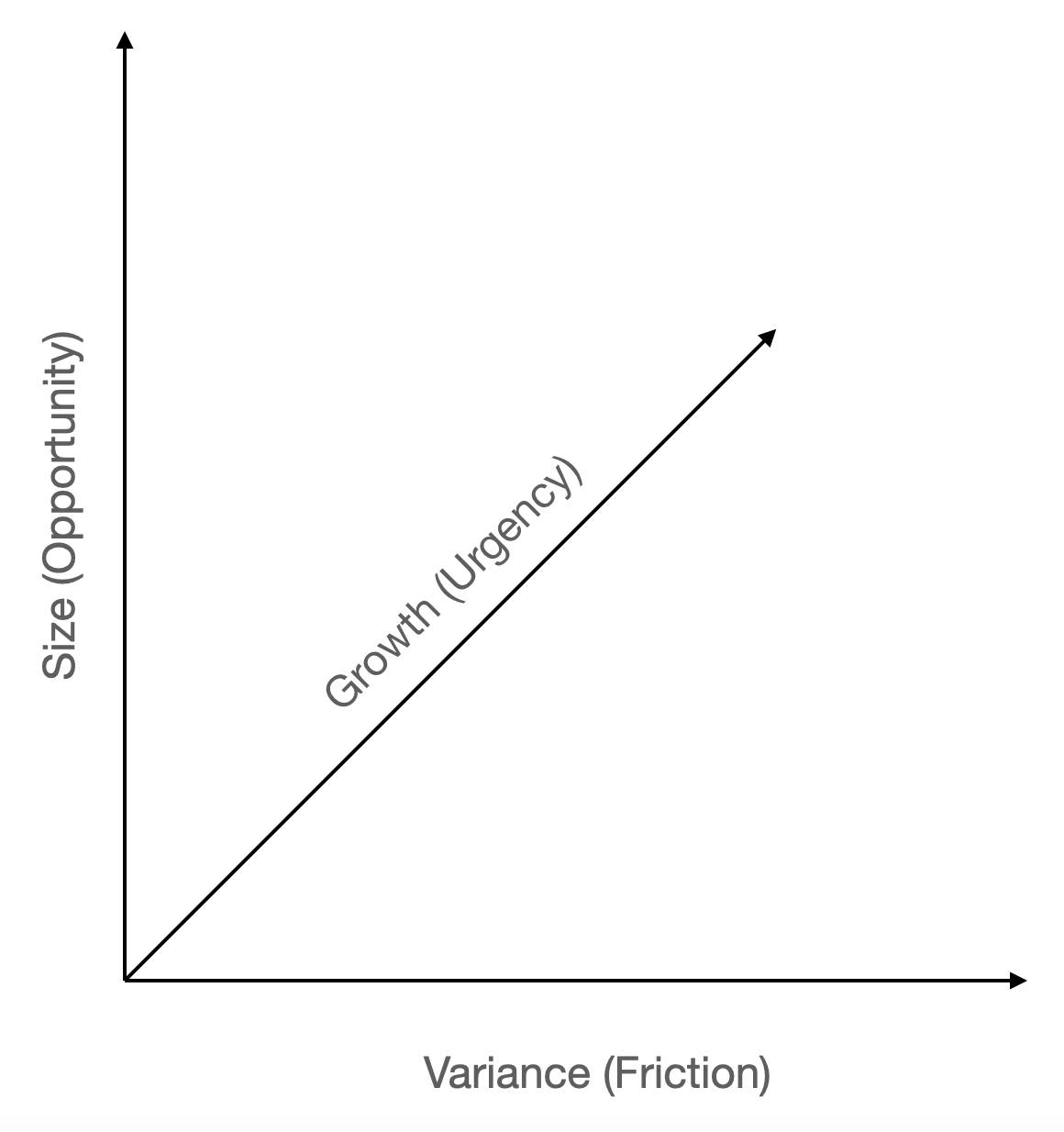
To put this into context let's take another look at the iPod as case study
In 2000 Napster grew its user based 10x (ie 14,000 Users) - Proof of strong growth for digital music
Sony had already sold 250+ Million Walkmans - Proof of global market
The distance between Desktop Computing and a Wearable MP3 Player was well within the Apple market horizon (Think: Newton PDA 1993-1998) - Proof of operational capability and brand elasticity
So the Territory Equation for the original iPod looked like this
iPod = $28Billion * 10x / 1
5 Years later the market for MP3 players was $4.5 Billion and Apple had secured a 30% market Share
In contrast when Apple released the Watch in 2015 Fitbit's growth (the market leader in health tracking wearables) in the previous year was 2.4x and they had already sold just under 17 Million units in the first 5 years
Five years on and the market for health trackers had grown from $1.5 Billion to $36.34 Billion with Apple again securing 30% of the market
So - once you factor in the growth prospects and TAM projections for the wearable market (eg similar to MP3) - the Territory Equation for the Apple Watch looked something like this
Apple Watch = $30 Billion * 2.5x / 5
and this perhaps explains why, although it generated more revenue in the first 5 years, the growth trajectory of the Watch did not match the iPod
... there was already friction in the market

and we can expand on this idea to evaluate Google's GlassHole adventure
In 2014 when the prduct was launched there was no market for the product, no evidence of growth and Google had no history of developing computer hardware
Glass = $1 Billion (?) * 1x / 10
Then there is Amazon's 2006 AWS strategy
Cloud computing was emerging from the tech wreck of the Dot Com crash
Early entrant's like Loudcloud had come and gone in the aftermath of the crash
Amazon had spare capacity. Bundling it up as a cloud compute offering in retrospect seems self evident
Data Centers were scaling at 15% per annum between 2000-2005 and the world was already spend >$100 Billion in 2004 on hardware to meet demand
Map all this to the Territory Equation and we discover AWS = $100 Billion x 1.15x / 1
This then is how you navigate the fitness landscape when planning your marketing strategy
and, yes you can use it for M&A evaluation
In the case of both the Instagram and YouTube acquisitions by Facebook and Google the equation read 20x Growth * $5 Billion TAM * 1x Distance
Meanwhile the ill fated Nokia acquisition by Microsoft would have equated to $54 Billion TAM * 0.78x Growth / 5x Distance
... and we can map those decisions across the Fitness Landscape and it becomes self evident which ones were going to be the winners and losers
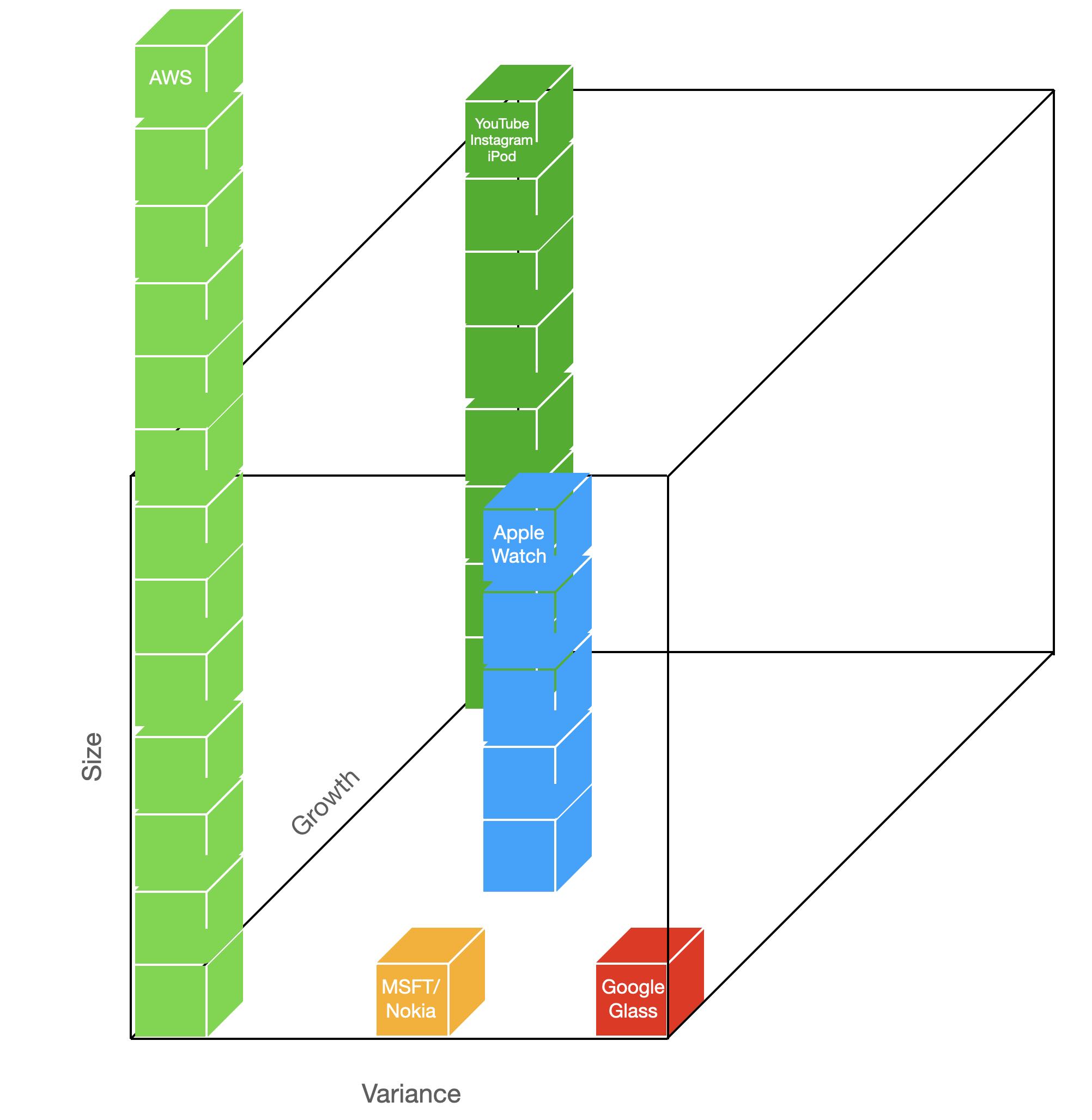
Basically it's a away of thinking
A way of seeing the market
A way of evaluating the gaps in market
A way of identifying where the quick wins can be found based on your capability to execute and the elasticity of your Brand
and if you struggle with thinking in 3-D you can always reduce the Growth/Scale metric into a single variable and map it to the variance to generate the more traditional Risk vs Return or Value vs Ease forecast matrix
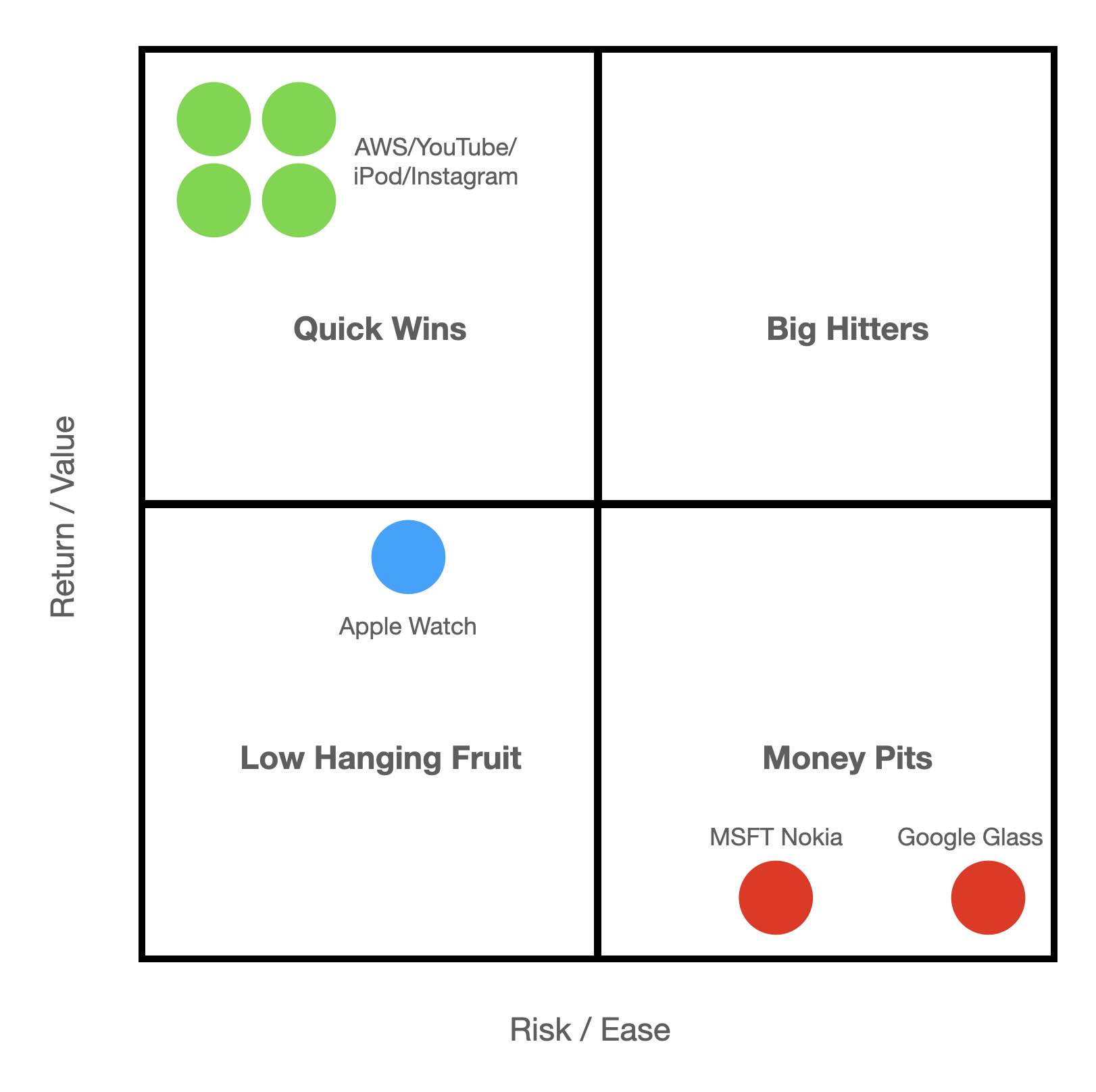
Or, you could make a subtle change the way you think and reimagine the 'Boston Box' as Growth Opportunity vs Friction
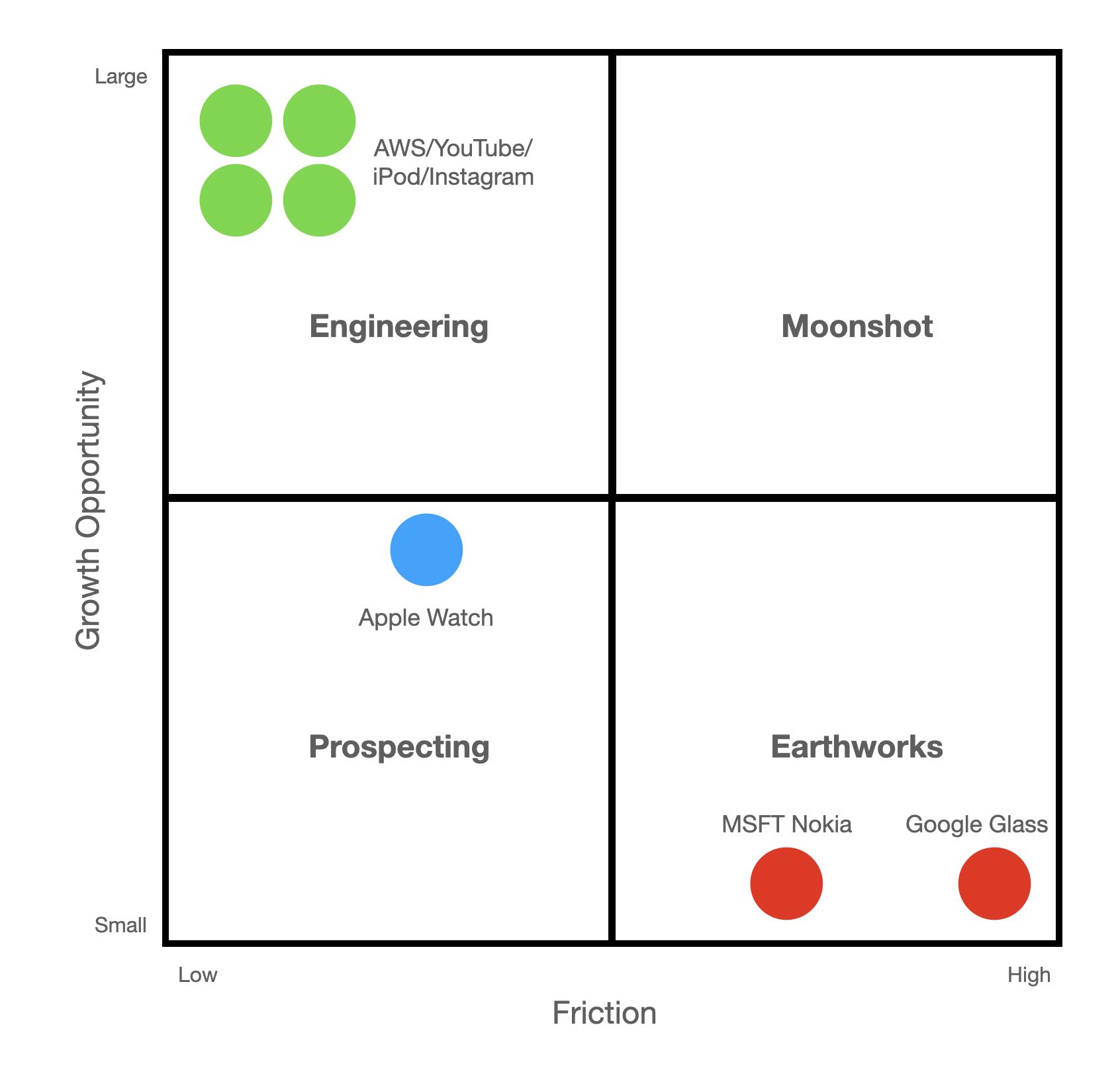
So I'll leave it there
I don't think it's a ground breaking insight
I wouldn't call it a new way of thinking
More like an old way of seeing
It's just stating the obvious
Marketing - particularly when you are managing a cash cow or transforming the old into something new - is about creating new markets
It's about discovering opportunities for frictionless entry and then closing the gate before competitors arrive
The best way to plan and measure your progress in creating new markets is to map and monitor the fitness landscape centered around your brand or product and figure out how you are going to expand into new markets
It's not rocket science... but then again I'm not too sure anything about marketing ever was
In closing the observation I want to make is the pivot Silicon Valley has imposed on the marketing profession
You see the trick they pulled was to convince the world that today every company is a media company. That every company is a tech company. That every company is a big data company.
and they did that by seeding the idea the opportunities available to everybody in this brave new world were unlimited and the transition was frictionless
Digital Media + Digital Tech + Digital Data = 21st Century Digital Success
Grow your business for free on Google, Facebook, TikTok, Twitter, LinkedIn, Snap, Pinterest, YouTube, Shopify, Mailchimp, Hubspot... etc - all you need to do is become a media company generating digital content and keeping an eye on the engagement stats
They took the frictionless pivot and turned it into a game everybody with a camera phone can play
and as each new player became hooked on playing the game the level of friction of not playing the game, of not being on the platfrom, of staying and investing more energy in the game, increased
The question moved from why would you be playing the game? To can you afford not to be playing the game?
They turned marketing into a game everybody with a smartphone and an app can play
and that my friends is pure marketing genius
Postscript:
The original question that prompted this thread was: What if our ideas about marketing are all wrong?
What if the 4 P's, the product adoption cycle, the S Curve and the 60:40 Marketing Mix are fundamentally flawed ways of thinking about how it all works?
In retrospect it was perhaps the wrong question
A more poignant question may have been what if marketing profession has confused tactics (Doing) with strategy (Thinking)
What if rather than learning the 4P's young marketing professionals would be better equipped with learning the fundamentals of investing - ie picking the growth opportunities within a market and assembling/managing portfolios of profitable investments
Because the ideas I have sifted through here have more to do with thinking like a modern investor than a modern marketing professional
Having said that I believe the relationship between successful marketing and successful investing is symbiotic and arguably the 'thinking/planning/strategy' skills are interchangeable
ROI from an investment in new high growth, frictionless markets will always prove more rewarding than an investment in low growth, high friction markets
It's just a case of where you choose to put your money to work
So hopeful at the end of this thread - if nothing else - you have been encouraged to rethink how you forecast and measure success in the world of marketing
and, just as importantly, how you see the 'battlefield' - the competitive landscape - you are monitoring today
Further Reading
The decay of corporations and an analysis of their business fitness landscapes
Tribal narratives in the age of fractals
The Journey from Metcalfe's Law to The Fractal Narrative
Phase 6 - The Eye of the Storm
For those of you who have made it to the end this is the Easter Egg buried deep in this series on Phase Changes
Would you use the 4 P’s to teach marketing today?
No. You would teach Investing
Why? Because to understand the marketing you need to understand the Markets
Or, more accurately how the market prices opportunities with a market
This is how the novice investor thinks…
They look at the stock price and then try to rationalise why it represents a great investment opportunity

Now let’s use this idea to map out how Marketing people think about Marketing
Guess what: We discover they invest the bulk of their budgets, technology, time and effort in mapping, monitoring, measuring and optimising the opportunity

Basically their methods and processes are the perfect expression of not knowing what business they are in…
i.e. Making markets
And the question needs to be asked why?
and the simple answer is…
They have one piece of a jig-saw puzzle
and it is their job to try and figure out where it fits
Think of an elephant and blind folded experts in a room using computers to optimise their insights
This is marketing today
Now let's take a quick look at how the experienced investor thinks…
They begin by asking the question: What motivates the market (Why are people buying/acting?)
Then they map the landscape to discover who is is winning the game as it is being played today
They then dig deeper to discover what differentiates the market leaders
Only then do they look at the price they have to pay

So let's ask the obvious question
How would marketing professionals behave if they acted like professional investors?
Let's begin by saying, if we look back at the Boston box, we discover the market is best understood as dog track

We have lots of dog trainers and we have lots of dogs barking
It’s a noisy place where dogs get to run round in circles barking loudly while their trainers clock their lap times
It’s a great spectacle and fevers run high
You could say the level of friction created here is a function of the investment in generating noise (and you’d be right)
The dog track business is a buzz
Market Leaders on the other hand create their own ‘universe’ of friction
Their market share is removed from the dog track
Their relationship with their market is pure signal
Things change when they attempt to introduce new products or enter new markets
and, yes, if they are not careful they find themselves running around the dog track with all the other dogs
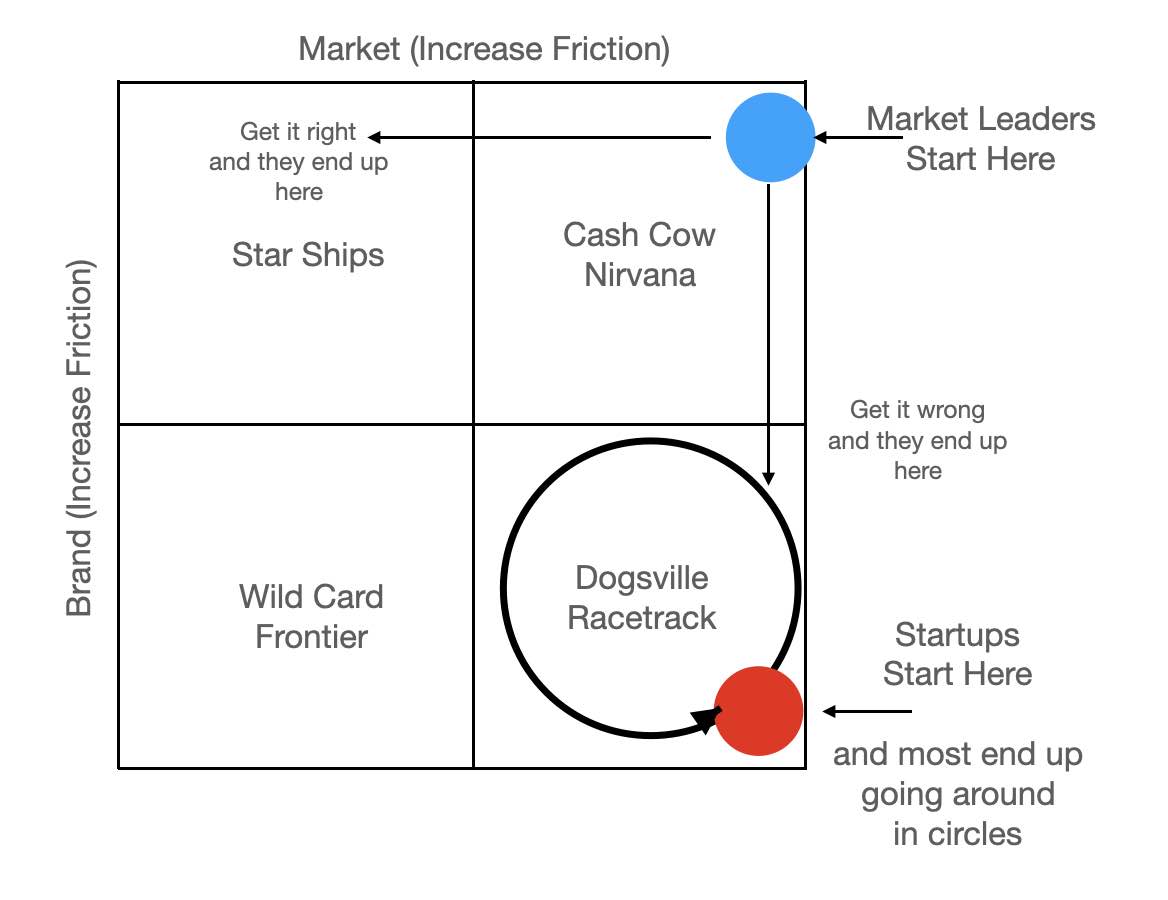
Startups on the other hand earn their stripes at the dog track
The only true measure of their success is how quickly they learn running around in circles is for the dogs
You have to think differently if you are to break the breathless cycle of running with the barking hounds
and this challenge speaks to the function of marketing and ultimately the campaign strategy
To plan the campaign we must map the territory
and to do that we need to introduce another axis
but before we do that we need to understand the difference between competing at the dog track and with the market leaders
The dog track is big on market friction and small on brand friction
It is wide and thin
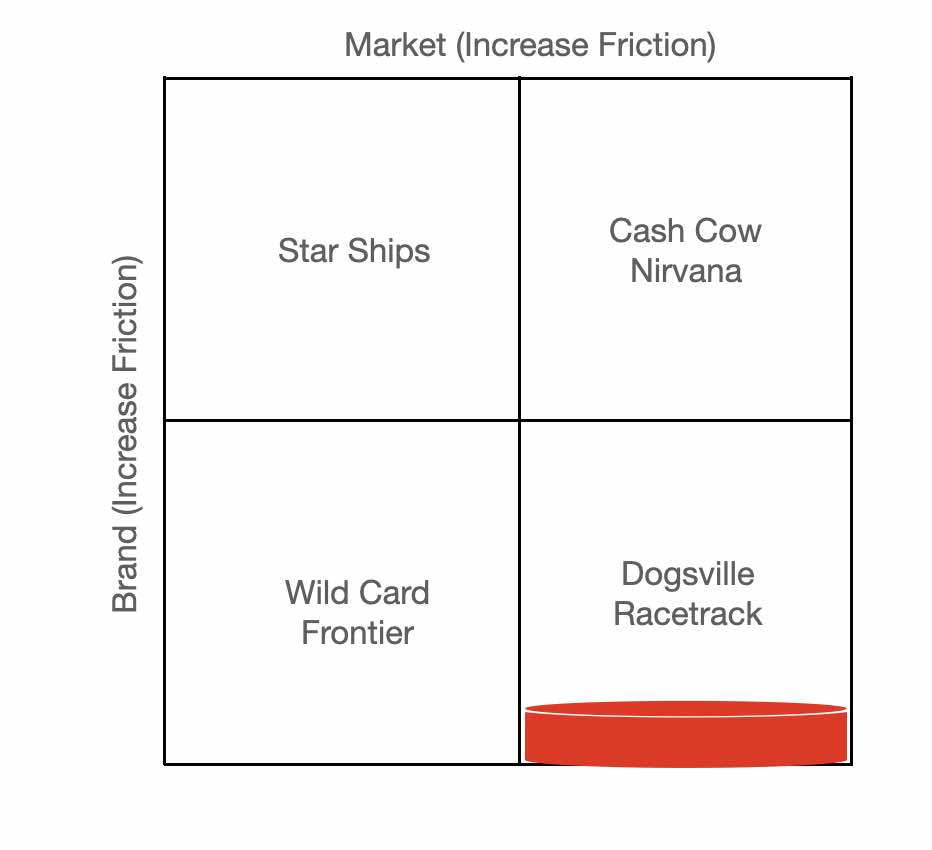
The market the leaders play in on the other hand is big on both market friction and brand friction
It is wide and thin
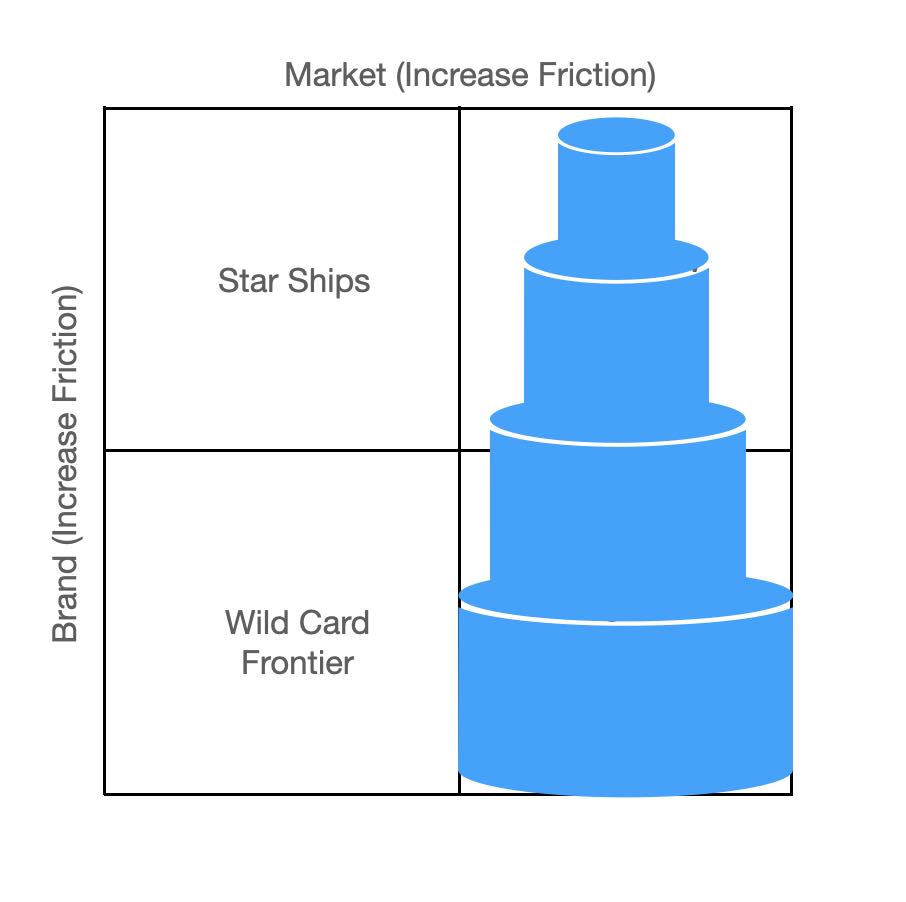
Now the common interpretation of Market Leadership is building a moat
To accomodate that idea we need to turn the matrix on its head
Now market leadership is best understood as a sink hole that the market gravitates towards and fall into rather than a mountain that needs to be climbed
The challenge then becomes one of making the edge of the funnel wide and frictionless so the market slips and falls in
Less a matter of brand building and more a matter of inviting the market to slide into your hands
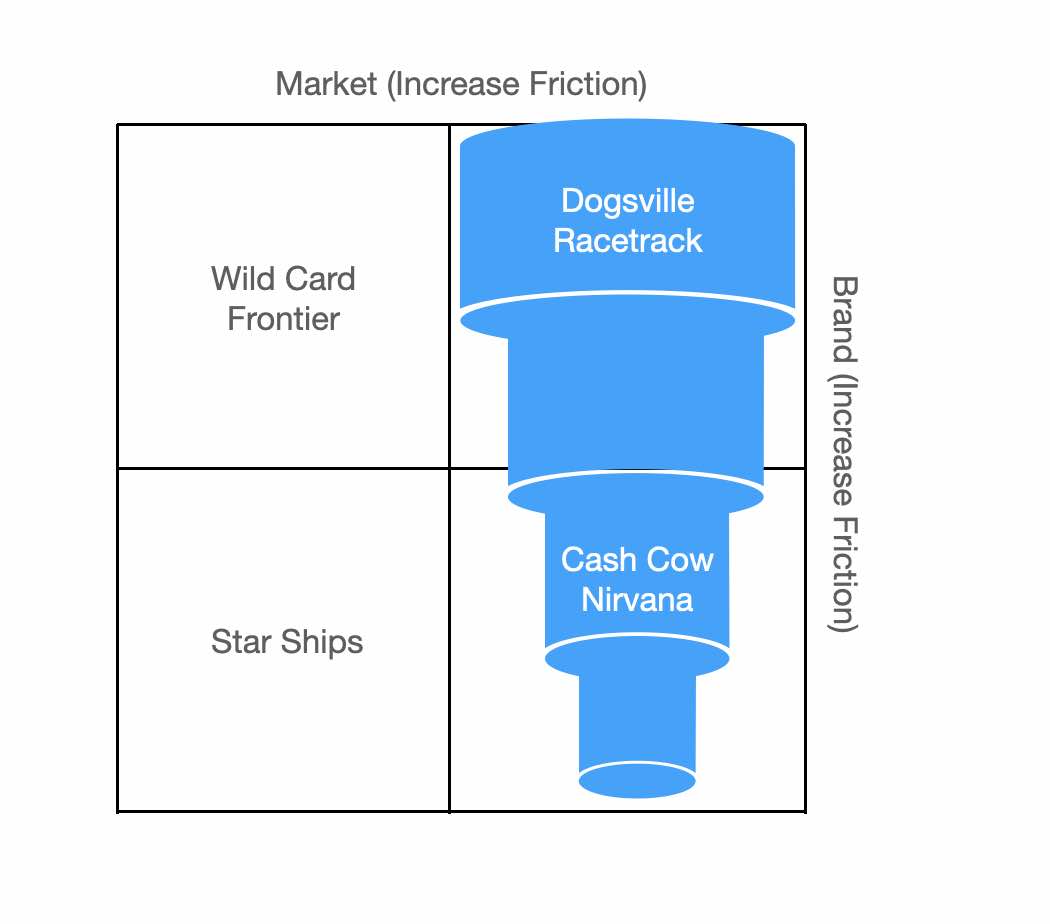
Flip this matrix and view it from the top and you discover the quantum leap
The dog track is a whirlpool
and the market leader sits in the middle of it
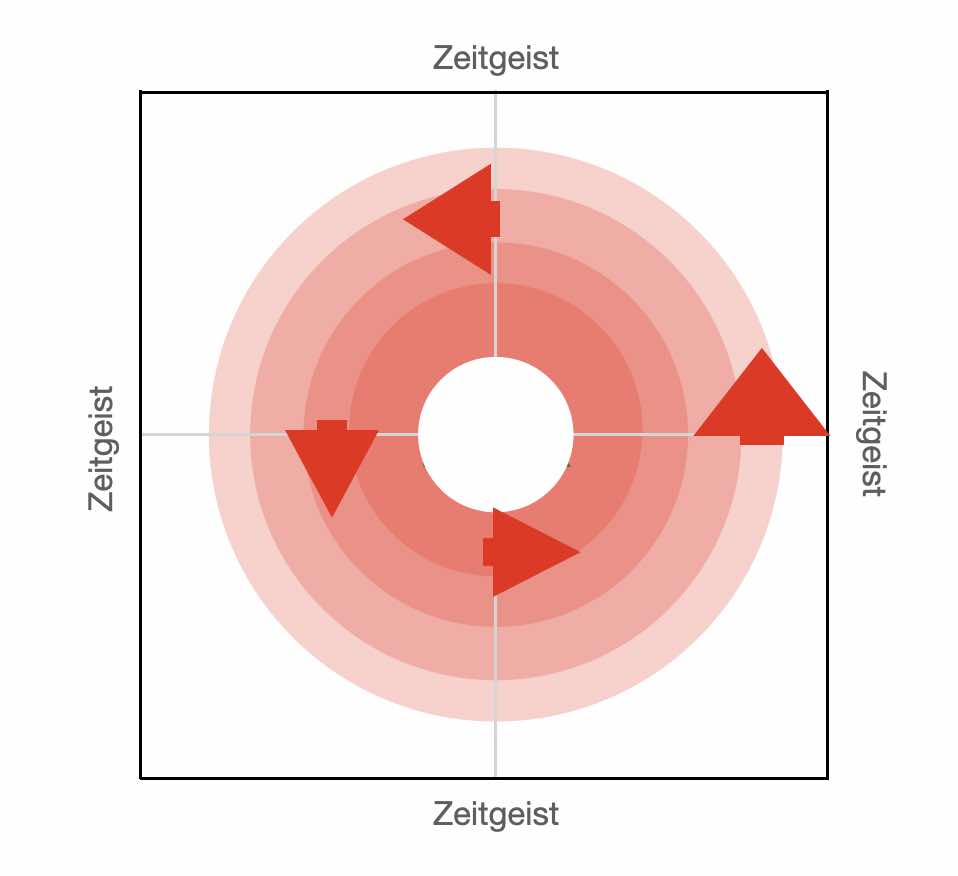
So you have all this chaotic, frenetic activity - the zeitgeist - swirling around the brand
And in the calm at the eye of the storm sits the brand
The closer you get to the eye of the storm the greater the market friction and the greater the speed of the zeitgeist
Then it just drops away
The market leader becomes the beacon blazing brightly in the storm
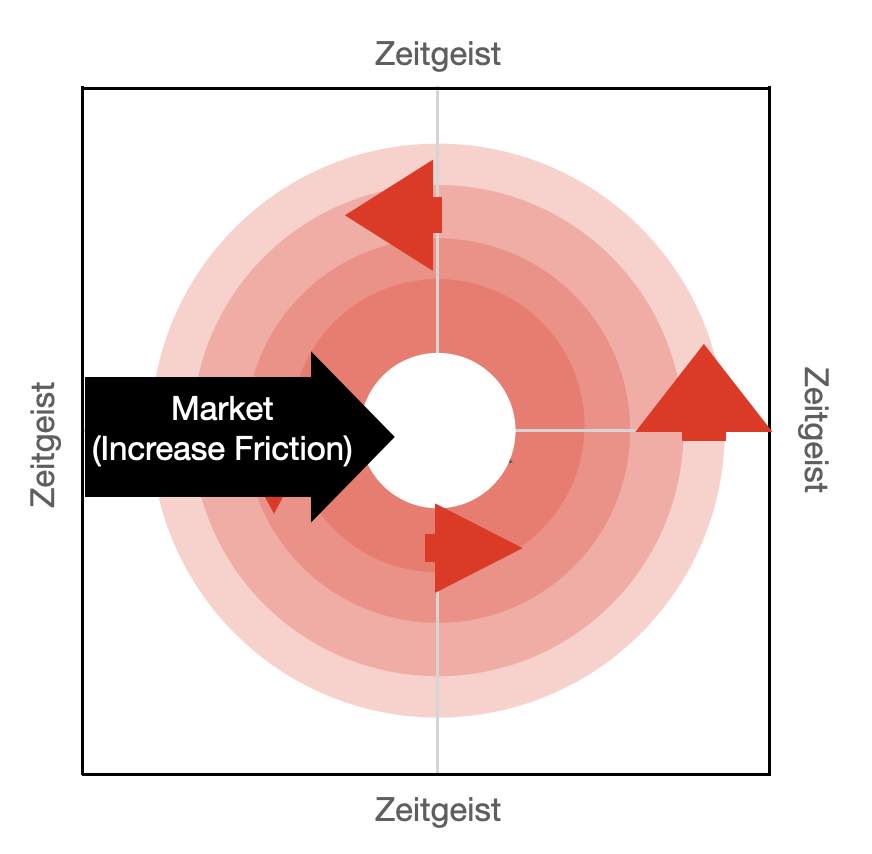
It becomes the point attractor and everybody falls in...

Disruption of course happens on the edges of the zeitgeist
and this is why the zeitgeist is always on the move
The only question you need to ask is where is it heading and how do I position my brand so it remains or becomes the eye of the storm?
and this takes us back to how professional investors think

If marketing is the profession of creating markets then its primary task is mapping the zeitgeist and repositioning the brand to keep the promise, products and services in tune with the zeitgeist
What Wayne Gretsky famously described as skating towards where the puck is heading
The classic case study in this being Apple's disruption of Nokia as Mobile Phones transitioned from Wearable Communications (Connecting People) to Wearable Computing (This changes everything)
The catalyst for change being Facebook's 'Free' 24/7 social media
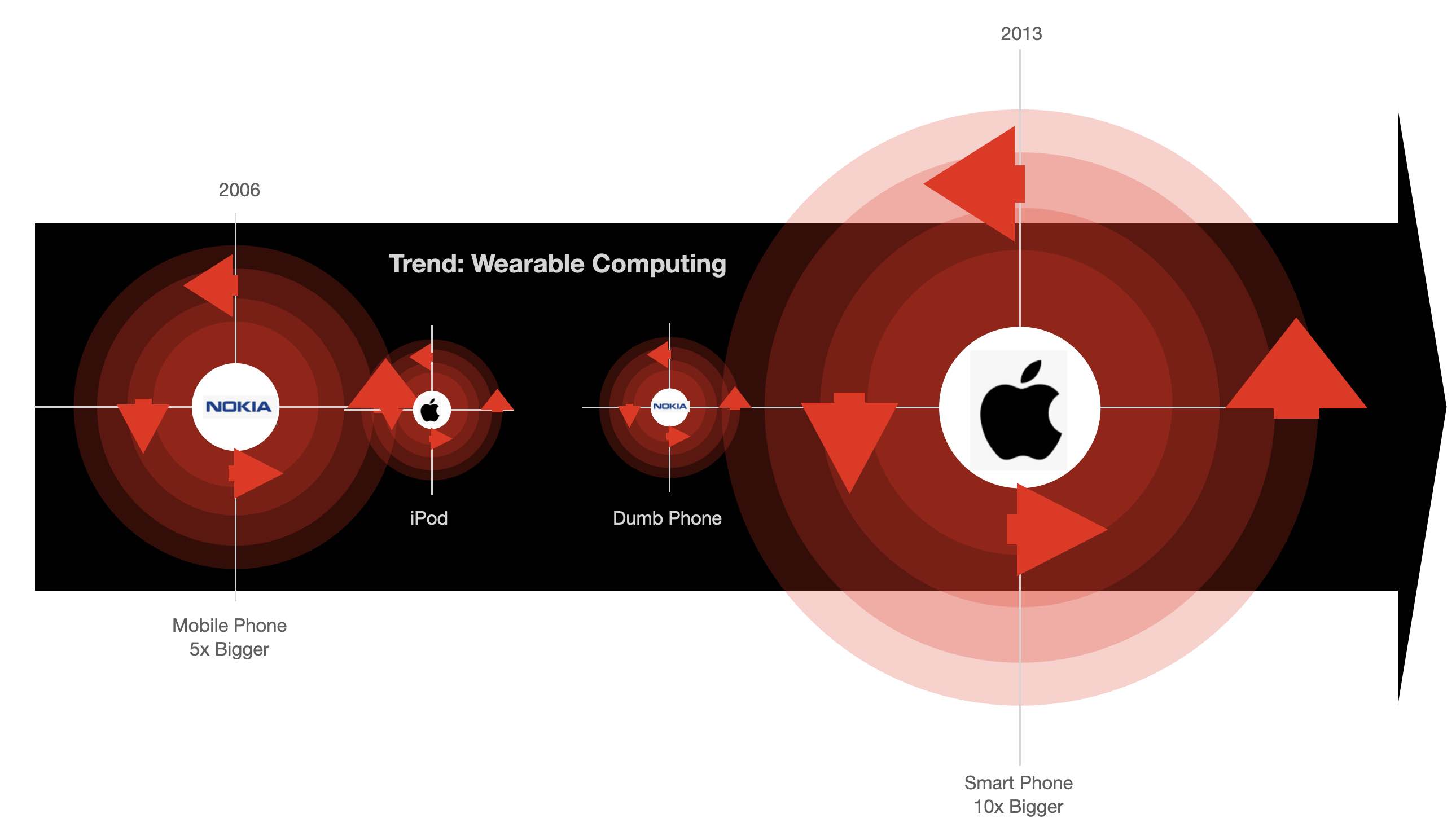
and this, ultimately, as first suggested when we began this series, is why the 4p's of marketing...

...looked more like the 2IC's

Because, as we now can see, the real art of marketing is creating 'sink holes' that the customer feels comfortable slipping into
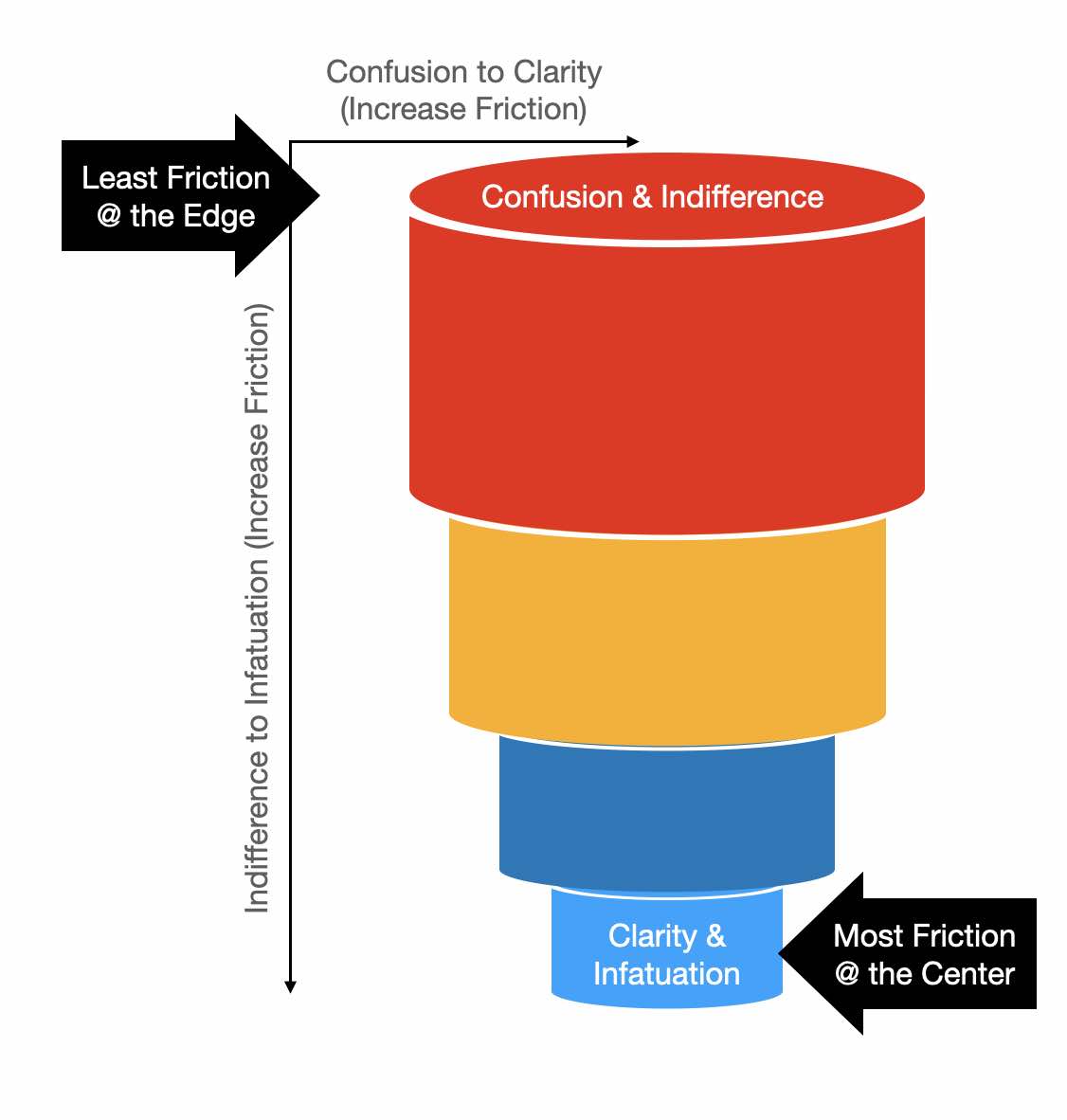
The question then becomes how?
and not so much how do we create these sink holes?
But how do we get the market to move towards the sink holes we have created
The simple answer is you either front run the zietgeist or you influence the zeitgeist - ie redirect it towards your sinkhole
You either jump in early or you create the trend
and that insight leads us back to a post I wrote 9 years ago... On how profiting from network effects is a function of your investment in PR
and the deeper insight: Growth is fundamentally tied to your investment in Brand Awareness ... ie Building Brand Equity
e.g. Tinder's 'organic' growth story powered by American Press Coverage
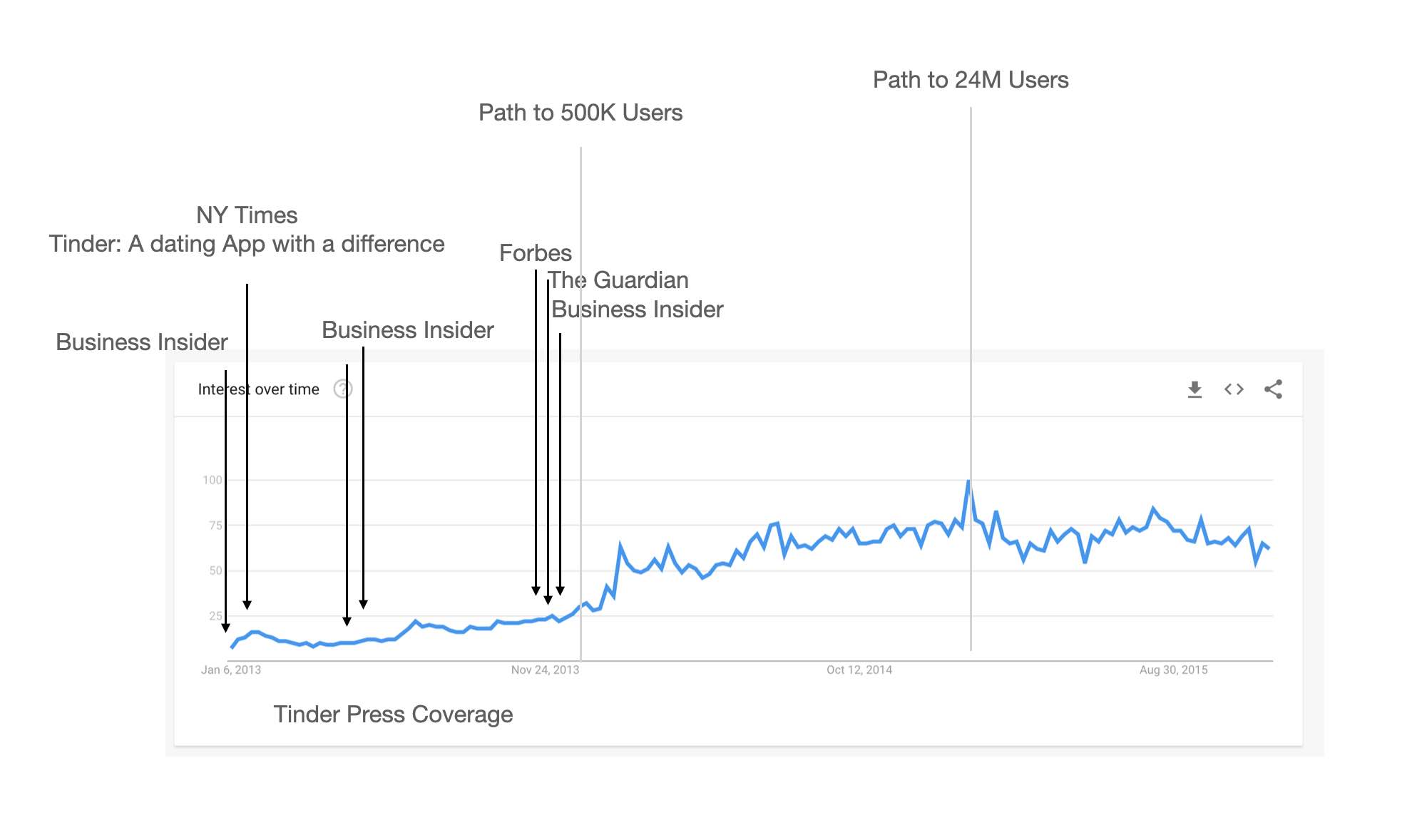
and this leads us back into the realms of Change the Story and you Change the Game and creating the addiction or hook that is the point attractor that encourages the customer to slip freely into the sinkhole
But for now I'll leave you with this insight
This isn't about creating customer journeys. This isn't about KYC. This isn't about an abundance of metrics and methodologies
It is simply a game of creating something new that customers want to jump into... it's all about feeding our insatiable curosity to experience and share something new
Bonus Track
A 20 Minute video on the science of phase changes
Footnote: On the question of what is the ROI on a Brand Campaign?
Fast forward 18 months and John James referenced a tweet of mine in an extended 5 part series on Brand Advertising
The quote was...
"A Brand Campaign is basically an ad that is so ridiculously expensive to make that all it says is look we are doing so well we can afford to waste shareholder funds on this for no other reason than ‘because we can’.
Brand advertising is basically market signaling. It’s calling out the competition. Can you compete with us? Can you compete with that! This is what market leadership looks like! Etc
Anyone who thinks otherwise is missing the point"
John used the quote in the context of describing a Brand Campaign as an exercise "Costly Signalling"
This idea is fundamentally wrong
Let me explain why
We'll begin with the question: How do you calculate the ROI on a brand campaign?
The answer is you don't
Your response is if you can tell me what the ROI is on a hedge on your investment portfolio or ForEx account then I will know how to frame an answer to your question
You see, with in the framework of the Phase Changers, a brand campaign is best understood as a hedge: ie a strategy that tries to limit risks across a portfolio of financial assets
When you invest in a Brand Campaign you are buying a hedge to de-risk your prior investment in building the brand through performance marketing
You are buying a hedge that increases the cost of entry for the rest of the market
You are investing in maintaining the status quo (ie your current market position)
You are buying into inertia
In financial speak you are buying into an advertising and and market strategy to offset the risk of any adverse movements by your competitors to acquire your customers and undermine your market share
It really is that simple
It isn't a question of what is the ROI? But what are the losses if you don't derisk your position by hedging?
Note: This observation led to 2 more posts in this series
Part 7 - The new marketing dashboard in which we use the reporting models of the CFO to redesign the marketing score card, and
Part 8 - Fulcrum Marketing in which we clean up & dumb down the ideas outlined in Part 6 of this series
Phase 7 - The New Marketing Dashboard
The 2022 series on Phase Changes was about mapping the requirements for a new marketing dashboard
How could we merge the language of the CMO into the language of the CFO?
This post is a pivot on that idea
How could we merge the language of the CFO into the language of the CMO?
It begins by observing there are 3 key financial reports generated by the CFO for the financial markets
We have the Balance Sheet, the Operating Statement and the Cashflow Statement
This is what the marketing equivalent might look like...
The New Marketing Balance Sheet
The Marketing Balance Sheet is easy. It is basically the Boston Box (also known as the BSG Growth-Share Matrix)
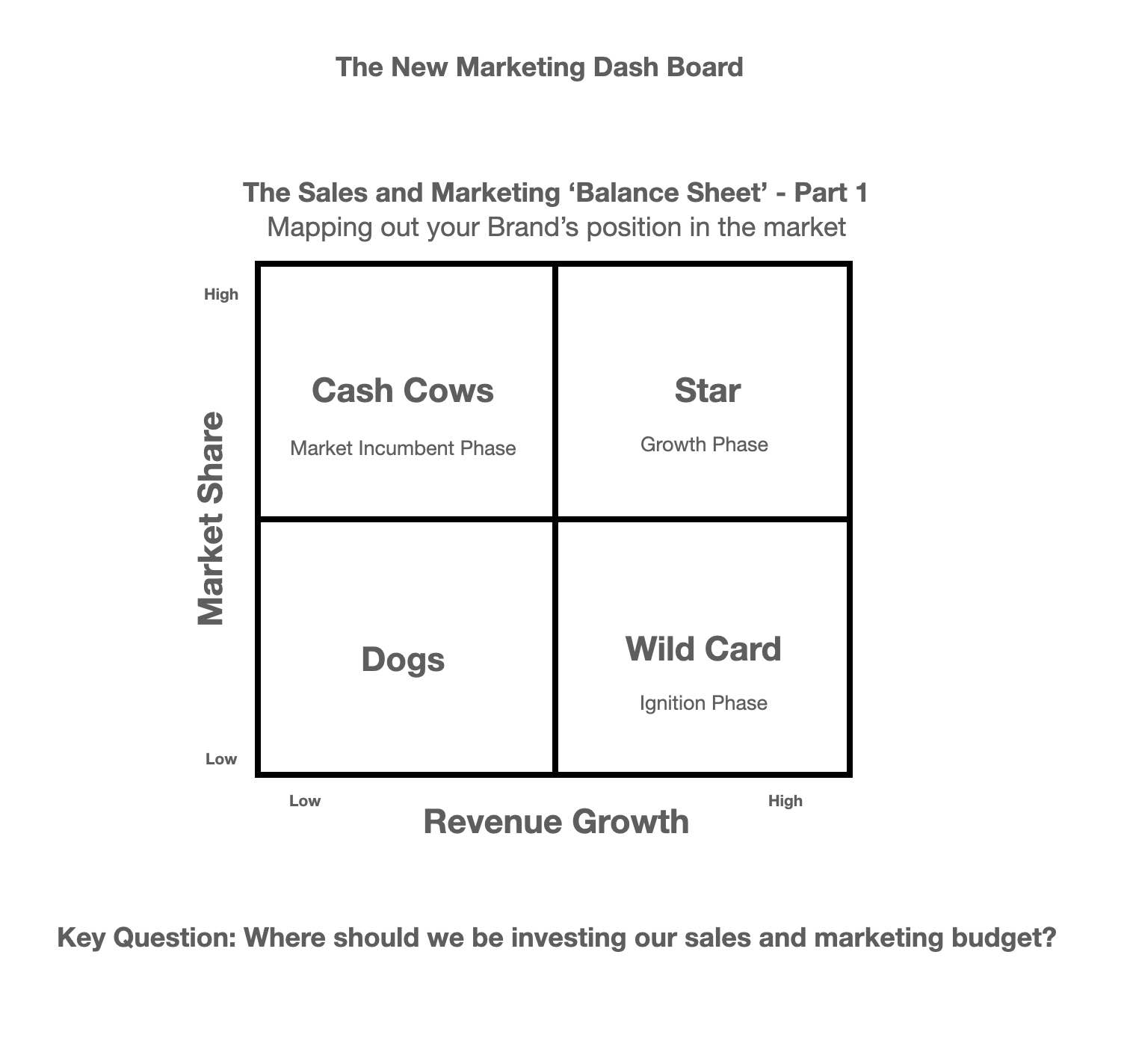
It shows us where we are in the market
and we can take that idea a step further to map how efficient we are compared to the market
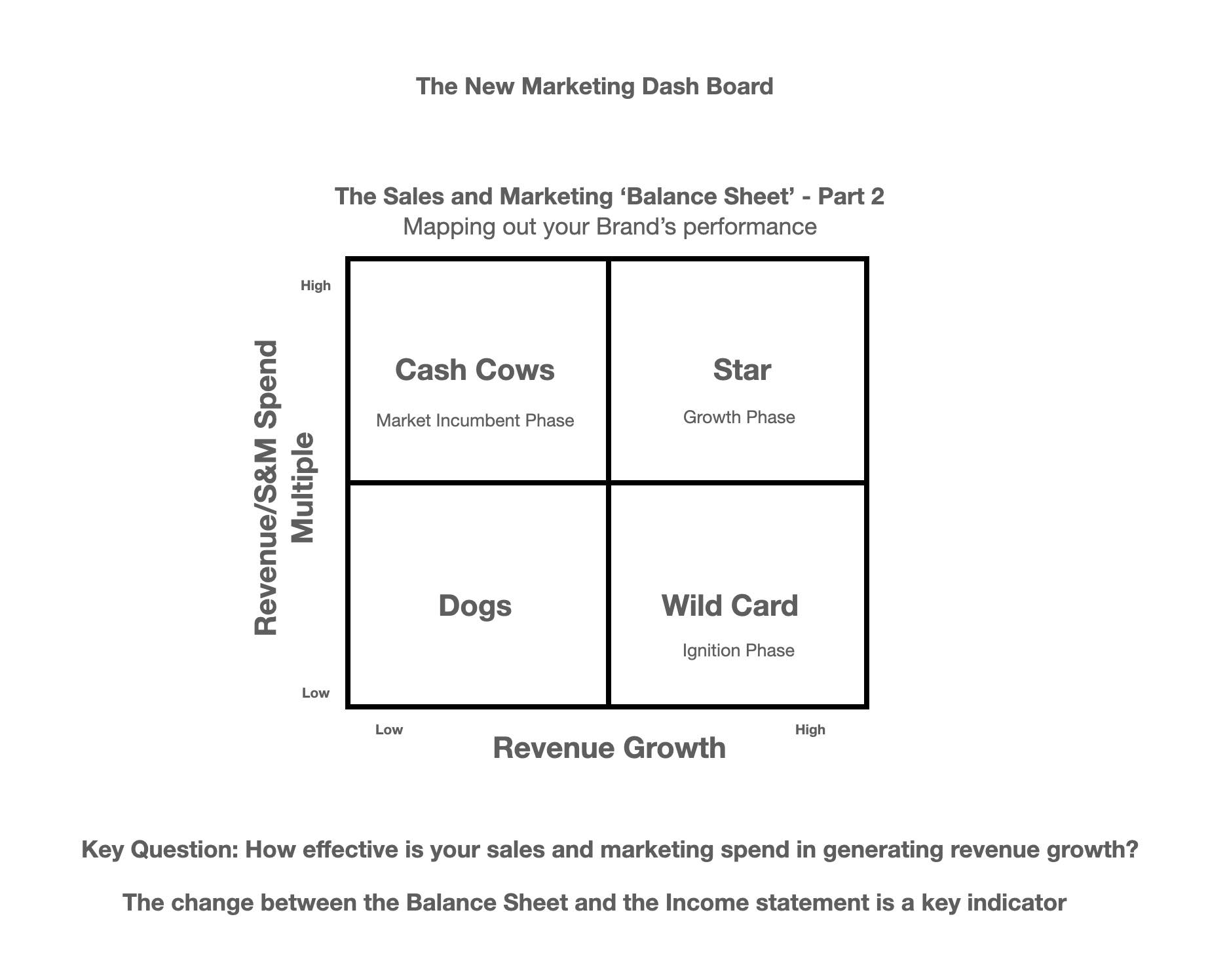
The New Marketing Operating Statement
Now we have mapped our market position let's move on to mapping the efficiency of our sales and marketing spend over the past 12 months
We can do this by comparing the change in sales and marketing expenditure with the change in revenue growth
This requires two sets of growth calculations. The first is the YoY Change in Revenue vs the change sales and marketing spend - This is the change in revenues you will find in a company's Quarterly Report
We use this as the performance benchmark across the portfolio
The next metric maps the change in the change in growth over the past 12 months vs the previous 12 months prior vs the change in spend
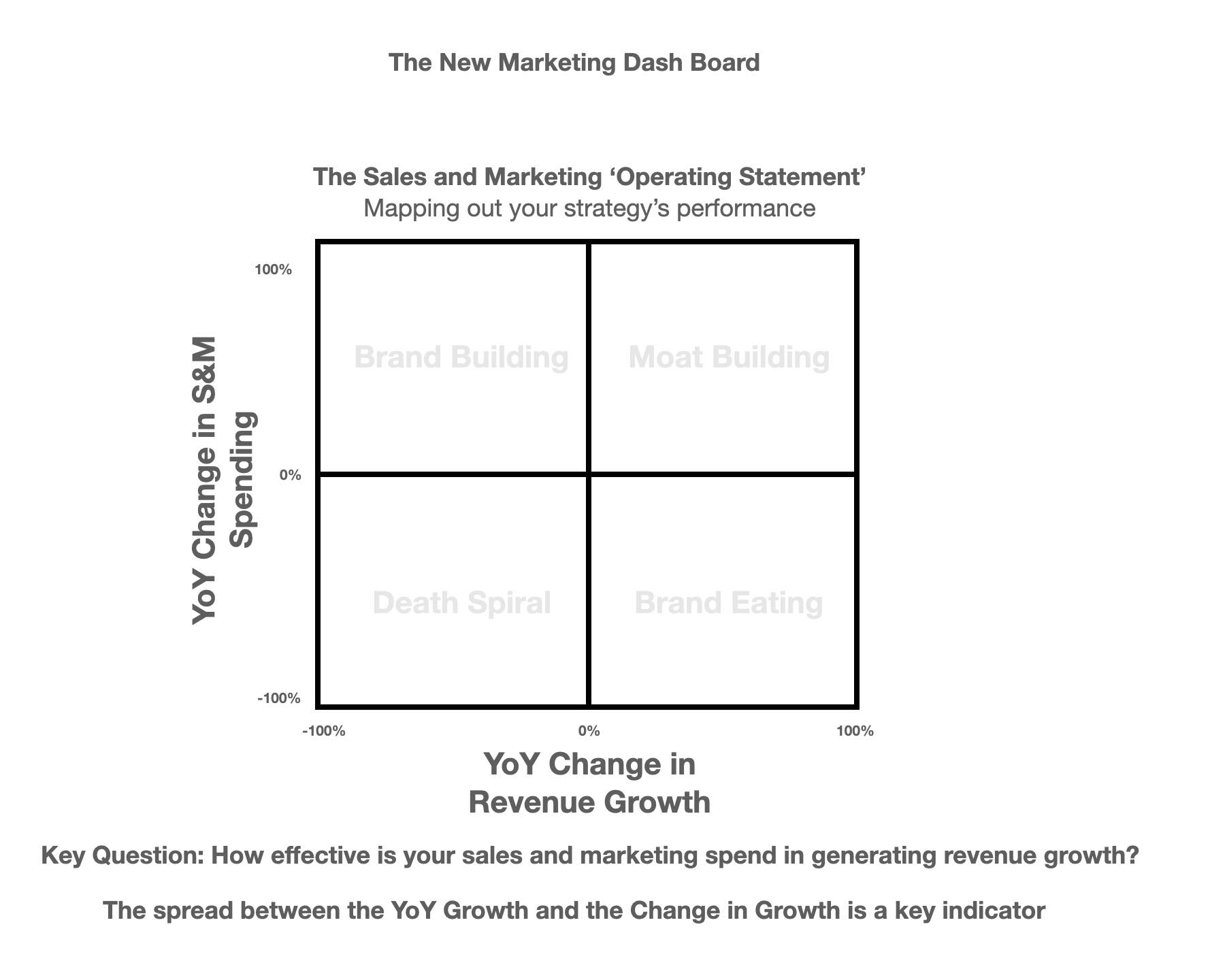
The New Marketing Cash Flow Statement
The next step is to reimagine this relative efficiency as marketing cashflow
and by that I mean. We may or may not be efficient but how effective are we in converting prospects into customers?
We begin with the phase changes. We map where we are in the market cycle
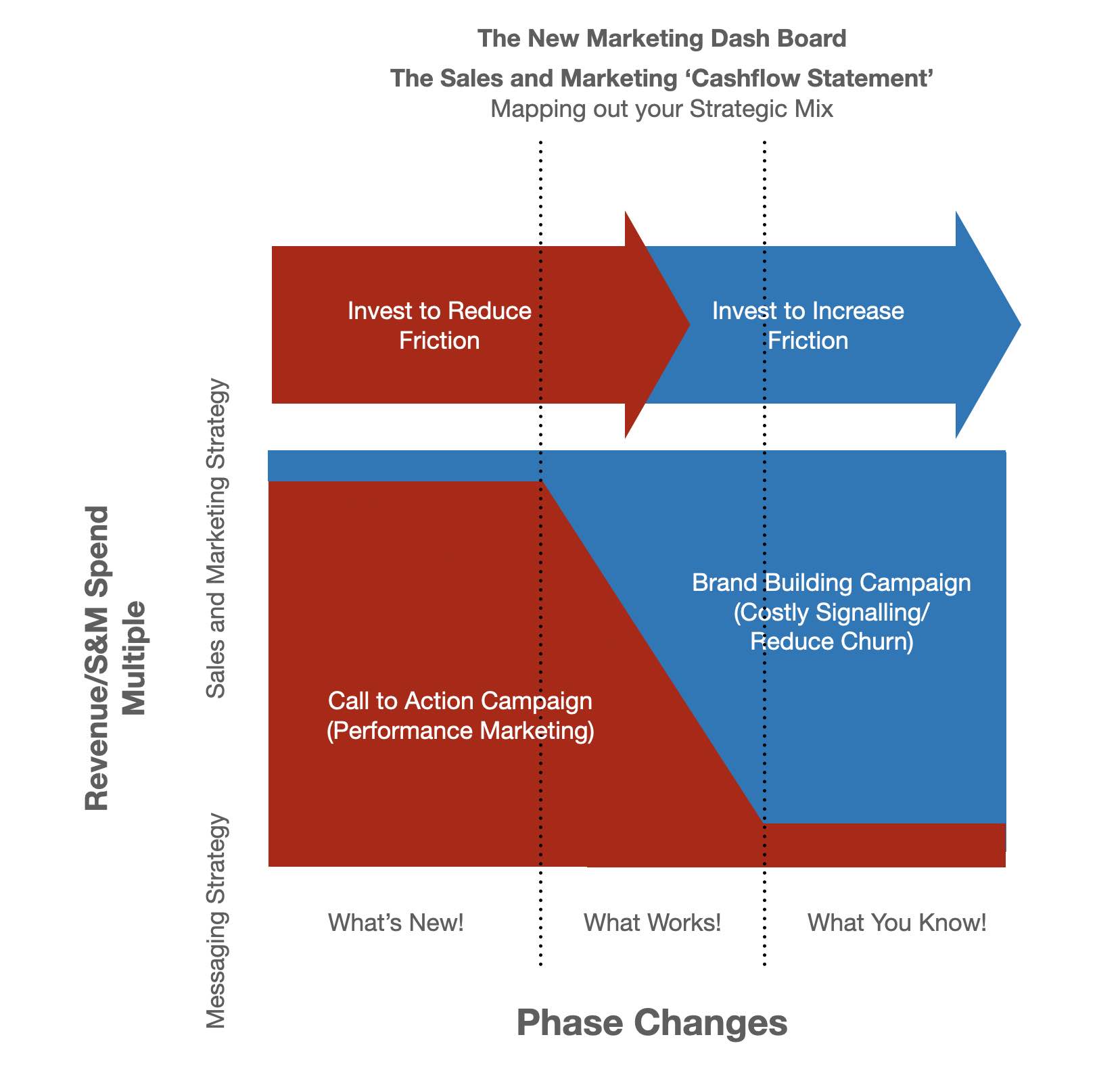
And then we move onto the hard bit. Now we must map both the phase and the efficiency to determine our relative effectiveness
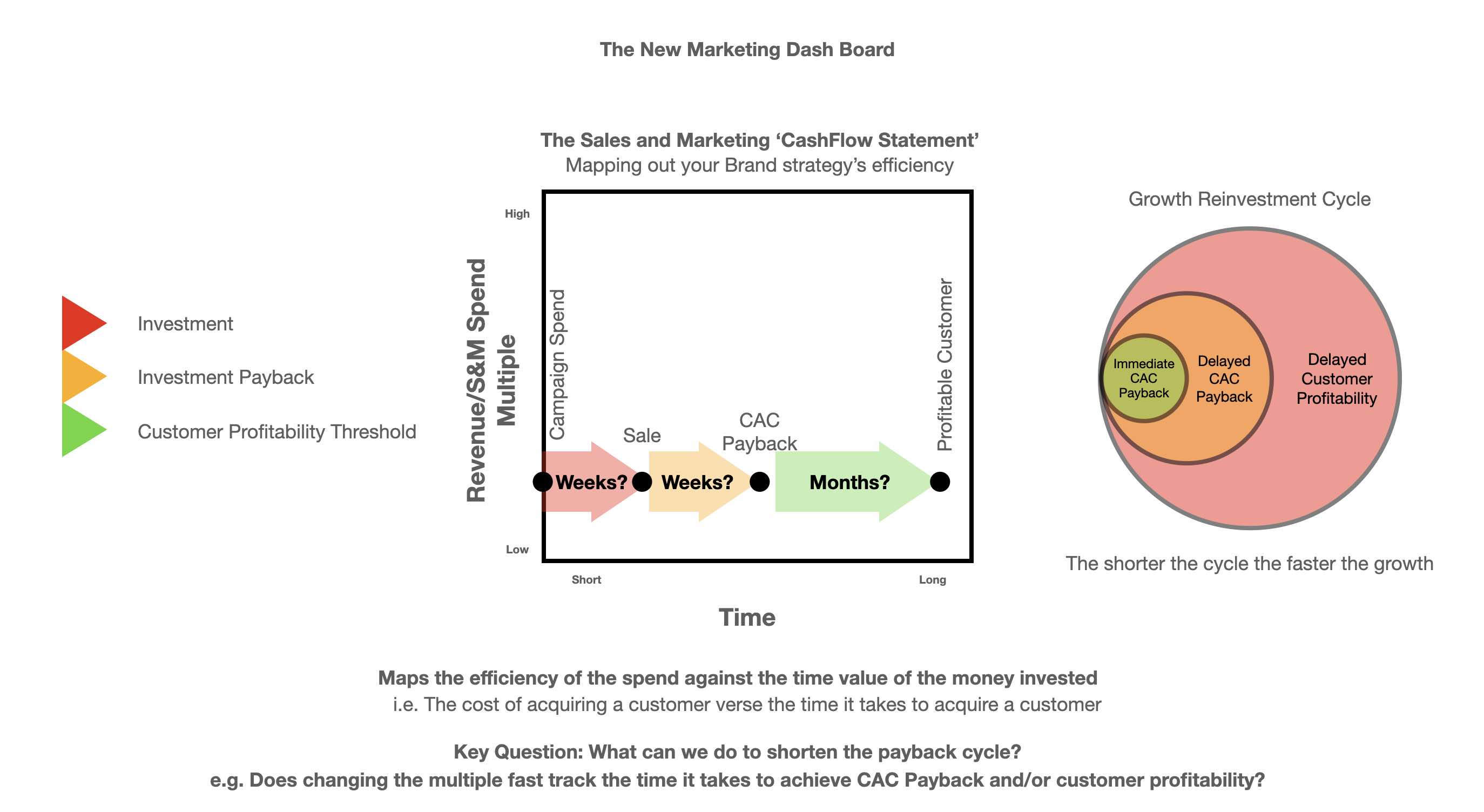
Now this idea can be expressed more simply by centering the conversion and then spliting the timeline into the funnel and payback/profitability windows
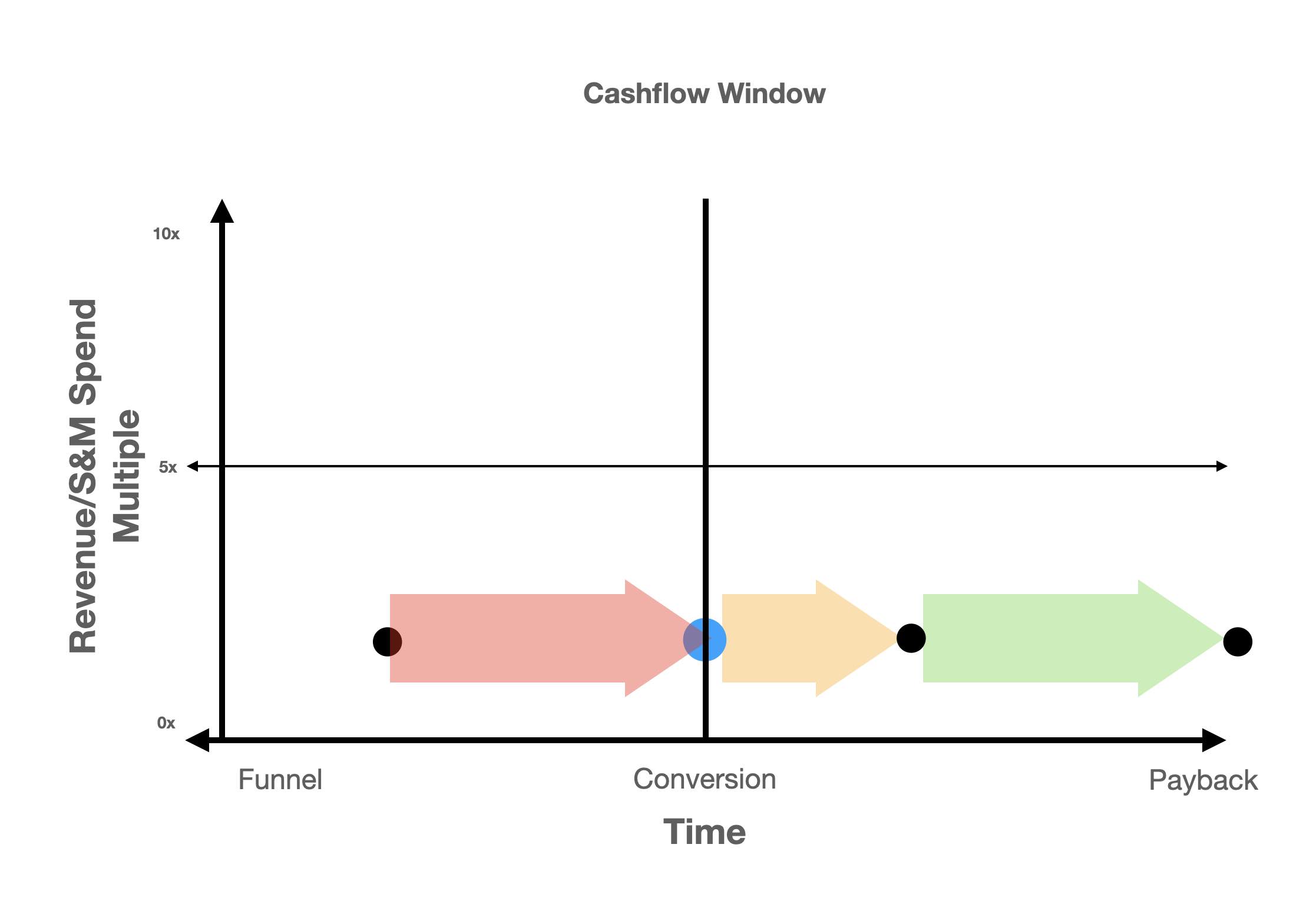
and we can take this one step further by mapping the 'Free Cashflows' - ie the profitability of the model
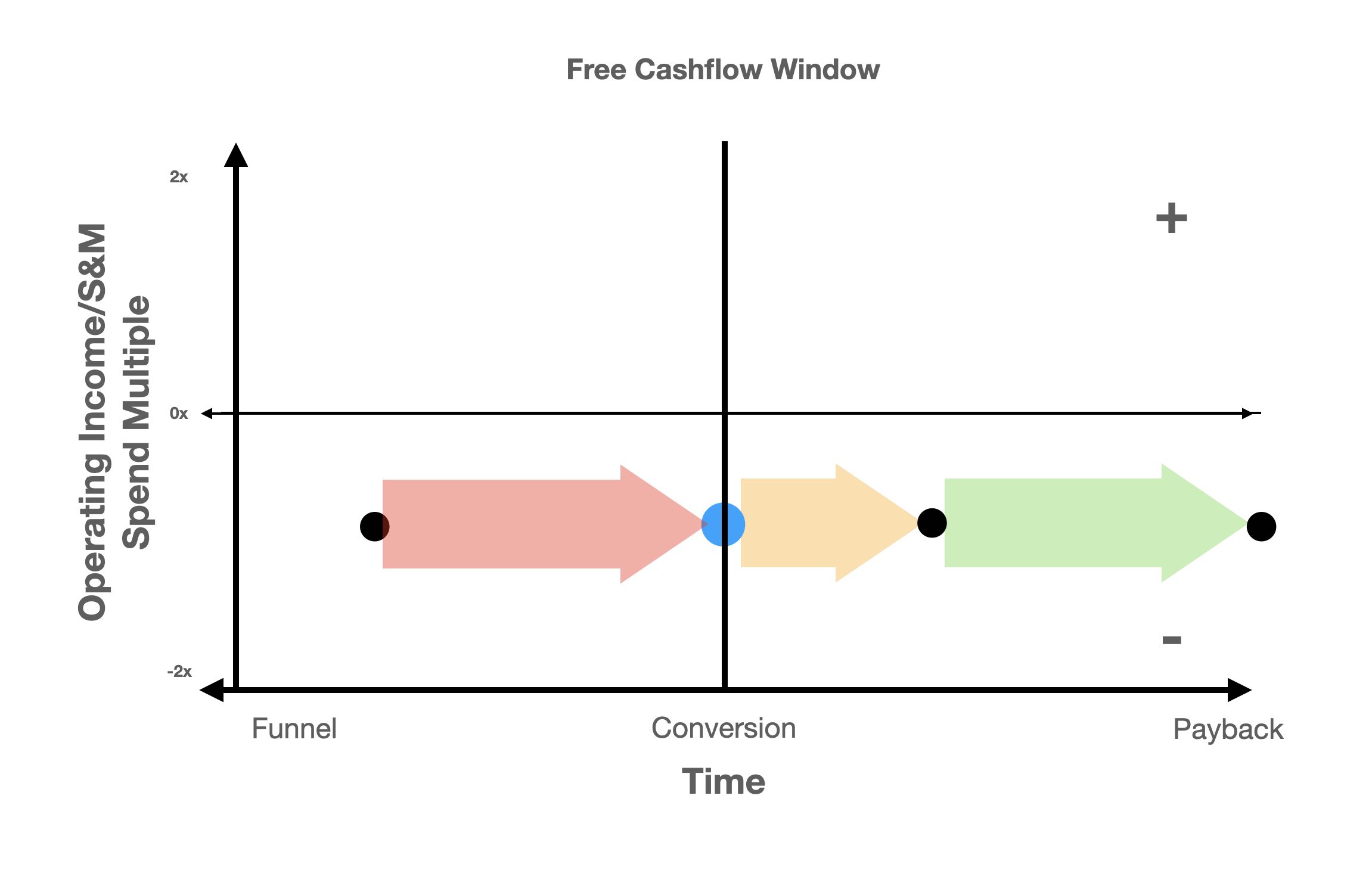
The advantage being once we have done this we can clearly see what phase of the acquisition funnel needs to be optimised to maximise the time value of the money being spent on acquiring and retaining customers
Only then do they look at the sales and marketing budget to see if it is aligned to the strategic objectives we have mapped out in the new Sales and Marketing Balance Sheet, Operating Statement and the Cashflow statement
The New Sales & Marketing Report & Budget Summary
The New Sales & Marketing Report & Budget is broken down across 4 columns
LTM - Last Twelve Months
NTM - Next Twelve Months (Forecast)
LQTR = Last 3 Months
NQTR = Next 3 Months (Forecast)
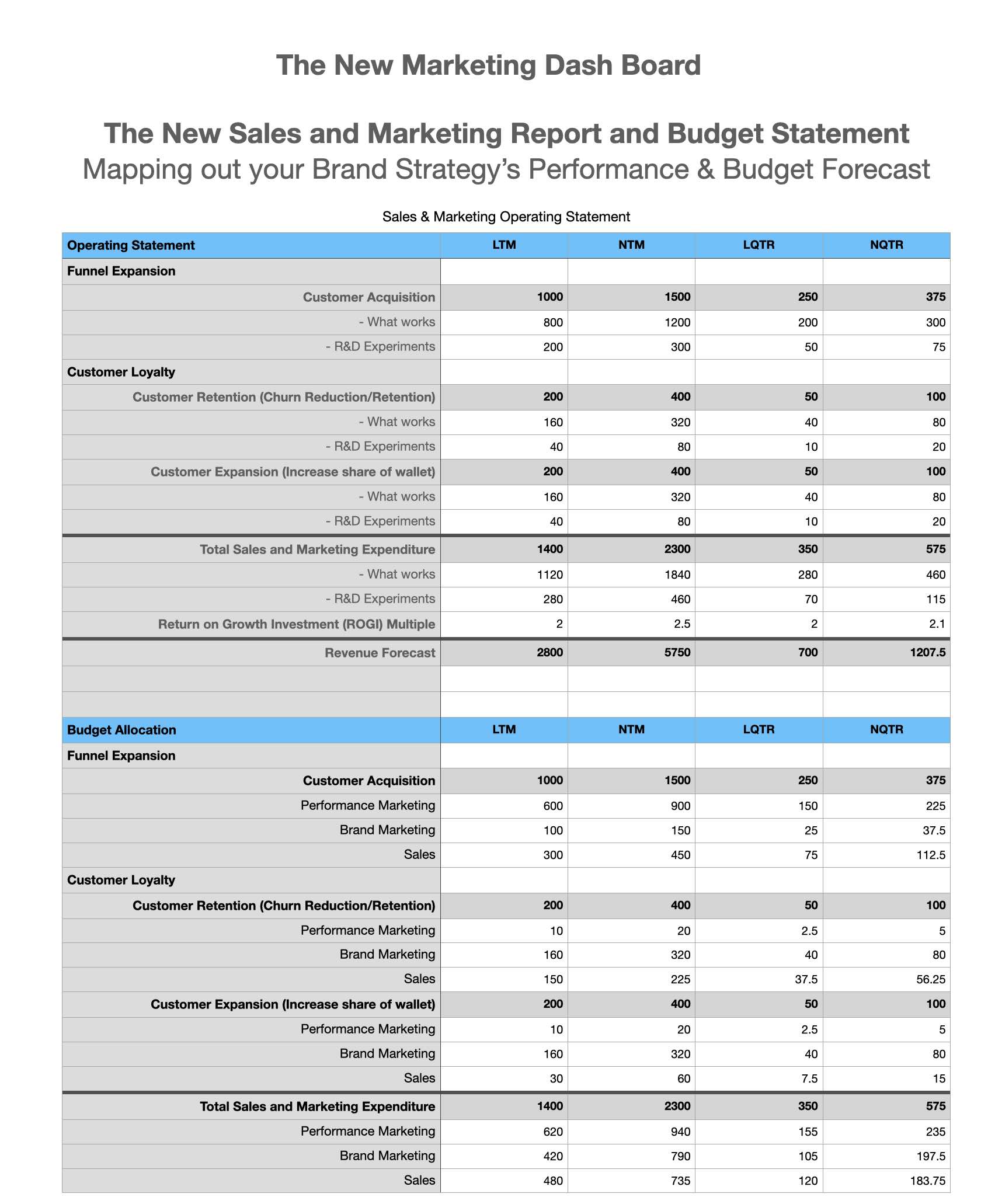
You will notice the absence of the popular marketing metrics
There is no cost per lead, no share of voice, no click through rate, on return on ads spend, no customer lifetime value, no multi-touch attribution, no bounce rate, no net present score, no brand awareness, no customer engagement, no conversion rate, no average order value, no churn rate, dwell rate, time spent on site or ARPU
All we are dealing with is optimising the time value of the money being spent on sales and marketing to the brand's growth strategy
We have redefine sales and marketing as the business of leveraging market friction to our advantage
and when we say friction we are of course talking about how we leverage trust, build trust and/or accelerate trust... to change market friction in favour of the brand
Why? Because all the CFO needs to know is why and when you need the money to achieve the growth outcome mapped to the change in phases
We have replaced the ever popular, mostly intangible, touchy feely marketing metrics with the fundamentals of portfolio management
The New Marketing Dashboard Example
Now let's take a look at this model in action
The Balance Sheet
We'll compare Oracle (the enterprise database incumbent) with Snowflake (the cloud distruptor)
First the Balance Sheet/Boston Box
We see that Oracle has 20% market share and 18% YoY Growth while Snowflake has 2% market share at 69% YoY Growth
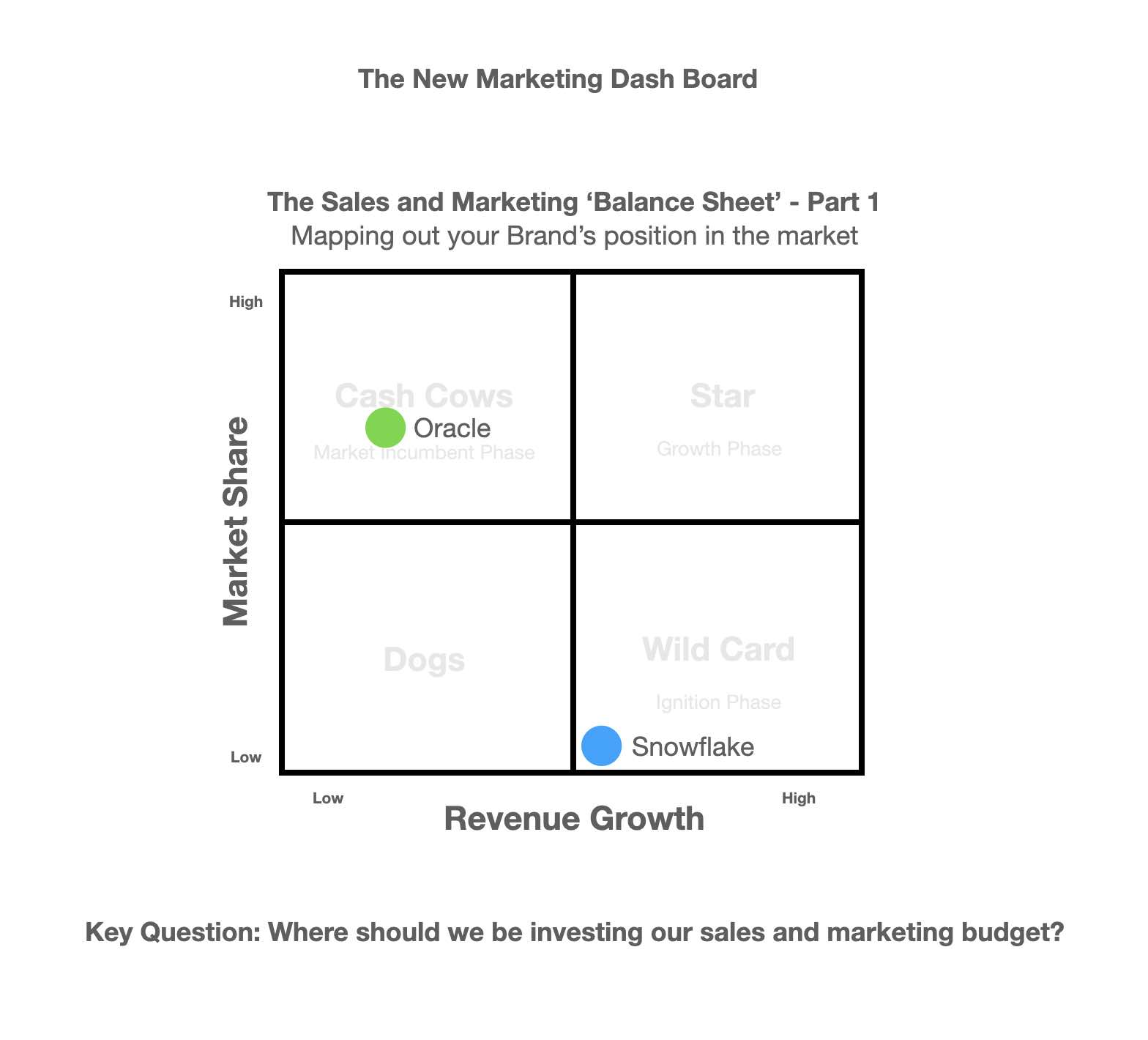
Next the Balance Sheet adjusted to reflect brand efficiency
We see very little variance between the two Balance Sheets but it appears Snowflake's Rev/S&M Multiple of 1.9x is slightly higher than anticipated
Oracle has a REV/S&M Multiple of 5.7x.
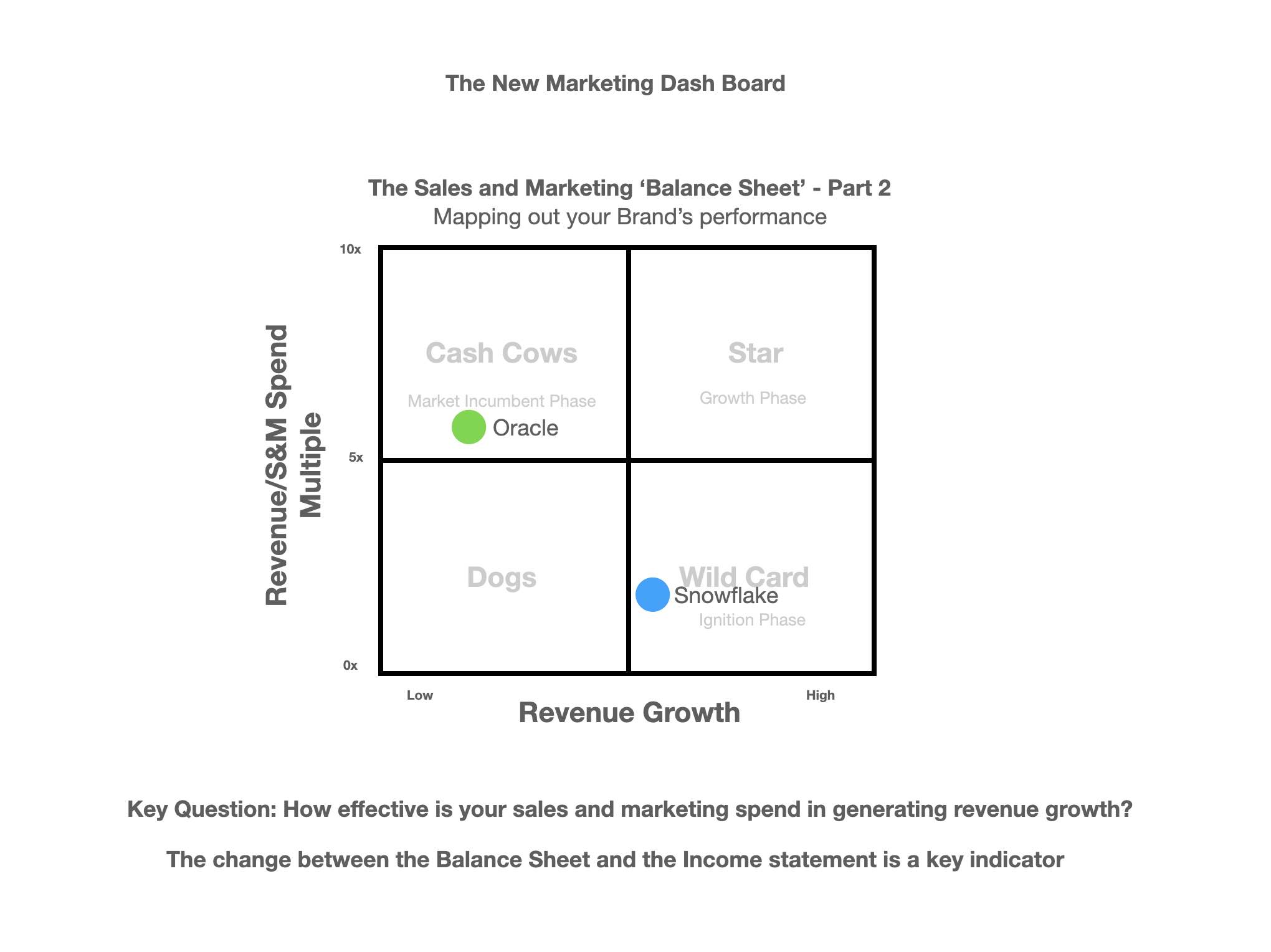
The Operating Statement
Now let's take a look at the "Operating Statement'
The darker dot represents the change in growth over the past 12 months vs the previous 12 months prior vs the change in spend
The lighter dot reprsents the YoY revenue growth vs change in spending (ie benchmark)
We can see Oracle's investment in maintaining its moat
While Snowflake is investing more in sales and marketing to build its brand even as its growth rapidly fades
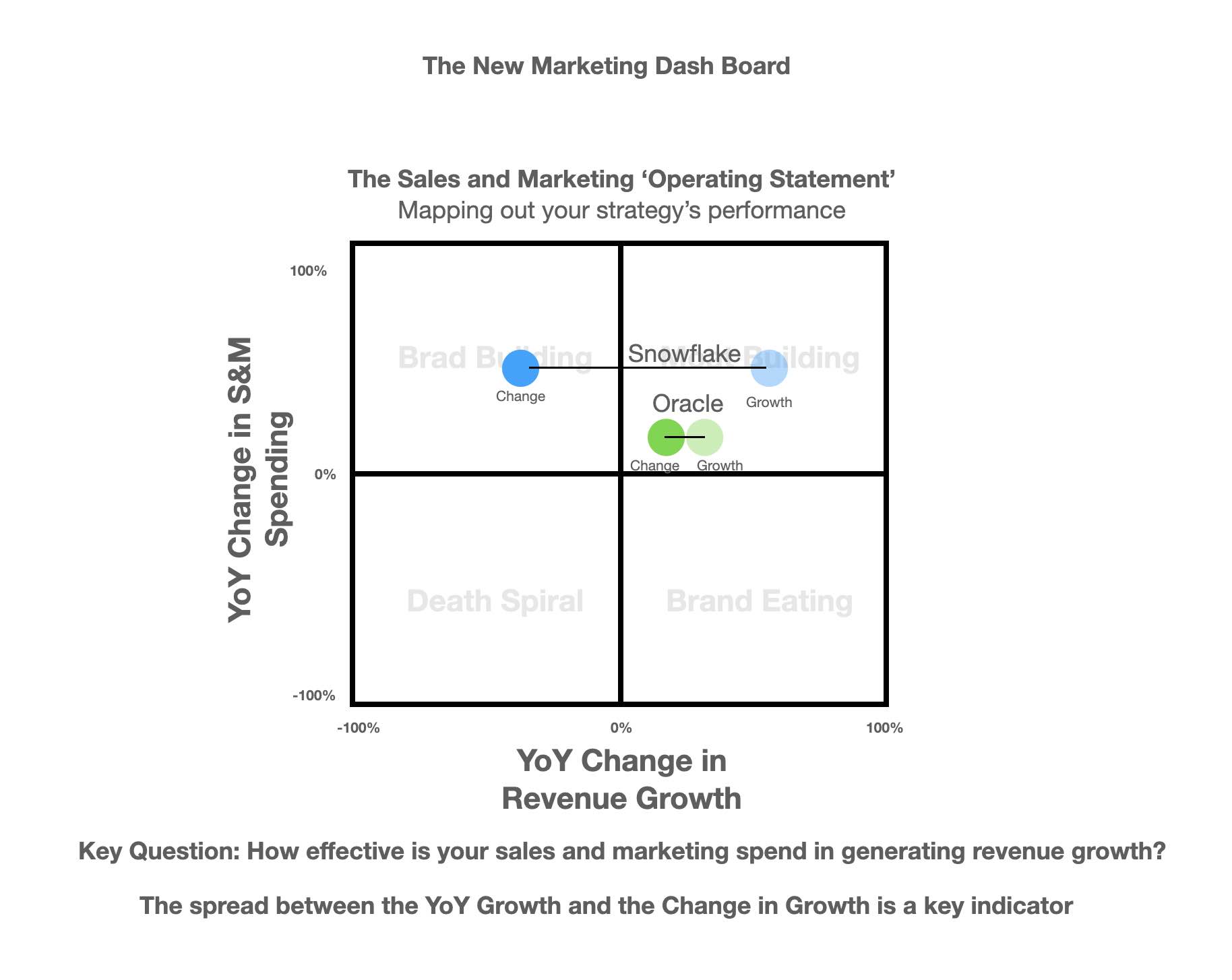
The CashFlow Statement
Finally let's tale a look at the 'Cashflow Statement'
We can see how the incumbent is leveraging its trusted brand to add market friction while reducing its sales cycle and roadmap to customer profitability
Meanwhile the disruptor is challenged with removing friction from the equation
The market challenge is reducing the time and cost it takes to gain the customer's trust
Plus the added burden of subsiding the customer's usage post sale through the cloud subscription model
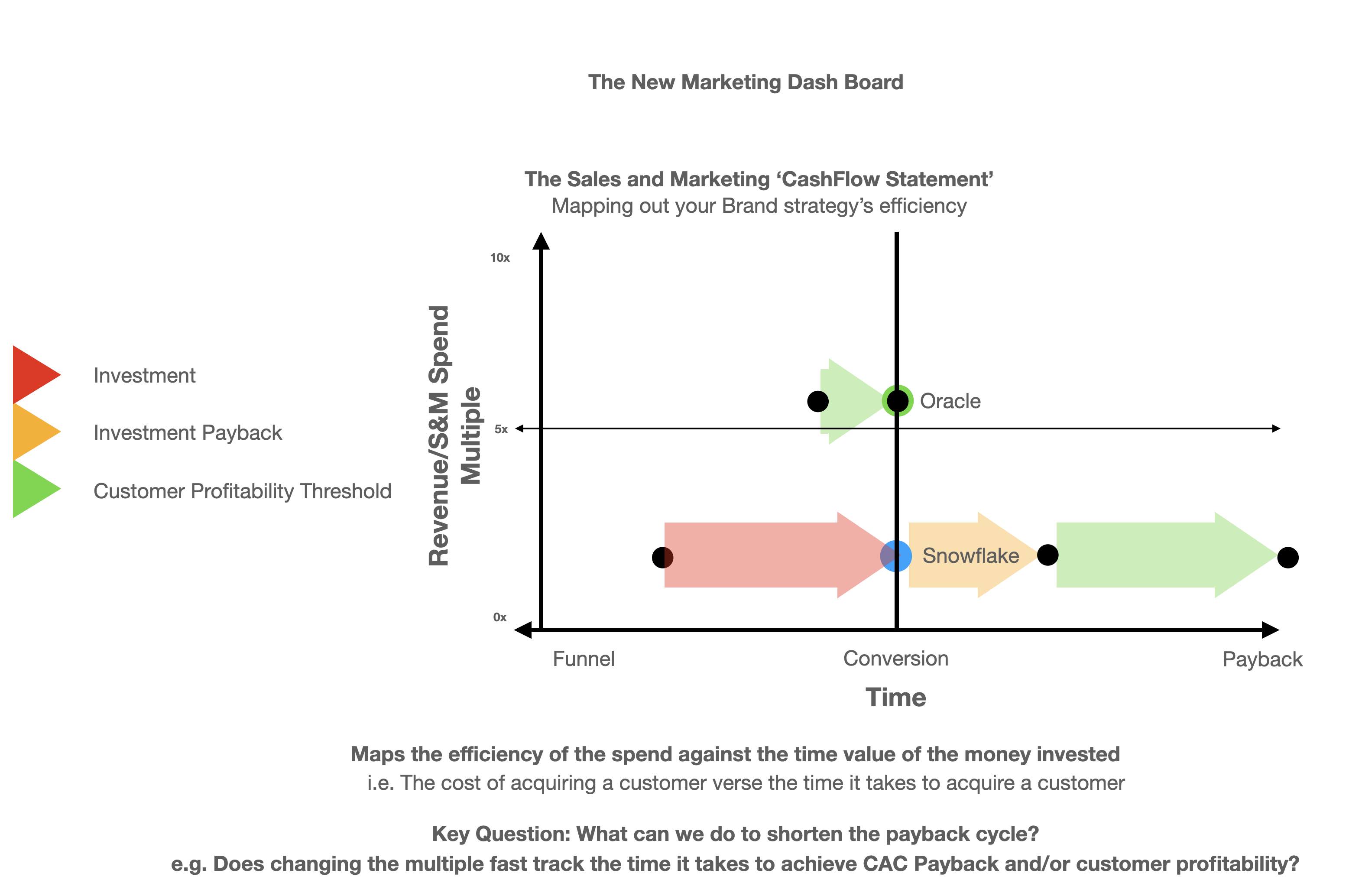
We can take this 'cashflow' map one step further by switching the variable in the Rev vs S&M Spend calculation from Revenue to Operating Income or 'Profit'
Once we do this we can get some insight into each company's relative ability to generate 'free cashflow' from their sales and marketing efforts
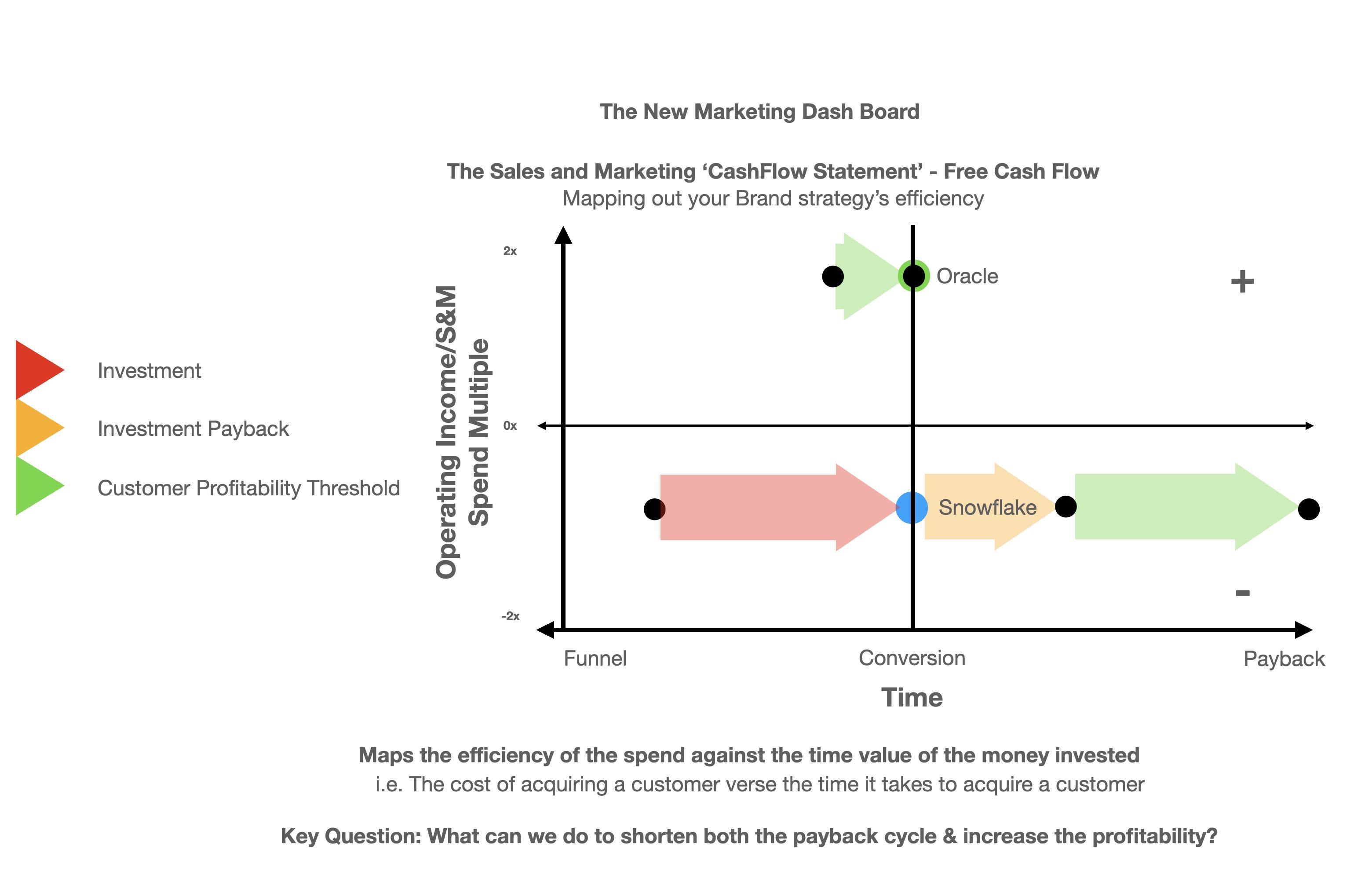
Summary
The 5 charts reveal the strategic challenge facing the two CMO's - The incumbent and the challenger
One is seeking funds to add friction to the market. The other is seeking funds to remove friction
In each case the optimal strategy will be an investment in 'Costly Signalling'
Costily Signalling Theory proposes that expensive and/or wasteful behavioural signals like those seen in nature (e.g. the male peacock’s tail serves as an indicator of sexual fitness, increasing its chances of reproductive success) serve to instil trust between the signaller and observer
The reason being an investment in 'Costly Signalling' derisks the choice for the prospective buyer
The key question for the disruptor being will increasing the Sales and Marketing spend and investing 'costly signalling' decrease the amount of time it takes to close the sale?
Will spending more on the brand image and signalling a higher level of investment in building trust improve the time value of the money invested?
These are the deeper questions of strategy facing both players... as they map the terrain and pick their battles...
Understand this and you'll understand why the wider debate over performance marketing vs. branding is not so much redundant as totally naive
i.e. What's the point in counting the number of shots fired when you don't even know where you are standing on the battlefield?
Phase 8 - Fulcrum Marketing
This series describing the Phase Changers began with a simple question: What if our ideas about marketing are all wrong?
What if the 4 P's, the product adoption cycle, the S Curve and the 60:40 Marketing Mix are fundamentally flawed ways of thinking about how it all works?
Imagine...
and yes, it's very hard to do...
If the 4p's...

...looked more like the 2IC's

and how would that fundamentally change the way we measure success in the world of marketing?
This post is an attempt to close out that question (and clear up some of the confusion around Part 6 of the Phase Changes series) by introducing a new marketing funnel based on leveraging - or more accurately pivoting - the Phase Changes
At the core of Part 6 of the Phase Changes was this idea:
The common interpretation of the role of marketing when you have Market Leadership is building and maintaining a moat
But in that post I demonstrated how you could turn the Phase Changes matrix on its head... and once you do that you discover market leadership is best understood as a sink hole that the market gravitates towards and falls into rather than a mountain that needs to be climbed
The challenge then becomes one of making the edge of the funnel wide and frictionless so the market slips and falls in
Less a matter of brand building and more a matter of inviting the market to slide into your hands
In this post I will attempt to clean up that idea and make it more accessible to the average reader
Let's begin the thought experiment by saying anybody in the marketing game will know Sales and Marketing Models are a dime a dozen
For the most part they are designed to stimulate discussion rather than offer a practical guide
Within this broader context the model I am introducing here is no different
It's about prompting the question: What happens if we change our way of thinking?
In the 21st Century there has been a Cambria explosion in new ways of thinking, about how the customer thinks, they think, about thinking, when it comes to thinking, about thinking, about brands
BTW: See Ged Carroll's Notes on this topic
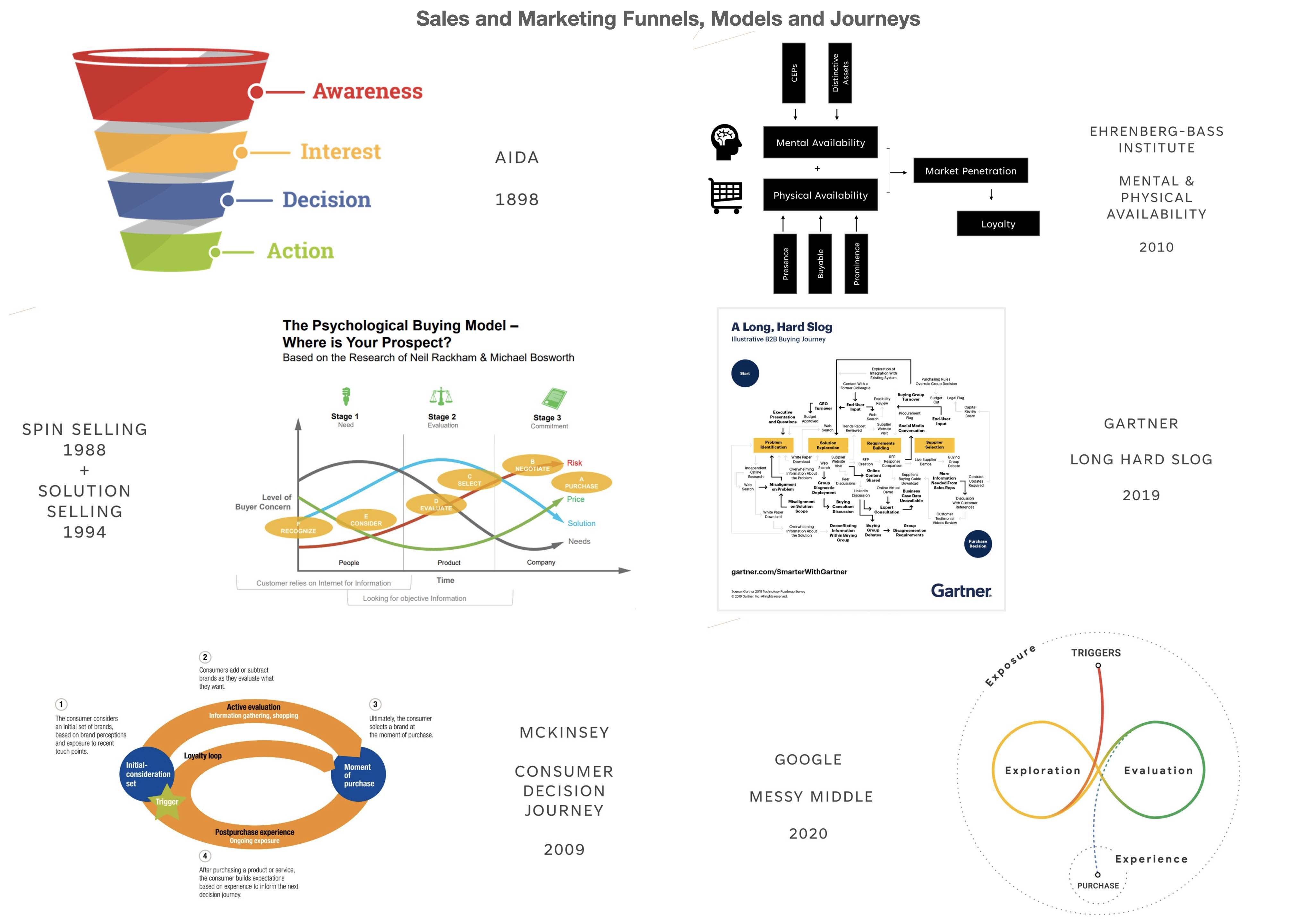
So how will adding another one into the mix change the way marketers think, about how the customer thinks, they think, about thinking, when it comes to thinking, about thinking, about brands?
Well let's try changing the game by changing the story and see what happens
The Phase Changes
The Phase Changes look like this
The underlying assumption is sales and marketing is about reducing or adding friction in the buyers mind (and across the market) to create the catalyst for a phase change

Again see here if you need a more detailed understanding of how the Phase Changes work
Now let's reimagine the challenge as a process loop
The undecided prospect occupies a place of inertia at one end of the loop
The loyal customer occuplies a place of inertia at the other end of the loop
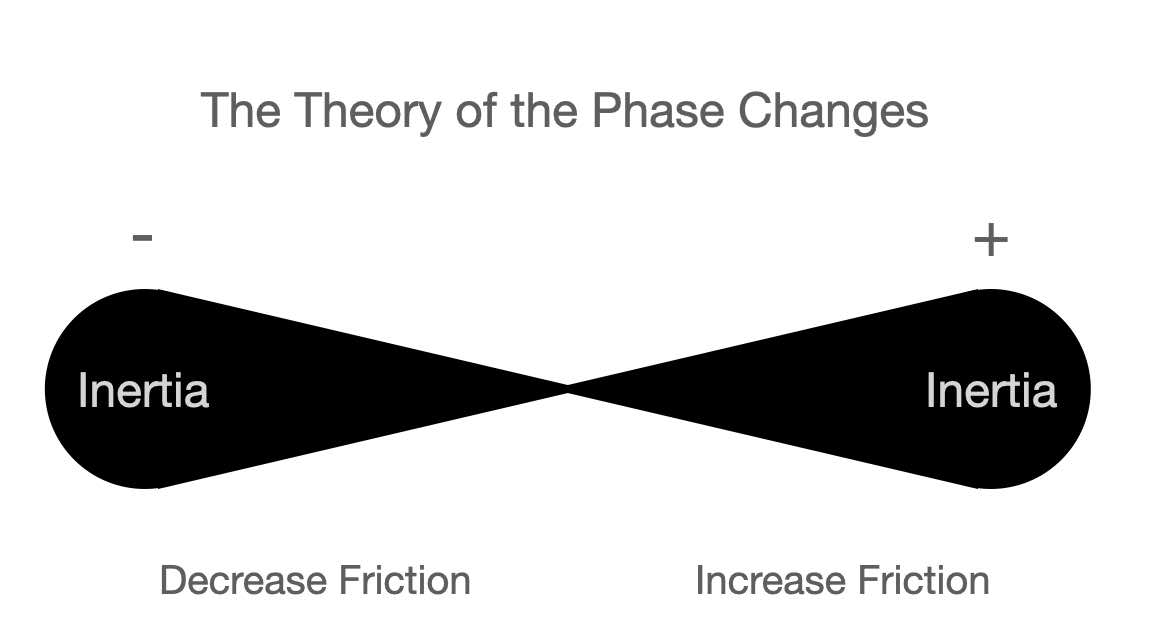
Obviously there are more prospects than paying customers... so we need to adjust the weightings to illustrate this
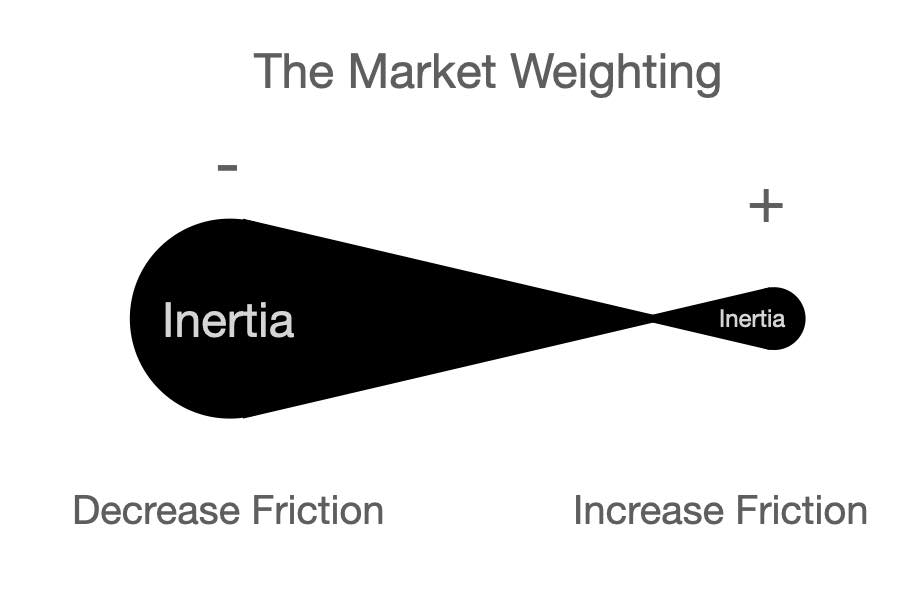
The sales and marketing challenge is to motivate the prospect to move from one side to the other
From negative to positive
and then get them to stick around
But hang on, because it isn't that simple
We need to demonstrate the impact of friction across the 'Egg Timer' loop
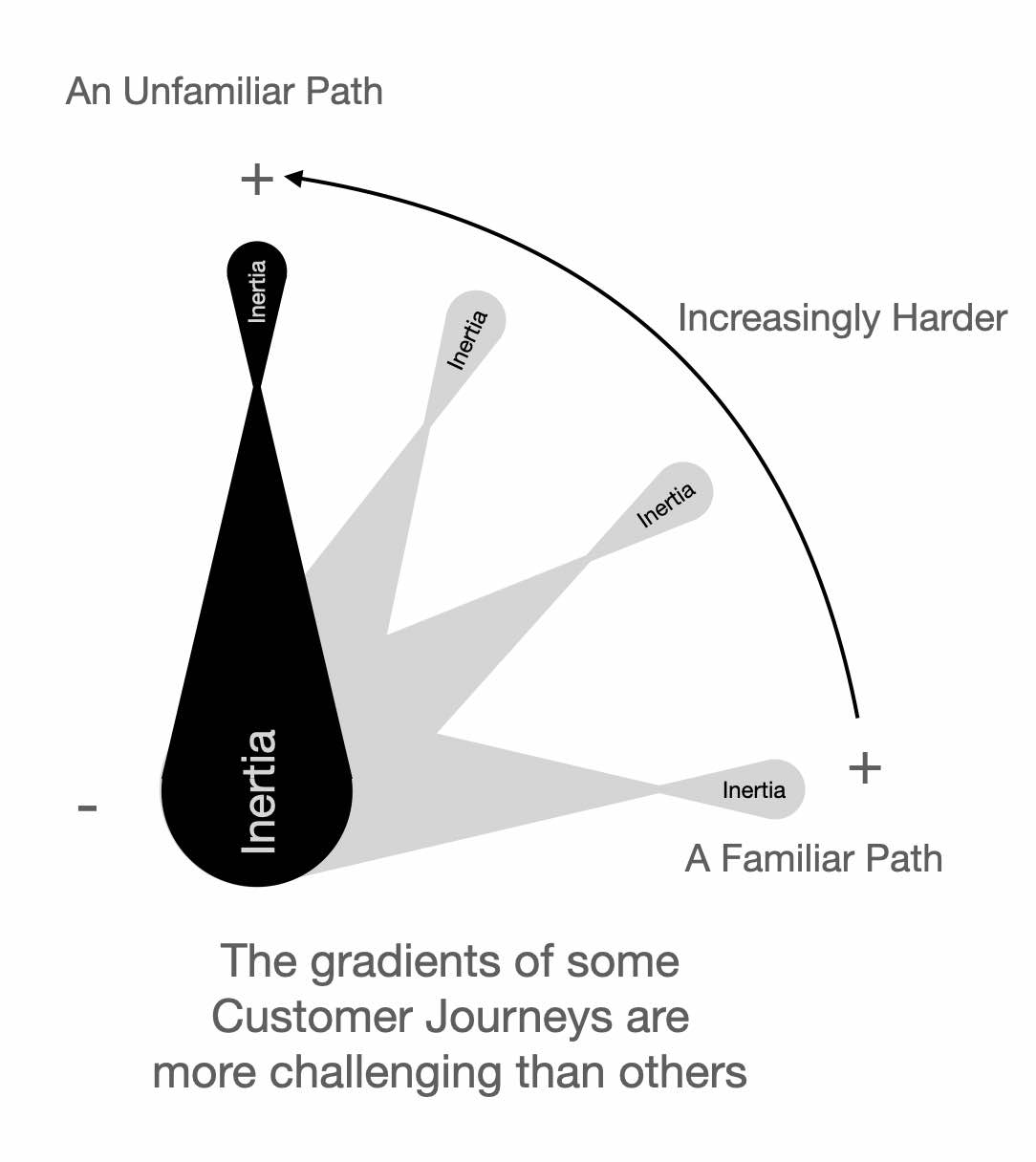
As we can see different customers have different journeys. The climb for some is much harder than others
The same can be said for the Brands. When you are up against the market leader your challenge is obviously much harder than if you are the market leader
Now let's add the key components required to motivate the prospect to make the uphill journey towards buying the product or service
We need to motivate the prospect. We need to give them a reason to move, we need to give them a reason to cross the chasm and we need to give them a reason to stay once they get there
- and the only tools we have at our disposal is a tigger, a story and a reward
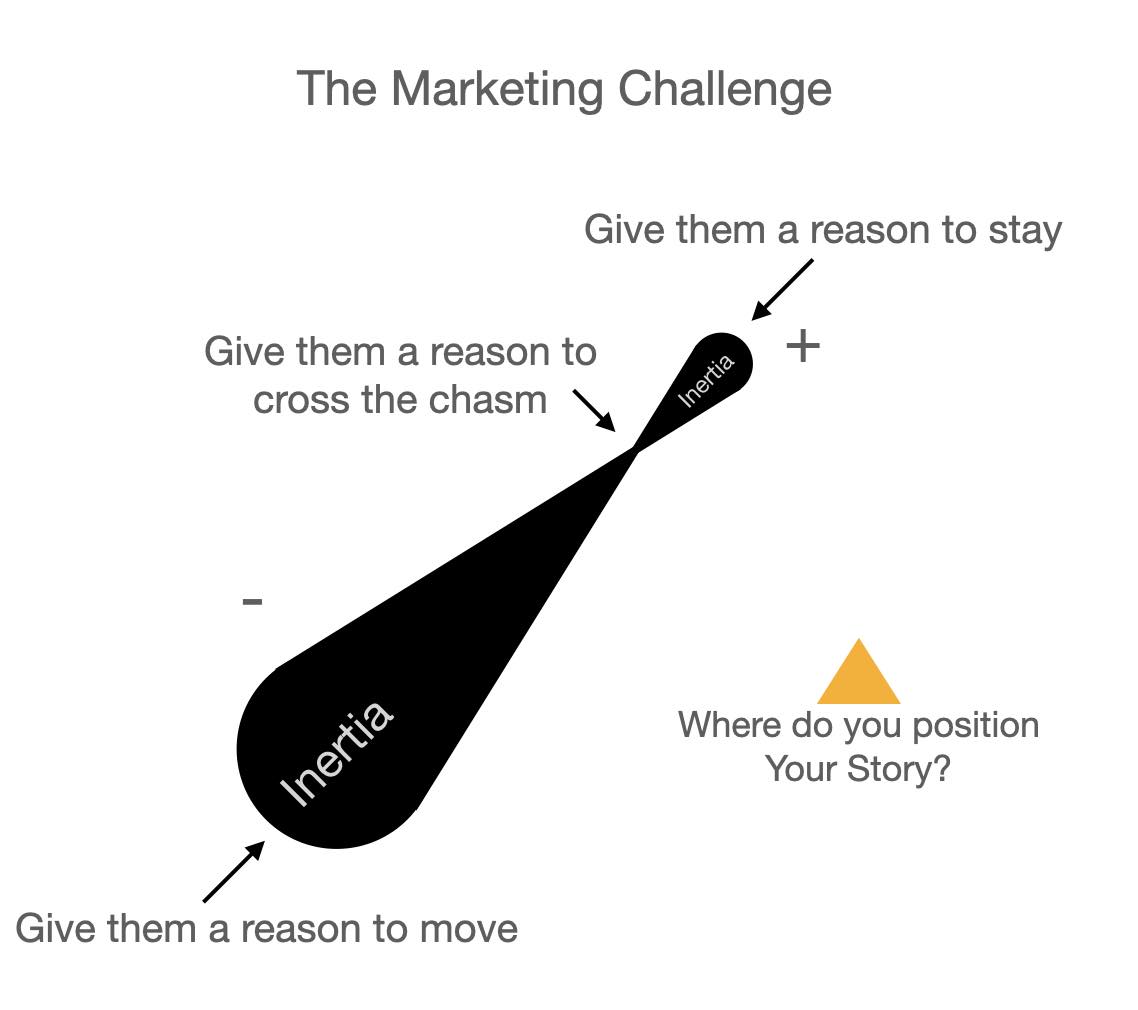
Now arguably we can see the marketing challenge more clearly
Not only do you need to get the prospect moving, they also have to encourage them to climb a mountain to get to the top where you are sitting waiting for them to join your band of loyal customers
The key to understanding the model is to recognise the role of the STORY as the FULCRUM : ie the point against which the 'Egg Timer' is placed to get a purchase, or on which it turns or is supported
The trick is knowing where to place (think: position) the story to achieve maximum leverage to tip the balance of the 'Egg Timer' in your favour
OK. Now we understand the scope of the challenge let's see how the different marketing strategies shape up trying to solve it
Performance Marketing
Today an increasing number of clever marketeers have cottoned onto the revelation: why do we need to talk to everybody when it is cheaper and more efficient to focus all our attention on those how have already made the journey up the hill and are ready to cross the chasm?
We call this performance marketing
It is the latest iteration of target marketing... and it is best understood as the sport of shooting fish in barrel
Success is easily quantified and can be measured endlessly... and it works just fine so long as somebody is wasting their time and money putting more fish in the barrel for you to aim at
This is what performance marketing looks like in our new model
You can see how the story is positioned at the choke point - chasm - just before the customer makes the decision to buy
The 'Egg Timer' is still balanced in favour of market inertia
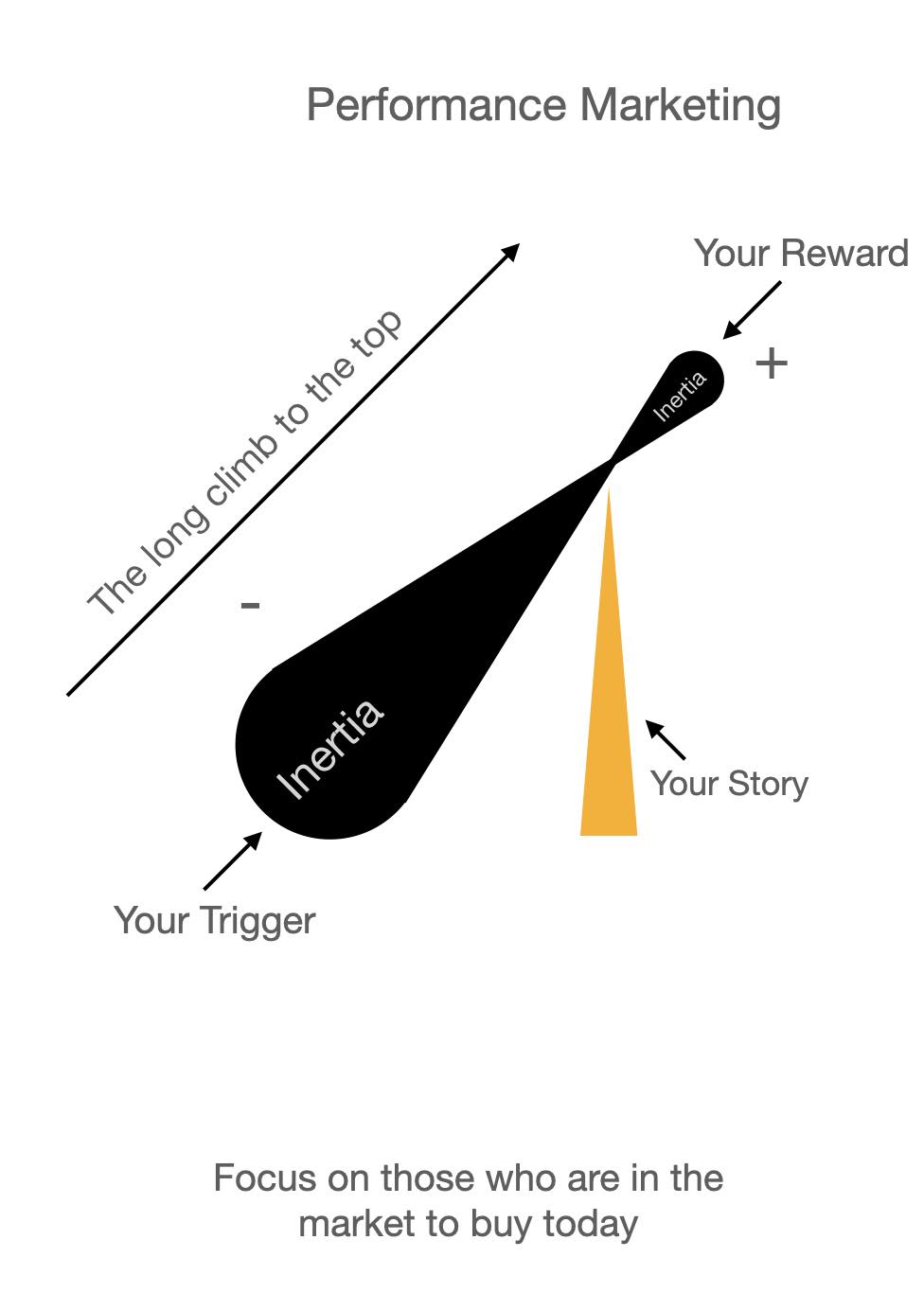
Costly Signalling
The other popular strategy is called Brand Marketing - but within the context of this new model it is the wrong term
We are going to call it 'Costly Signalling' because that is exactly what it is
BTW: For those on the outer Costly Signalling Theory proposes that expensive and/or wasteful behavioural signals like those seen in nature (e.g. the male peacock’s tail serves as an indicator of sexual fitness, increasing its chances of reproductive success) serve to instil trust between the signaller and observer. The signal is the attraction
It is the Sales and Marketing equivalent of that Hollywood Classic 'Field of Dreams' (ie. 'Build it and they will come')
Take a look at the model and you'll see the story is now positioned on the wrong side of the chasm - This is of course illogical
Because the 'Egg Timer' is still balanced in favour of market inertia
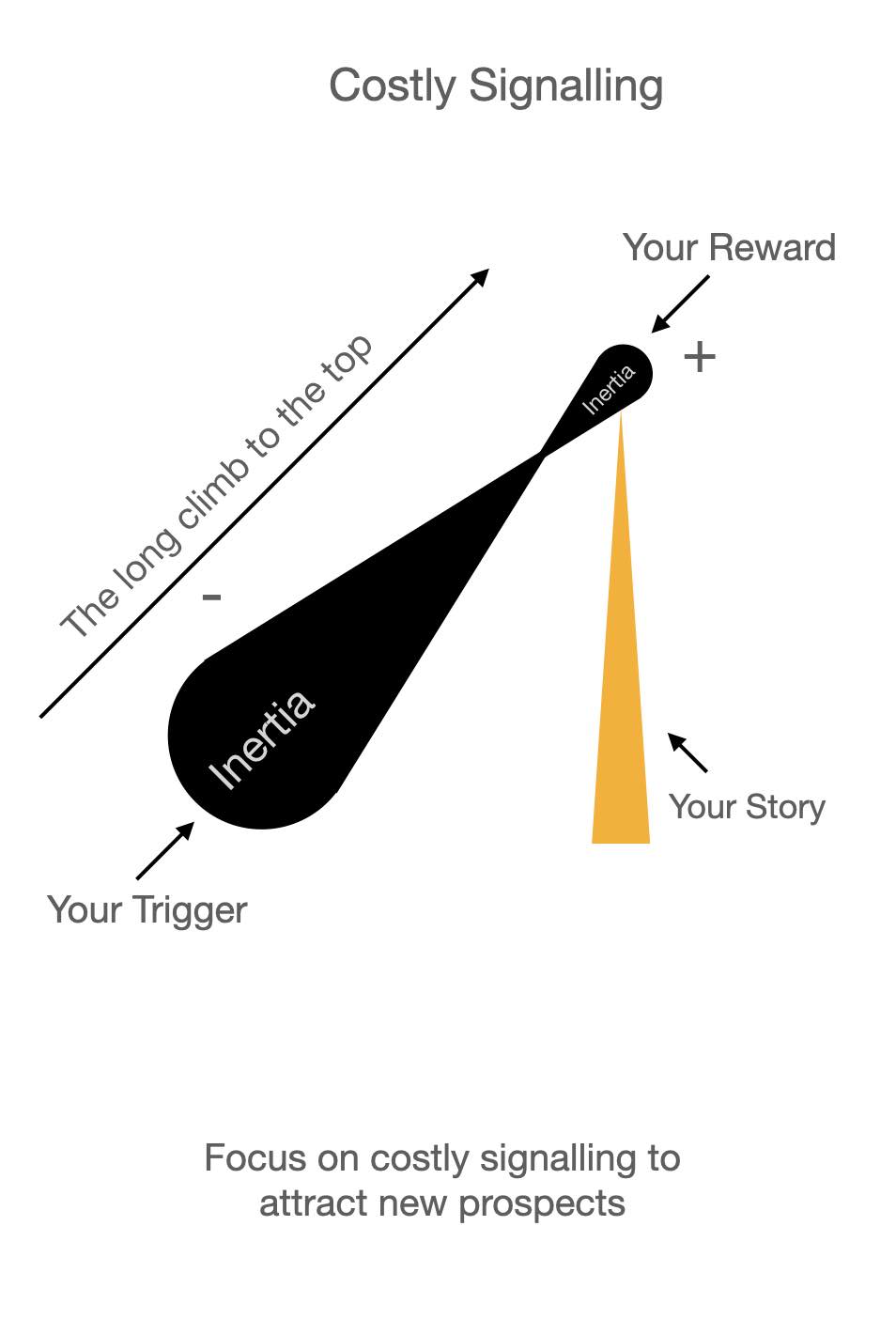
Fulcrum Marketing
OK. Now let's introduce a new idea
And... Let's call it Fulcrum Marketing
and as the name suggests it's all about pivoting the "Egg Timer" on its head
Here's how it works
When you look at the model where is the most logical place to position the story to tip the "Egg Timer" loop in your favour?
Scroll down to discover the answer
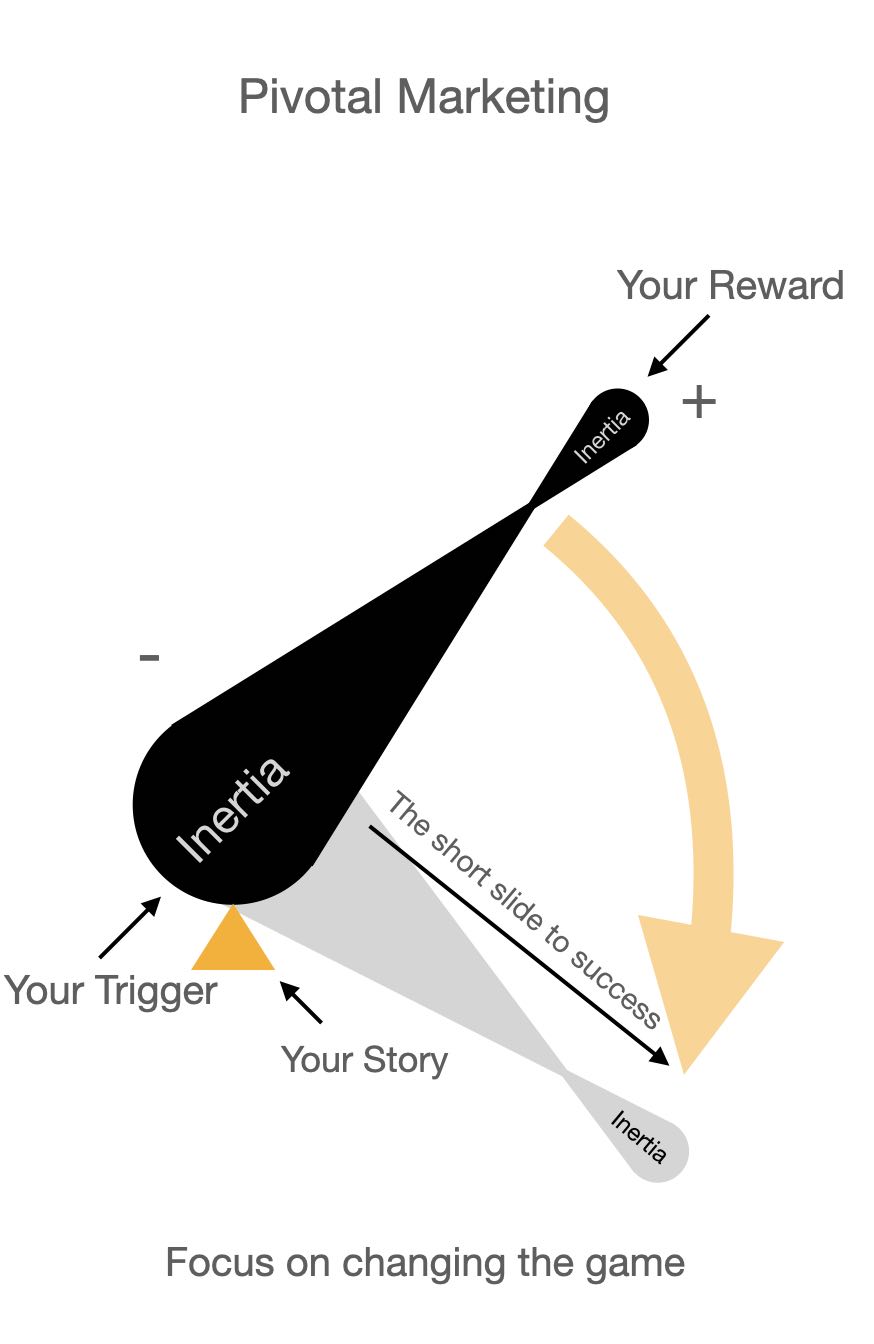
The optimal position in the model is at the base
Why? because it only takes a little bit of movement by the prospect to unbalance the 'Egg Timer' and tip the funnel in your favour
What was a hard climb to discover enlightment becomes a slippery slide into the arms of nirvana
We have leveraged the laws of gravity to our advantage to tumble the prospect through the pinch point and across the chasm
The trick of course is how you juxtapose the trigger, the story and the reward to ignite the shift in behaviour
- and yes, I have covered those ideas in more detail in Stories, Players and Games & Hooks, Responses and Rewards
Brand Marketing
And that leads us to our final strategy within the confines of the model - Brand Management
With in the context of this model Brand Marketing is the gentle balancing act of holding the 'Egg Timer' in place so the market continues to fall into your 'trap'
But it is only useful once you have achieved the pivot...
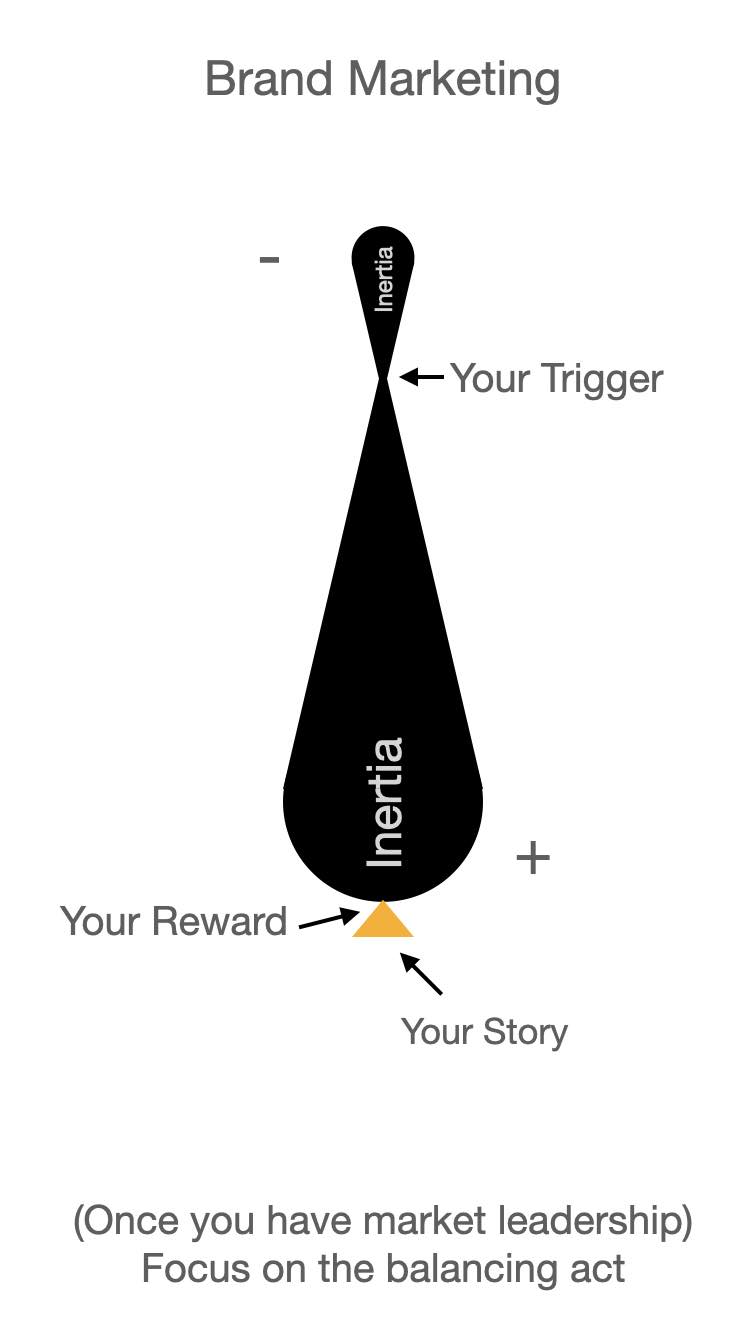
Summary
We can now see how - at least within the confines of this new marketing funnel - the debate between Performance Marketing and Brand Marketing is largely redundant
Simply because Performance Marketing is to Fulcrum Marketing what Shooting Fish in Barrel is to Deep Sea Trawling
It is the debate you have when you don't really understand the fundamentals of marketing
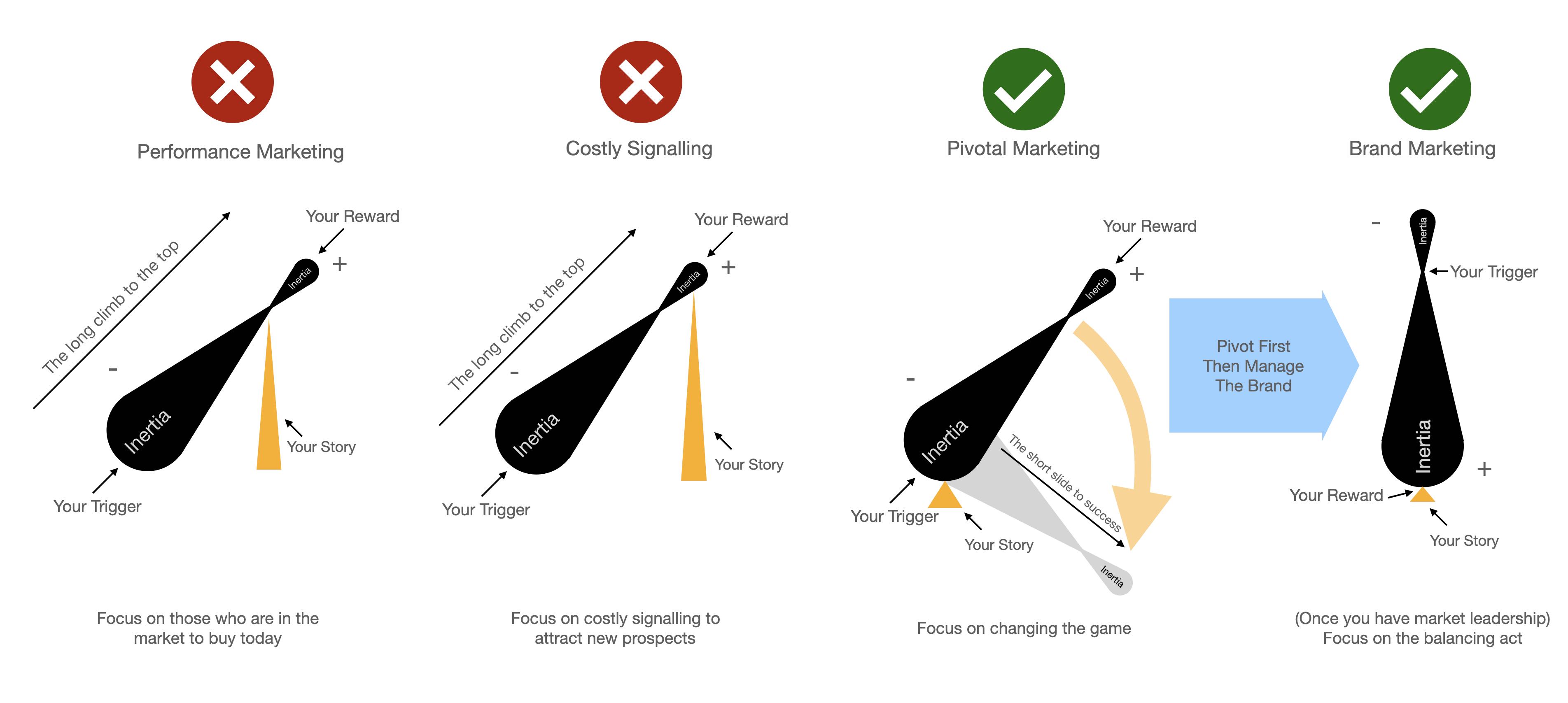
The trick is knowing where to position your story, your trigger and your reward so you can tip the market in your favour
... and almost inevitably this means shifting the story away from where the brand and the transaction takes place to where the customer begins their journey
The emphasis being on stories that nudge the prospect to take short steps towards tipping the 'Egg Timer' over
Understand this and you'll see that endless thread on the phase changes was never about trying to out think, the way marketers think, about how the customer thinks, they think, about thinking, when it comes to thinking, about thinking, about brands
It was simply about discovering a new way to tip the balance of power in your favour
The Case Study
After posting this it became obvious that it lacked a case study
The obvious case study is ChatGPT... because it is front of mind at this time
So let's take a stab at mapping ChatGPT to the model
But before I do I want to introduce some key ideas to the model
These are the Anchor, FOMO and the Zeitgeist
The anchor becomes a substitute for the story
As to the question why? I'll refer you to something I wrote a year ago on What Bitcoin can teach us about marketing?
But basically it comes down to the idea you can move the anchor to change the story
This adjusted model is a merging of the Phase Changes with some core ideas about marketing (e.g. Anchors, Extrinsic Value, Scarcity and Social Proofs)
FOMO is of course the ultimate reward
The social proof is the trigger - I do it because they do it...
As you can see the model now describes how earlier versions of AI (ThinK: Watson & AlphaGo) positioned themselves using costly signalling
Meanwhile ChatGPT moved the anchor to pivot the Zeitgeist - Just like Facebook, Snapchat, TikTok etc had done a generation before with Social Media
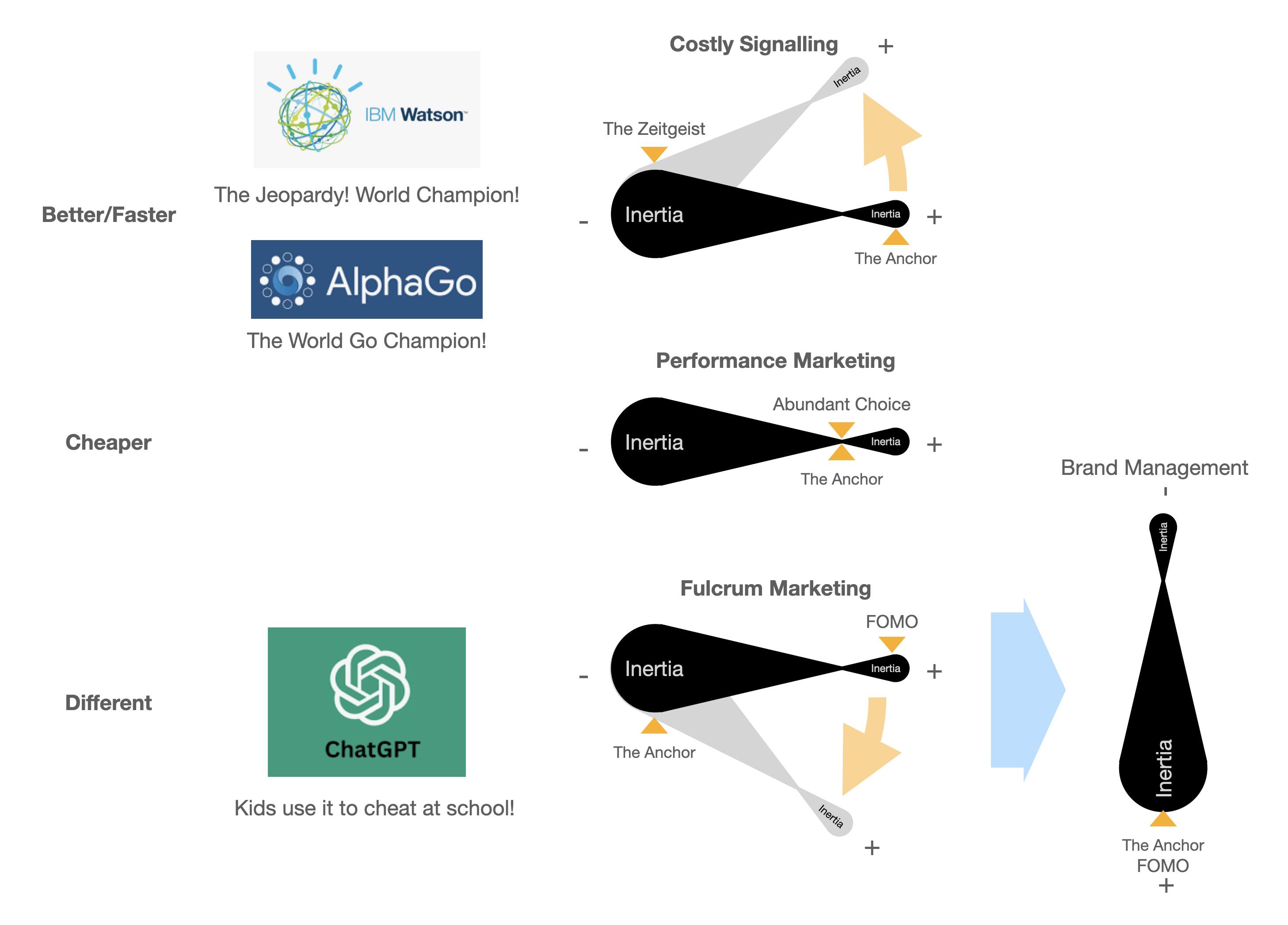
What makes the ChatGPT case study more compelling is it took up until version 3.5 of the product to make the switch in strategy. Up until then it had followed the 'Better/Faster" pitch and gone nowhere in attracting market share
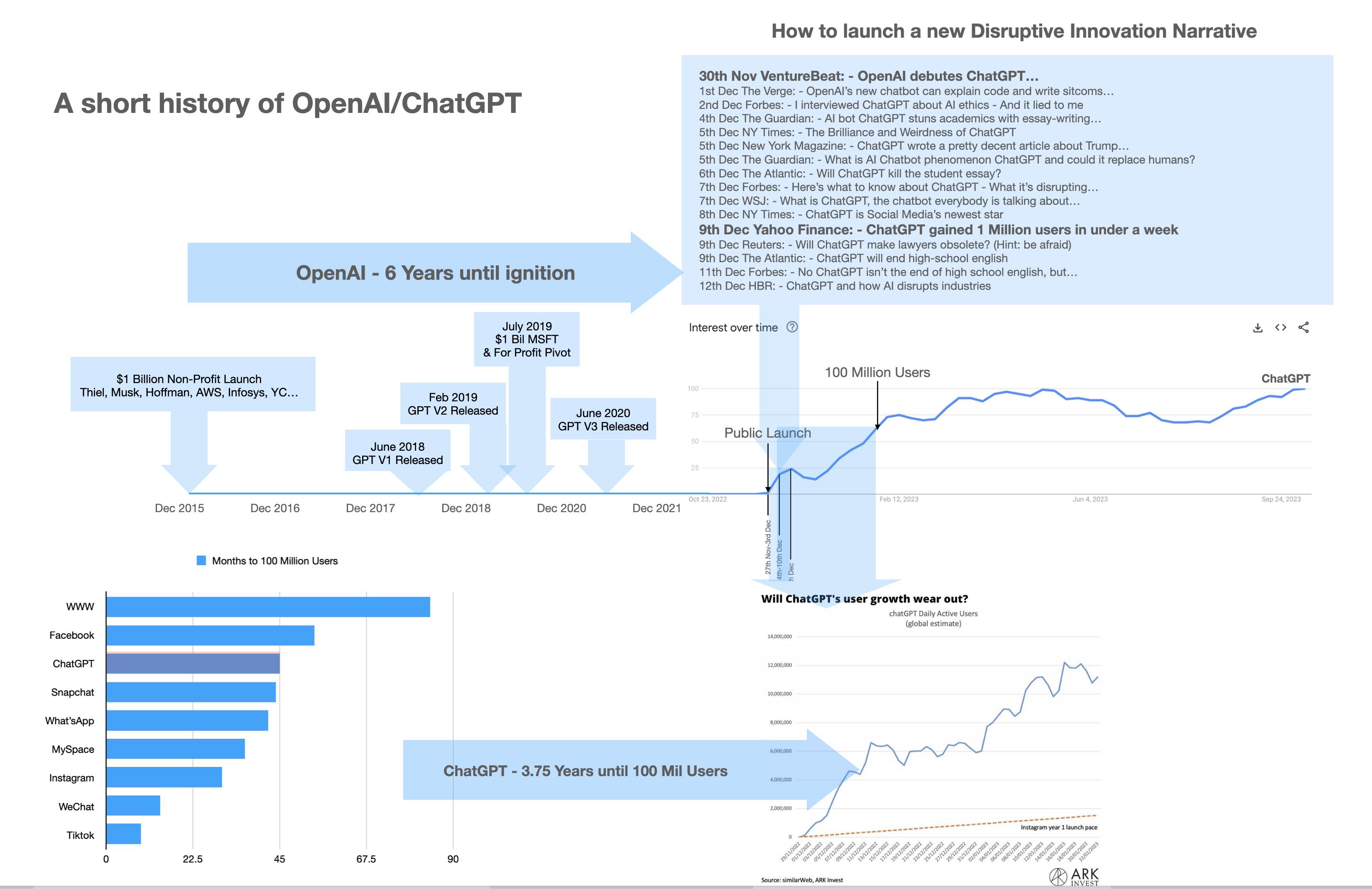
Closing Thoughts?
I guess I subscribe to the mantra all models are useful until they are not
In the context of sales and marketing, new models are useful because they encourage a new way of thinking
and only by encountering a new way of thinking can we begin to experiment with a new way of doing
The fulcrum model is about demonstrating the balance of power resides with the prospect. Your task is to motivate them to take those small steps that can disrupt the equilibrium of the model at rest... the good news is there are many, many creative ways to do that
Phase 9: The 5 P's of Changing Phases
Product, Promotion, Price, Place and Phase
Perhaps the greatest misunderstanding in marketing is the idea marketing = advertising
In truth you can have a bad marketing strategy supported a great advertising campaign and the results will be open to question
The optimal plan is to have a great marketing strategy supported by a great advertising campaign
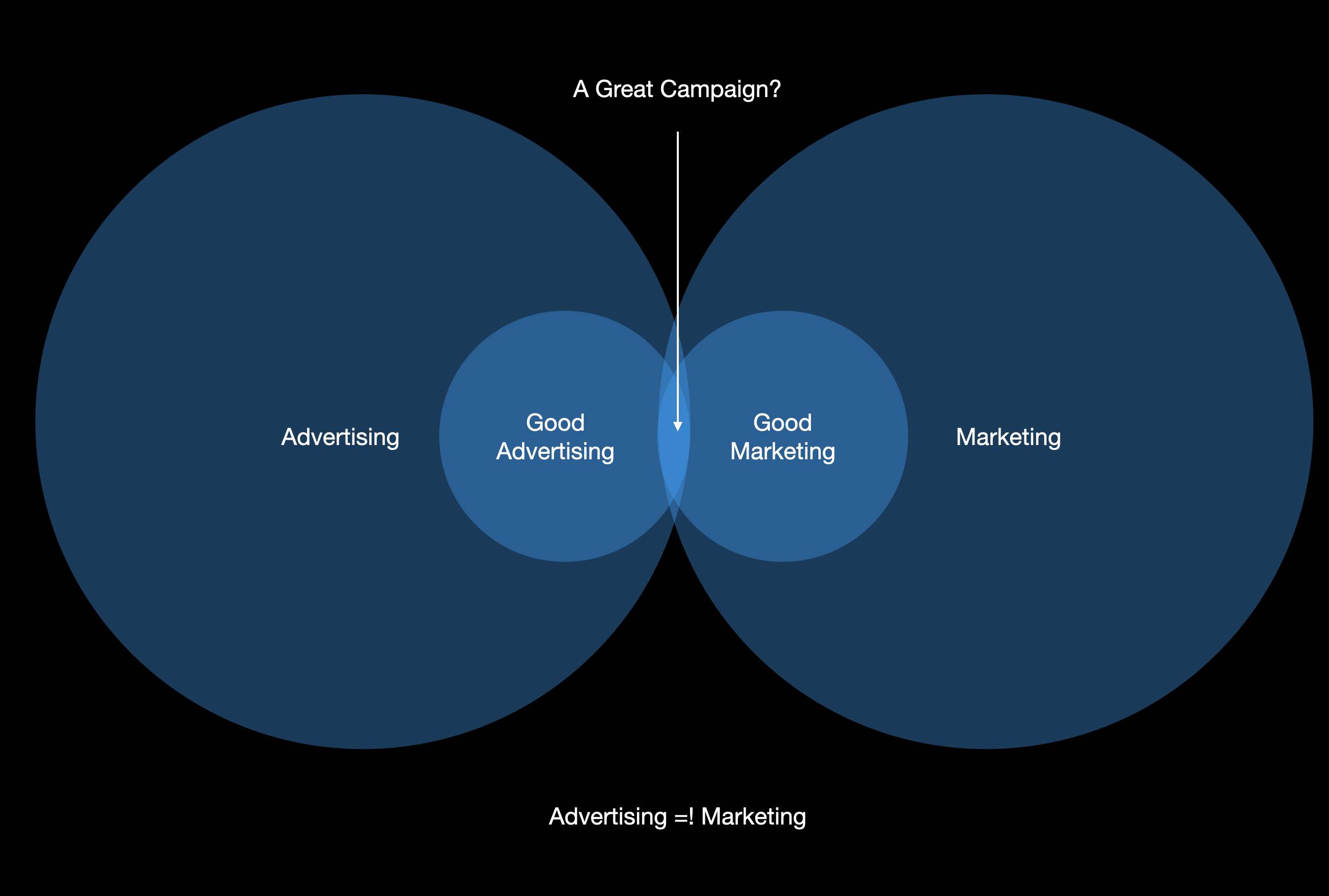
and this takes us back to the 4 P's of marketing
The recognition that promotion is only one part of the marketing puzzle
You need to get the other 3 right if the strategy is to work

What the phase changers have taught us is there is another dimension to the 4 P's
A 5th P... the market phase
You can have the best price, promotion, place and product in the world... but if the market is out of phase you will struggle to make sales
Aand this is why arguably the market phase is the most important of the 5 P's
Moving markets into phase is complex and (most of the time) expensive work
Just how do you generate demand in the absence of demand?
How do you move buyers into a vacuum?

and here is the great insight
The overwhelming majority of marketing strategies fail because 1 or more of the other 4 P's are out of Phase with the market.
More so perhaps than when they are misaligned with the other P's of the marketing strategy
For example the market may be in phase but your product, price, place or prmotion is wrong

and it is self evident from this insight that the number of absolute winners capable of bringing all these pieces of the jigsaw together at the right time is a very small percentage of the market
They are the outliers
And the marketeers who comprehend and manage this level of complexity are themselves the outliers in a market flooded with talent
For the most part the winners just get lucky... there is very little art or science behind their plans and schemes to generate demand
A rare few however are capable of shaping the future
Hopefully having read this far you'll have gleaned enough about the power of the phase changers to become one of them
